Microsoft RM-128 Quad band GSM, US Dual band WCDMA, BT, Smart phone User Manual R1114 en
Microsoft Mobile Oy Quad band GSM, US Dual band WCDMA, BT, Smart phone R1114 en
Contents
- 1. Manual 1
- 2. Manual 2
Manual 1
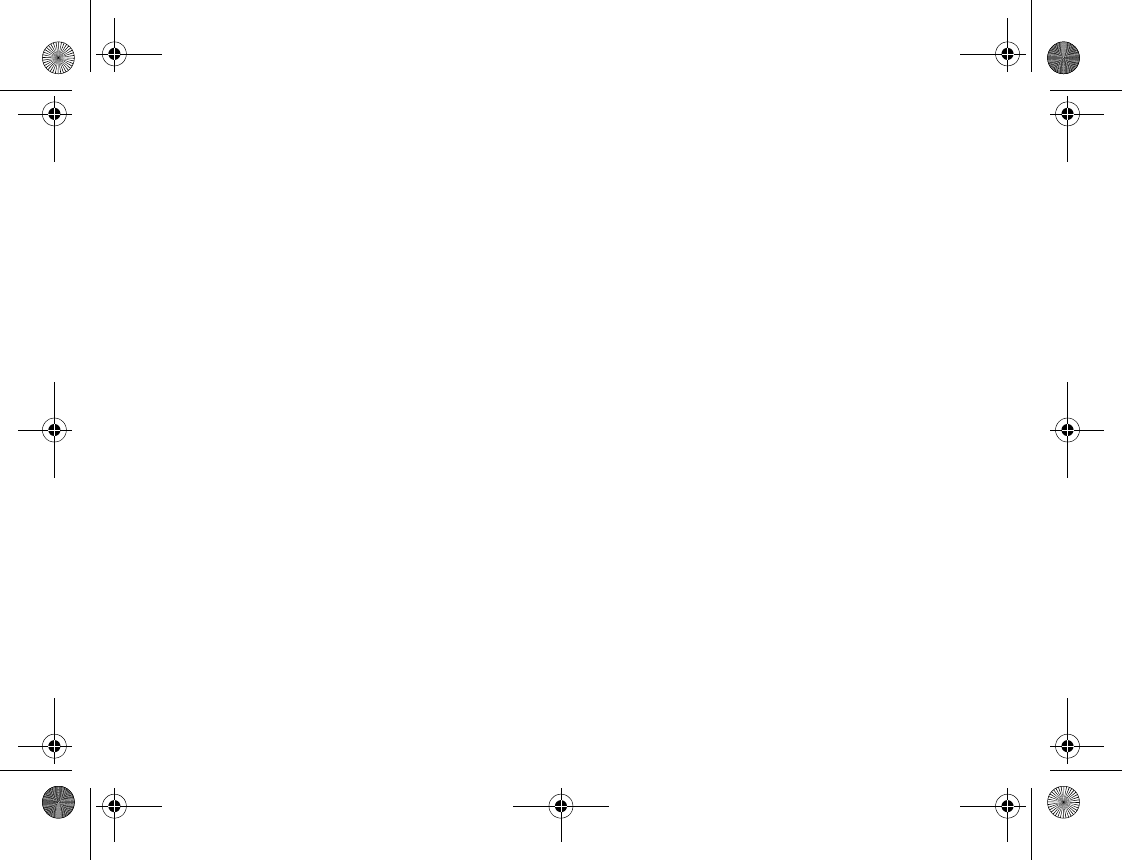
Nokia N75 User Guide
9252943
ISSUE 1 EN
R1114_en.book Page 1 Thursday, October 19, 2006 3:43 PM
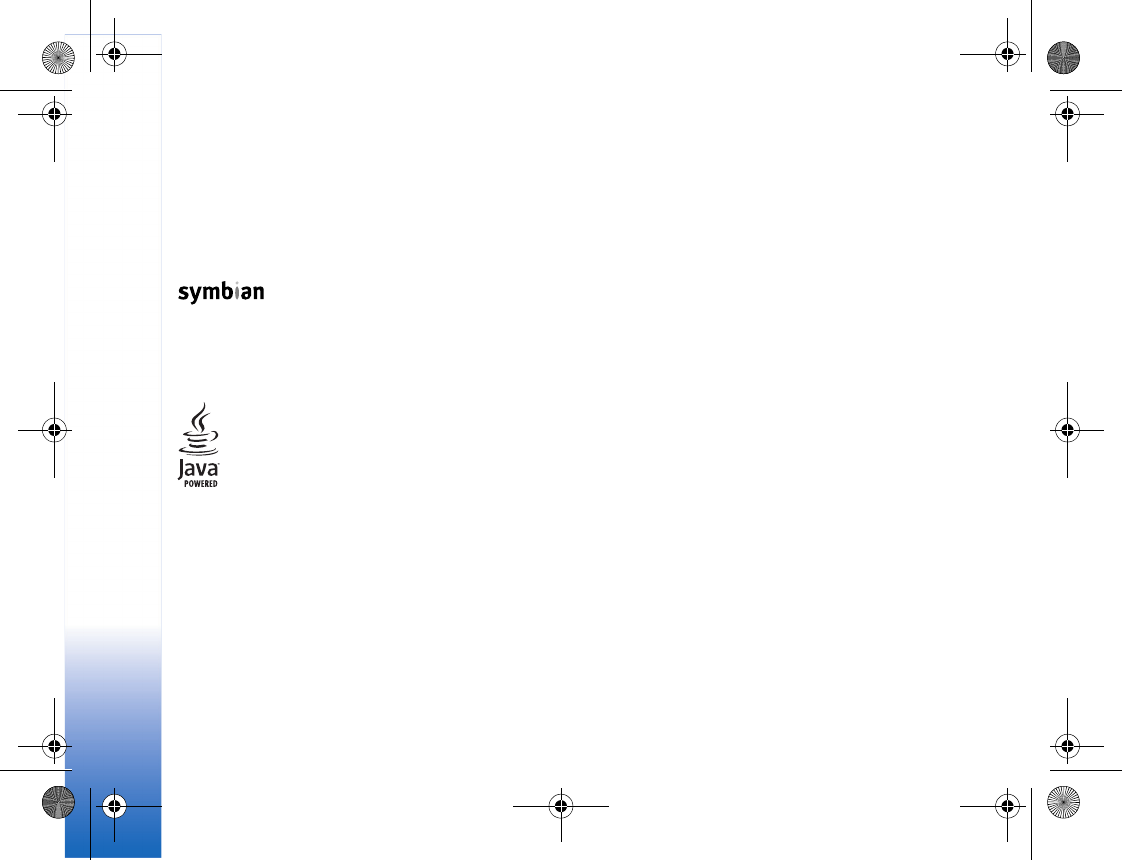
© 2006 Nokia. All rights reserved.
Nokia, Nokia Connecting People, Xpress-on, and Pop-Port are trademarks or
registered trademarks of Nokia Corporation. Nokia tune is a sound mark of Nokia
Corporation. Other product and company names mentioned herein may be
trademarks or tradenames of their respective owners.
Reproduction, transfer, distribution, or storage of part or all of the contents in this
document in any form without the prior written permission of Nokia is prohibited.
This product includes software licensed from Symbian Software Ltd (c)
1998-200(6). Symbian and Symbian OS are trademarks of Symbian Ltd.
US Patent No 5818437 and other pending patents. T9 text input software
Copyright (C) 1997-2006. Tegic Communications, Inc. All rights reserved.
Java™ and all Java-based marks are trademarks or registered trademarks of Sun
Microsystems, Inc.
This product is licensed under the MPEG-4 Visual Patent Portfolio License (i) for
personal and noncommercial use in connection with information which has been
encoded in compliance with the MPEG-4 Visual Standard by a consumer engaged
in a personal and noncommercial activity and (ii) for use in connection with
MPEG-4 video provided by a licensed video provider. No license is granted or shall
be implied for any other use. Additional information, including that related to
promotional, internal, and commercial uses, may be obtained from MPEG LA, LLC.
See <http://www.mpegla.com>.
Nokia operates a policy of ongoing development. Nokia reserves the right to make
changes and improvements to any of the products described in this document
without prior notice.
TO THE MAXIMUM EXTENT PERMITTED BY APPLICABLE LAW, UNDER NO
CIRCUMSTANCES SHALL NOKIA OR ANY OF ITS LICENSORS BE RESPONSIBLE FOR
ANY LOSS OF DATA OR INCOME OR ANY SPECIAL, INCIDENTAL, CONSEQUENTIAL
OR INDIRECT DAMAGES HOWSOEVER CAUSED.
THE CONTENTS OF THIS DOCUMENT ARE PROVIDED "AS IS". EXCEPT AS REQUIRED
BY APPLICABLE LAW, NO WARRANTIES OF ANY KIND, EITHER EXPRESS OR IMPLIED,
INCLUDING, BUT NOT LIMITED TO, THE IMPLIED WARRANTIES OF
MERCHANTABILITY AND FITNESS FOR A PARTICULAR PURPOSE, ARE MADE IN
RELATION TO THE ACCURACY, RELIABILITY OR CONTENTS OF THIS DOCUMENT.
NOKIA RESERVES THE RIGHT TO REVISE THIS DOCUMENT OR WITHDRAW IT AT ANY
TIME WITHOUT PRIOR NOTICE.
The availability of particular products and applications for these products may vary
by region. Please check with your Nokia dealer for details, and availability of
language options.
Export controls
This device may contain commodities, technology or software subject to export
laws and regulations from the US and other countries. Diversion contrary to law is
prohibited.
FCC / INDUSTRY CANADA NOTICE
Your device may cause TV or radio interference (for example, when using a
telephone in close proximity to receiving equipment). The FCC or Industry Canada
can require you to stop using your telephone if such interference cannot be
eliminated. If you require assistance, contact your local service facility. This device
complies with part 15 of the FCC rules. Operation is subject to the following two
conditions: (1) This device may not cause harmful interference, and (2) this device
must accept any interference received, including interference that may cause
undesired operation. Any changes or modifications not expressly approved by Nokia
could void the user's authority to operate this equipment.
Issue 1 EN, 9252943
R1114_en.book Page 2 Thursday, October 19, 2006 3:43 PM
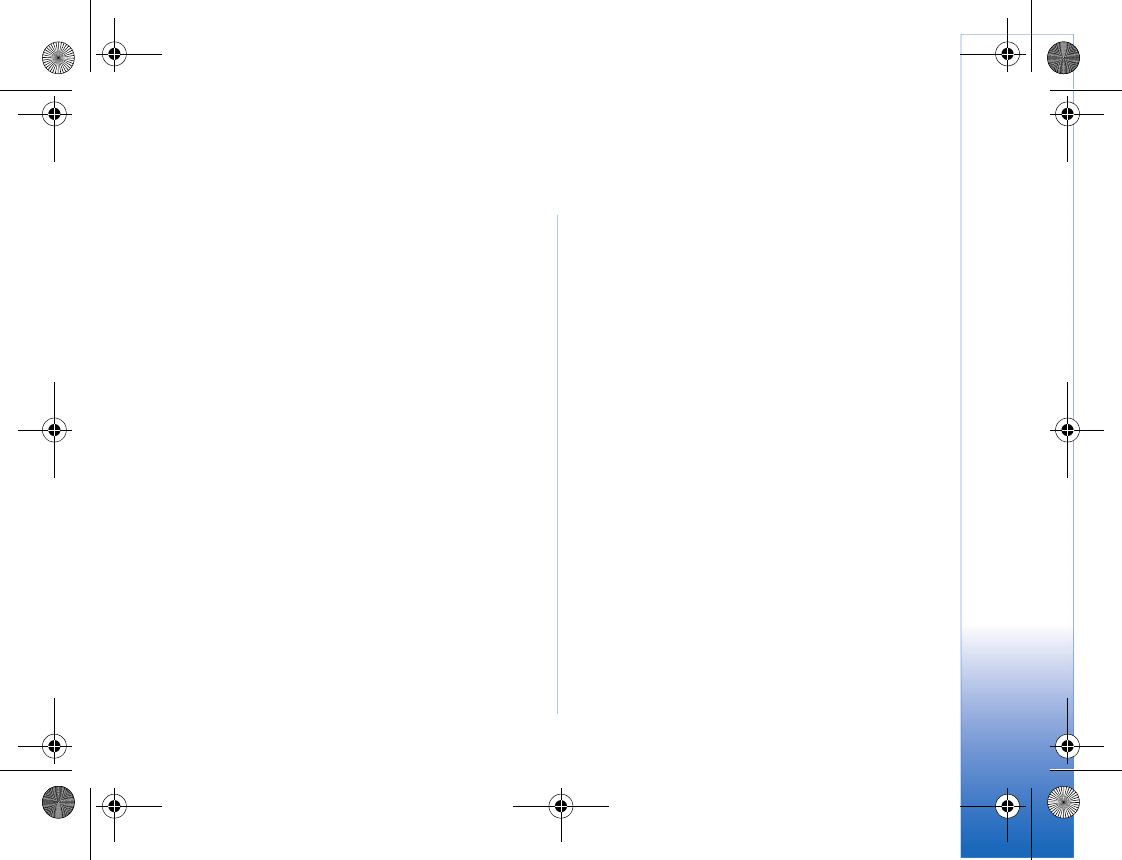
Contents
Contents
For your safety...........................................8
Get connected......................................... 11
Welcome.................................................. 12
Accessibility solutions........................................................12
Find information about your device...............................12
Contact your service provider..........................................12
Your Nokia device................................... 13
Keys and parts (fold open)................................................13
Keys and parts (fold closed, front, back and sides)....14
Insert the SmartChip card and battery .........................15
Switch the device on..........................................................15
Modes .....................................................................................16
Fold closed mode .........................................................16
Fold open mode............................................................17
Essential indicators.............................................................18
Useful shortcuts...................................................................18
Idle mode .......................................................................19
Edit text and lists.........................................................19
Keypad lock (keyguard)......................................................19
Volume and loudspeaker control ....................................20
Headset ..................................................................................20
Clock .......................................................................................21
Clock settings ...............................................................21
World clock ...................................................................21
Wrist strap ............................................................................22
Settings..................................................................................22
Memory card ........................................................................22
Memory card tool........................................................23
File manager.........................................................................23
View memory consumption......................................24
Memory low—free memory.......................................24
Music key...............................................................................25
Mode key ...............................................................................25
Transfer content from another device ..........................25
Support .....................................................27
Nokia support and contact information.......................27
Help.........................................................................................27
Tutorial...................................................................................27
Camera......................................................28
Take pictures.........................................................................28
Still image camera indicators..................................29
R1114_en.book Page 3 Thursday, October 19, 2006 3:43 PM
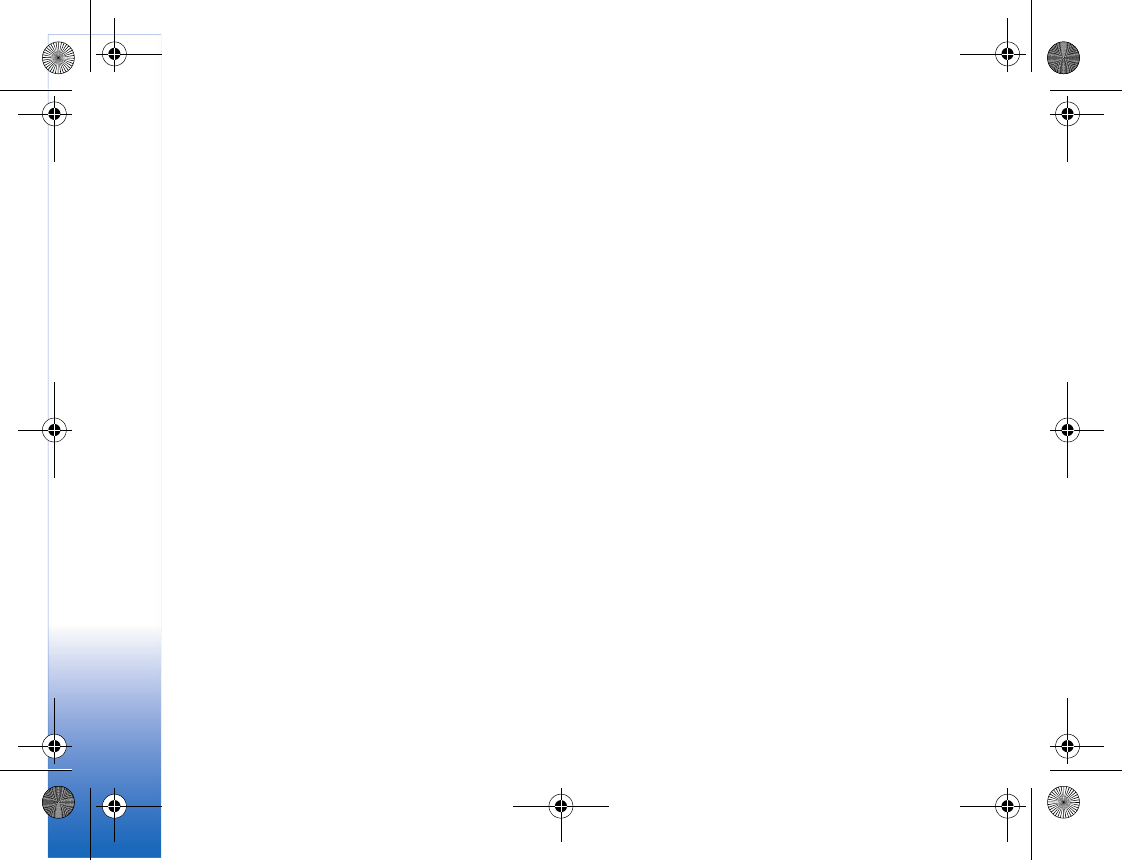
Contents
4
Active toolbar............................................................... 29
After taking a picture................................................. 30
Still image camera settings...................................... 31
Flash................................................................................ 31
Adjust color and lighting .......................................... 32
Scenes............................................................................. 32
Take pictures in a sequence............................................. 33
You in the picture—self-timer......................................... 33
Record videos.......................................................................33
Video capture indicators ........................................... 34
After recording a video.............................................. 34
Video settings............................................................... 35
Cingular Music.........................................36
Music player......................................................................... 36
Play music .....................................................................36
Random and repeat play........................................... 37
Playlists .......................................................................... 37
Visualizations ............................................................... 39
Modify audio ................................................................ 39
Rename items............................................................... 39
Set a song as a ringing tone .................................... 39
Add music......................................................................40
Music ID ...............................................................................41
MobiRadio............................................................................. 41
Shop Music ........................................................................... 41
Shop settings................................................................42
Music Video .......................................................................... 42
Billboard ................................................................................ 42
Community ........................................................................... 43
Music Apps............................................................................43
Digital Rights Management............................................. 43
Cingular Video .........................................44
Cingular Mall ...........................................45
My Stuff...................................................46
View and browse files........................................................ 46
Images and video clips...............................................46
Active toolbar............................................................... 47
Shrink.............................................................................. 48
Print images.................................................................. 48
Albums ................................................................................... 49
Edit images ...........................................................................50
Crop image....................................................................50
Reduce red eye............................................................. 50
Shortcuts ....................................................................... 50
Edit video clips..................................................................... 50
Add images, video, audio, and text ........................ 51
Cut video clip................................................................51
Send videos ...................................................................51
R1114_en.book Page 4 Thursday, October 19, 2006 3:43 PM
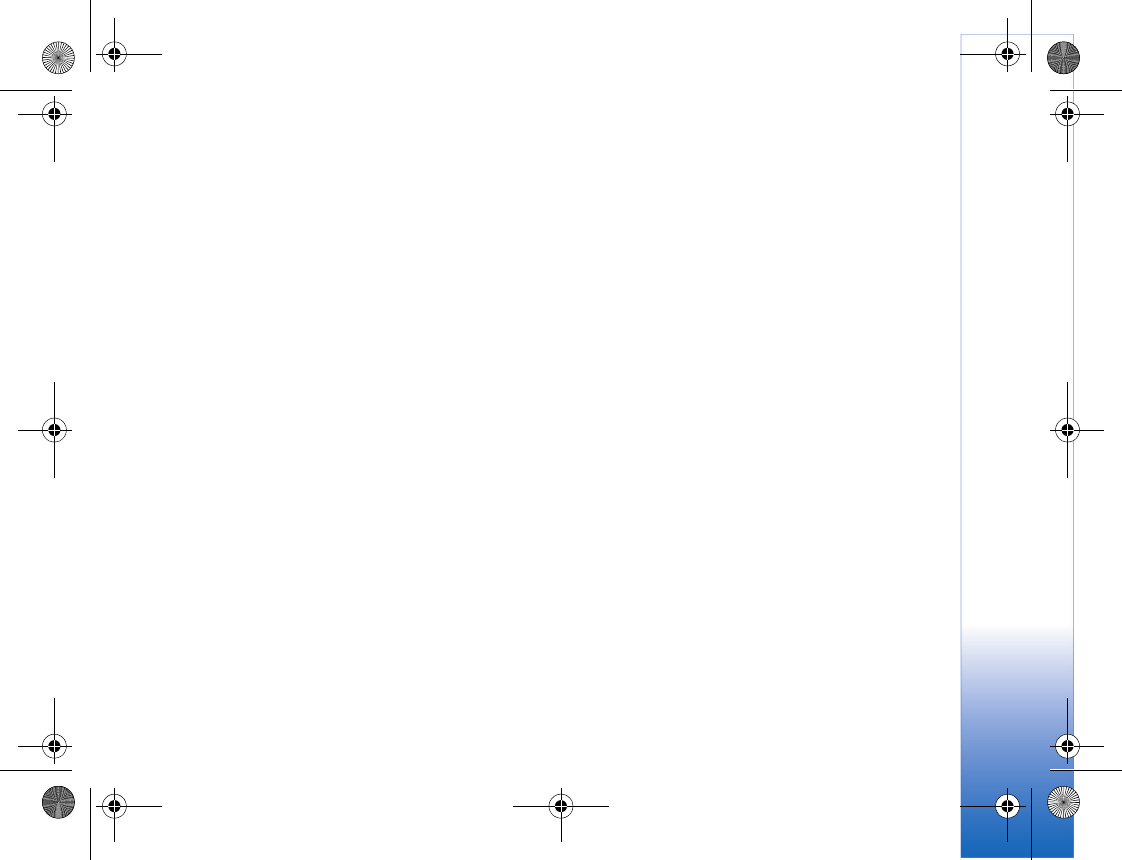
Contents
5
Movie director......................................................................52
Create muvees ..............................................................52
Create a custom muvee .............................................52
Slide show .............................................................................53
Presentations........................................................................53
Messaging................................................ 55
Write text ..............................................................................56
Traditional text input..................................................56
Predictive text input ...................................................56
Tips on text input.........................................................57
Write and send messages..................................................58
Write and send postcards..........................................59
Receive MMS and e-mail settings..........................60
Inbox—receive messages ...................................................60
Multimedia messages.................................................61
Data and settings.........................................................61
Web service messages................................................61
Mailbox...................................................................................62
Open the mailbox ........................................................62
Retrieve e-mail messages..........................................62
Delete e-mail messages.............................................63
Disconnect from the mailbox...................................64
View messages on a SmartChip card.............................64
Messaging settings .............................................................64
Text messages...............................................................64
Multimedia messages.................................................65
E-mail .............................................................................66
Web service messages................................................67
Cell broadcast...............................................................68
Other settings...............................................................68
Message reader....................................................................68
Address book ...........................................69
Contact cards .......................................................................69
Default numbers and addresses ..............................70
Contact groups ....................................................................70
Add ringing tones for addresses .....................................70
Copy contacts.......................................................................71
SChip directory and other SmartChip services ... 71
Make calls ................................................72
Voice calls .............................................................................72
Make a conference call..............................................72
1-touch dial a phone number..................................73
Voice dialing .................................................................73
Answer or decline a call....................................................74
Call waiting...................................................................74
Options during a voice call.......................................74
Log ..........................................................................................75
Call time.........................................................................75
Data counter.................................................................75
R1114_en.book Page 5 Thursday, October 19, 2006 3:43 PM
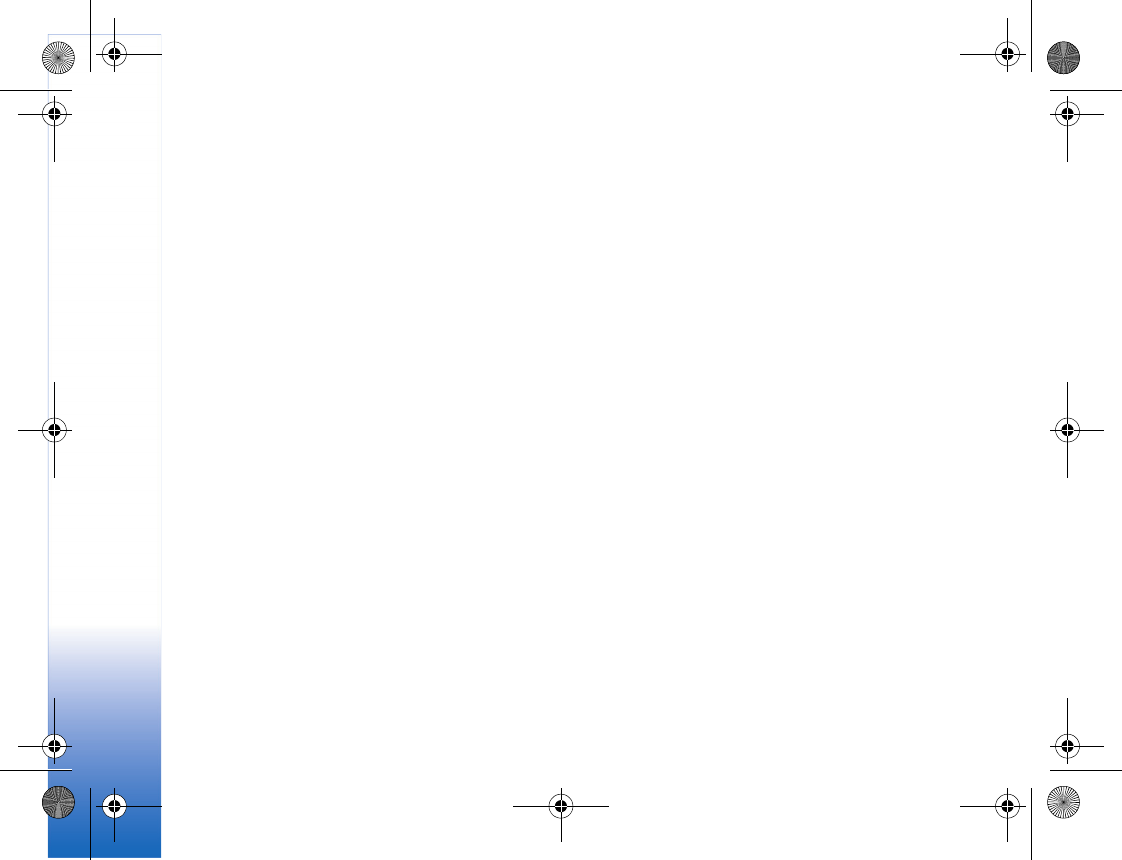
Contents
6
Monitor all communication events........................ 76
MEdia Net ................................................78
Access point.......................................................................... 78
Bookmarks view................................................................... 78
Connection security ...........................................................79
Browse.................................................................................... 79
Download and purchase items........................................ 80
End a connection ................................................................ 80
Empty the cache.......................................................... 80
Settings.................................................................................. 81
Calendar....................................................82
Create calendar entries.....................................................82
Calendar views..................................................................... 82
Manage your calendar entries ........................................ 83
Games&Apps ............................................84
Games..................................................................................... 84
MobiTV ................................................................................... 84
Instant Messaging & Email.....................85
Instant messaging............................................................... 85
Receive IM settings ....................................................85
Connect to an IM server............................................ 85
Modify your IM settings............................................ 85
Search for IM groups and users .............................. 86
Join IM groups ............................................................. 86
Instant messaging.......................................................86
View and start conversations...................................87
IM contacts...................................................................87
IM server settings........................................................87
Mobile email......................................................................... 88
Tools..........................................................89
Web......................................................................................... 89
Calculator.............................................................................. 89
Converter............................................................................... 89
Set base currency and exchange rates..................90
Notes ...................................................................................... 90
Recorder................................................................................. 90
RealPlayer.............................................................................. 90
Play video clips.............................................................91
Shortcuts during play................................................. 91
Stream content over the air..................................... 91
Receive RealPlayer settings...................................... 91
Flash Player...........................................................................92
Play flash files..............................................................92
Organize flash files .....................................................93
Radio....................................................................................... 93
Listen to the radio.......................................................93
Saved stations.............................................................. 94
Settings .......................................................................... 94
R1114_en.book Page 6 Thursday, October 19, 2006 3:43 PM
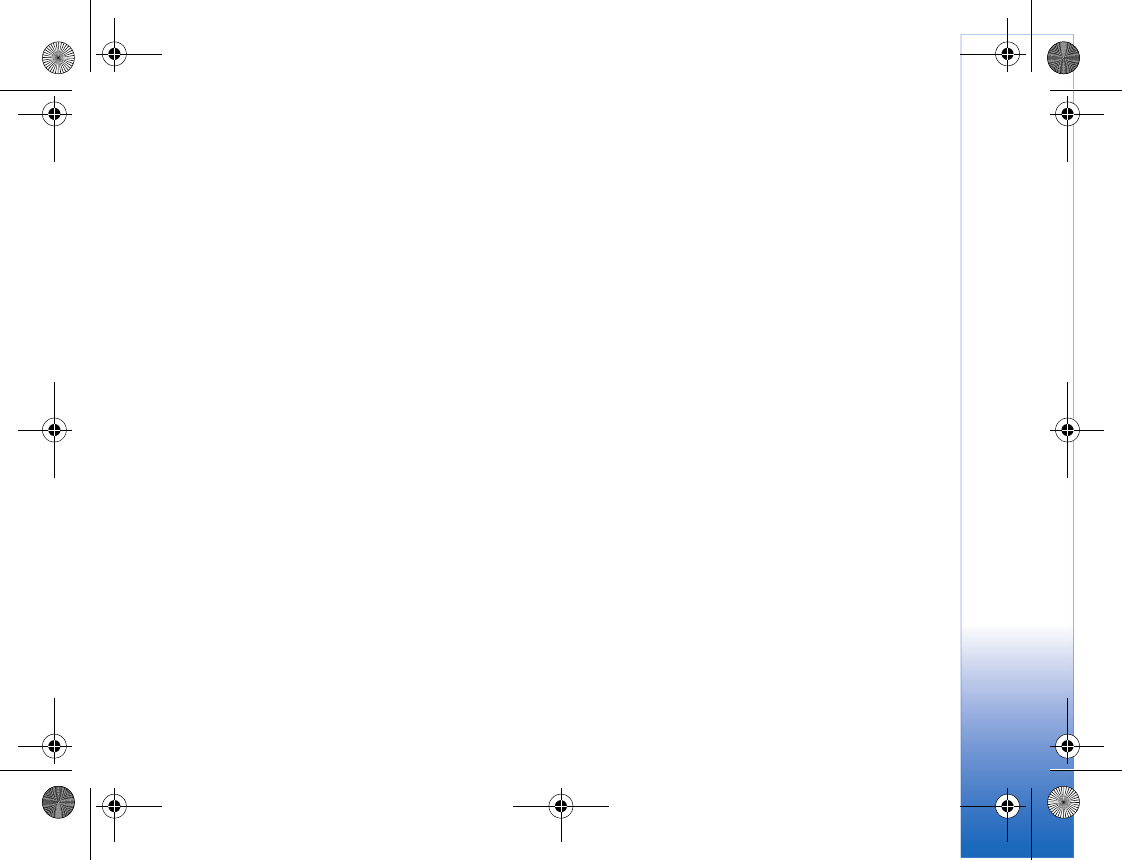
Contents
7
Personalize your device .......................... 95
Profiles—set tones...............................................................95
3-D tones .......................................................................96
Offline profile................................................................96
Change the look of your device.......................................97
Active idle mode..................................................................97
Settings.................................................... 99
Config. ....................................................................................99
Phone ..............................................................................99
Call config................................................................... 101
Connection ................................................................. 102
Date and time............................................................ 104
Security........................................................................ 104
Call forwarding.......................................................... 107
Call restriction .......................................................... 107
Network....................................................................... 107
Enhancement ............................................................. 108
Voice commands............................................................... 108
Voice aid.............................................................................. 109
Application manager ....................................................... 109
Install applications and software......................... 110
Remove applications and software ..................... 111
Settings........................................................................ 111
Speech ................................................................................. 111
Bluetooth connectivity....................................................112
Settings ........................................................................113
Send data using Bluetooth connectivity ............114
Pair devices .................................................................114
Receive data using Bluetooth connectivity .......115
Switch off Bluetooth connectivity .......................115
Infrared connection..........................................................115
Data cable ...........................................................................116
PC connections ..................................................................117
Connection manager........................................................117
Data connections.......................................................117
Synchronization.................................................................117
Synchronize data.......................................................118
Device manager.................................................................118
Server profile settings..............................................118
Troubleshooting: Q&A.......................... 121
Enhancements....................................... 124
Battery information ............................. 126
Charging and discharging...............................................126
Nokia battery authentication guidelines....................127
Care and maintenance ......................... 129
Additional safety information............. 130
R1114_en.book Page 7 Thursday, October 19, 2006 3:43 PM
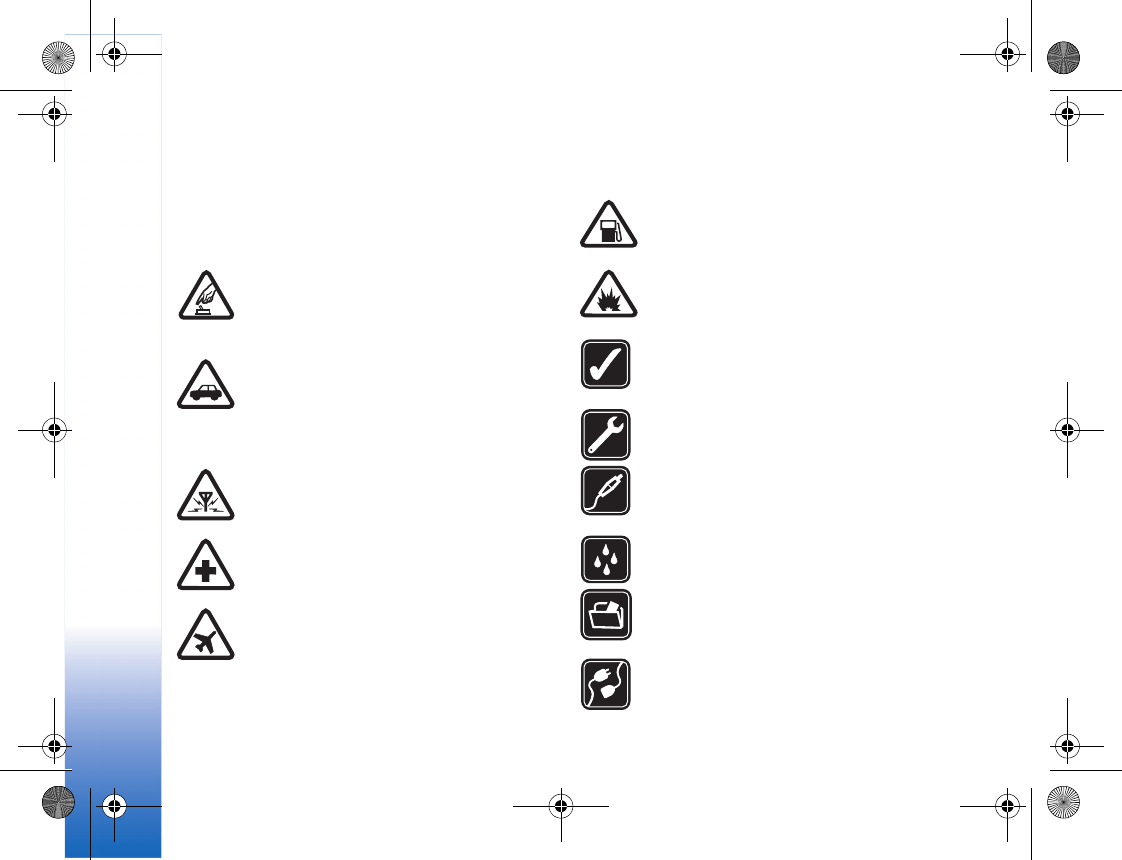
8
For your safety
Read these simple guidelines. Not following them may be
dangerous or illegal. Read the complete user guide for
further information.
SWITCH ON SAFELY Do not switch the
device on when wireless phone use is
prohibited or when it may cause interference
or danger.
ROAD SAFETY COMES FIRST Obey all local
laws. Always keep your hands free to operate
the vehicle while driving. Your first
consideration while driving should be road
safety.
INTERFERENCE All wireless devices may be
susceptible to interference, which could affect
performance.
SWITCH OFF IN HOSPITALS Follow any
restrictions. Switch the device off near
medical equipment.
SWITCH OFF IN AIRCRAFT Follow any
restrictions. Wireless devices can cause
interference in aircraft.
SWITCH OFF WHEN REFUELING Do not use
the device at a refueling point. Do not use near
fuel or chemicals.
SWITCH OFF NEAR BLASTING Follow any
restrictions. Do not use the device where
blasting is in progress.
USE SENSIBLY Use only in the normal position
as explained in the product documentation. Do
not touch the antenna unnecessarily.
QUALIFIED SERVICE Only qualified personnel
may install or repair this product.
ENHANCEMENTS AND BATTERIES Use only
approved enhancements and batteries. Do not
connect incompatible products.
WATER-RESISTANCE Your device is not
water-resistant. Keep it dry.
BACK-UP COPIES Remember to make back-up
copies or keep a written record of all important
information.
CONNECTING TO OTHER DEVICES When
connecting to any other device, read its user
R1114_en.book Page 8 Thursday, October 19, 2006 3:43 PM
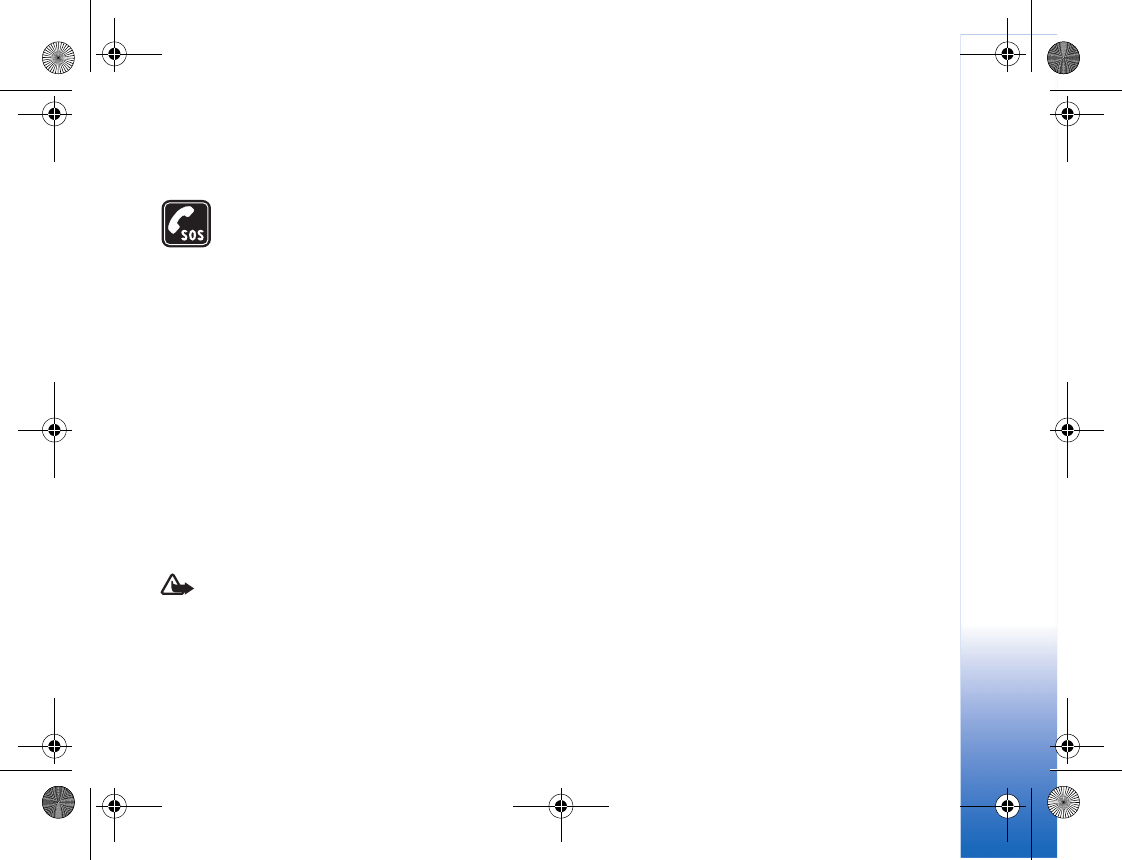
9
guide for detailed safety instructions. Do not
connect incompatible products.
EMERGENCY CALLS Ensure the phone
function of the device is switched on and in
service. Press the end key as many times as
needed to clear the display and return to the
start screen. Enter the emergency number,
then press the call key. Give your location. Do
not end the call until given permission to do so.
About your device
The wireless device described in this guide is approved for
use on the EGSM 850, 900, 1800, 1900, and UMTS 850 and
1900 networks. Contact your service provider for more
information about networks.
When taking and using images, video clips or other
features, obey all laws, and respect local customs as well
as privacy and legitimate rights of others, including
copyright.
Warning: To use any features in this device, other
than the alarm clock, the device must be switched on.
Do not switch the device on when wireless device use
may cause interference or danger.
The Quickoffice applications in your device support
common features of Microsoft Word, PowerPoint, and
Excel (Microsoft Office 2000, XP, and 2003). Not all file
formats can be viewed or modified.
Network services
To use the phone you must have service from a wireless
service provider. Many of the features in this device
depend on features in the wireless network to function.
These network services may not be available on all
networks or you may have to make specific arrangements
with your service provider before you can utilize network
services. Your service provider may need to give you
additional instructions for their use and explain what
charges will apply. Some networks may have limitations
that affect how you can use network services. For
instance, some networks may not support all
language-dependent characters and services.
Your service provider may have requested that certain
features be disabled or not activated in your device. If so,
they will not appear on your device menu. Your device may
also have been specially configured. This configuration
may include changes in menu names, menu order, and
icons. Contact your service provider for more information.
This device supports WAP 2.0 protocols (HTTP and SSL)
that run on TCP/IP protocols. Some features of this device,
such as MMS, browsing, e-mail, and content downloading
R1114_en.book Page 9 Thursday, October 19, 2006 3:43 PM
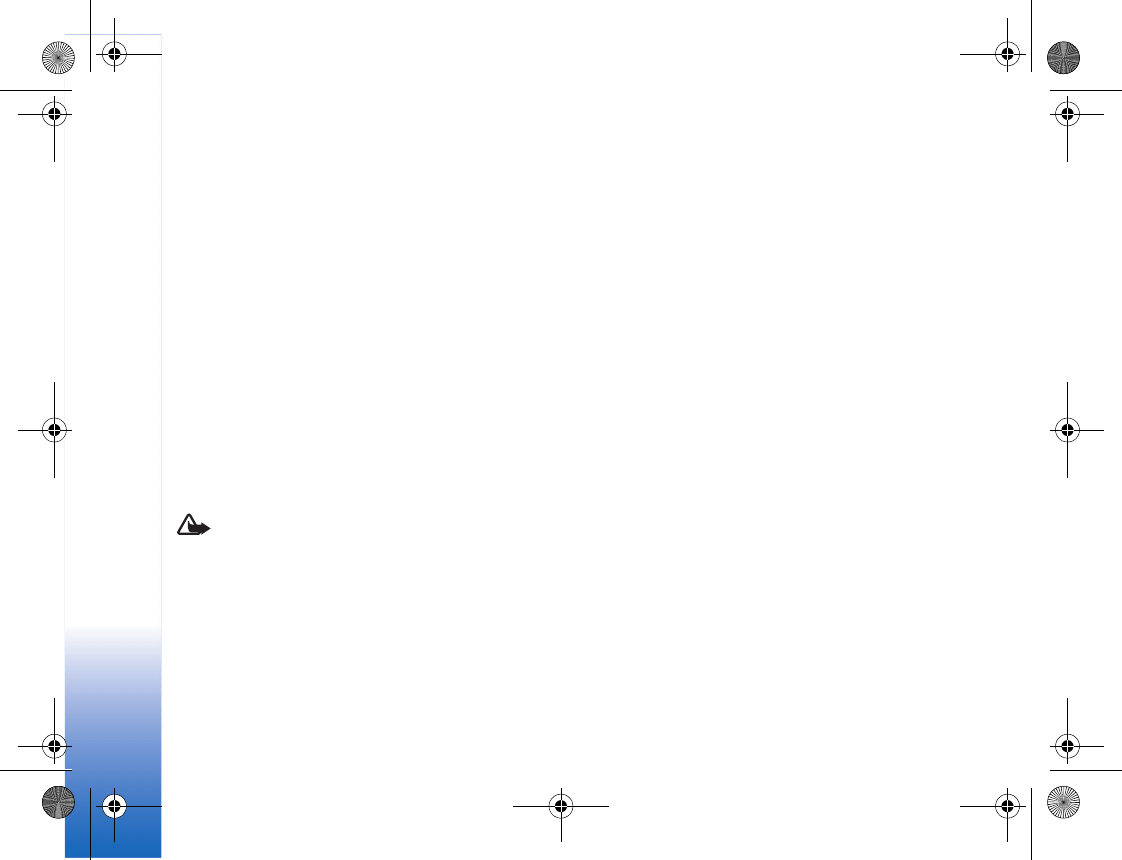
10
using the browser or over MMS, require network support
for these technologies.
For availability and information on using SmartChip
services, contact your service provider.
Enhancements, batteries, and
chargers
Always switch the device off, and disconnect the charger
before removing the battery.
Check the model number of any charger before use with
this device. This device is intended for use when supplied
with power from an AC-3, AC-4, or AC-5 charger and from
an AC-1, ACP-8, ACP-12, LCH-9, or LCH-12 charger when
used with the CA-44 charger adapter.
The battery intended for use with this device is BL-5BT.
Warning: Use only batteries, chargers, and
enhancements approved by Nokia for use with this
particular model. The use of any other types may
invalidate any approval or warranty and may be
dangerous.
For availability of approved enhancements, please check
with your dealer. When you disconnect the power cord of
any enhancement, grasp and pull the plug, not the cord.
R1114_en.book Page 10 Thursday, October 19, 2006 3:43 PM
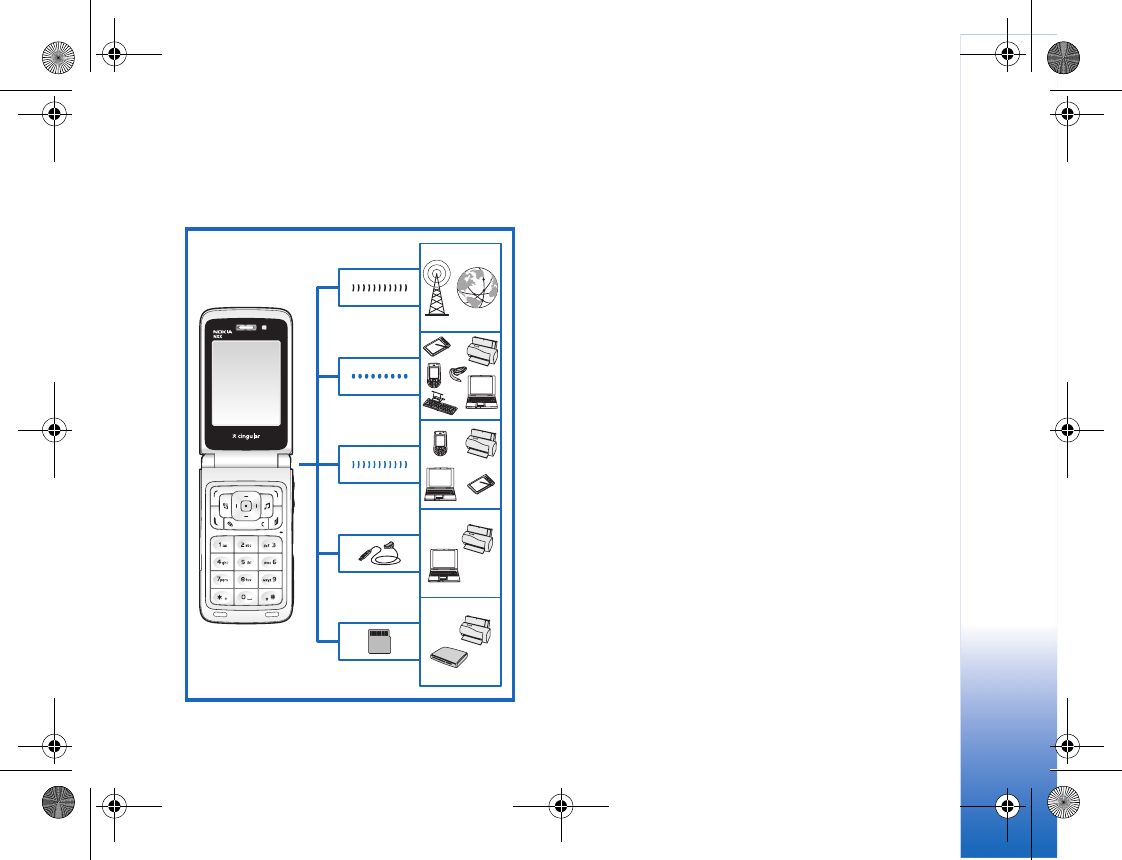
Get connected
11
Get connected
Use your device on the 2G and 3G networks. See "Your
Nokia device," p.13
Use Bluetooth technology, for example, to transfer files
and connect to compatible enhancements. See "Bluetooth
connectivity," p. 112.
Use infrared to transfer and synchronize data between
compatible devices, for example. See "Infrared
connection," p. 115.
Use Nokia Connectivity Cable CA-53 to connect to
compatible devices, such as printers and PCs. See "Data
cable," p. 116.
Use a microSD card to transfer data or back up
information, for example. See "Memory card tool," p. 23.
R1114_en.book Page 11 Thursday, October 19, 2006 3:43 PM
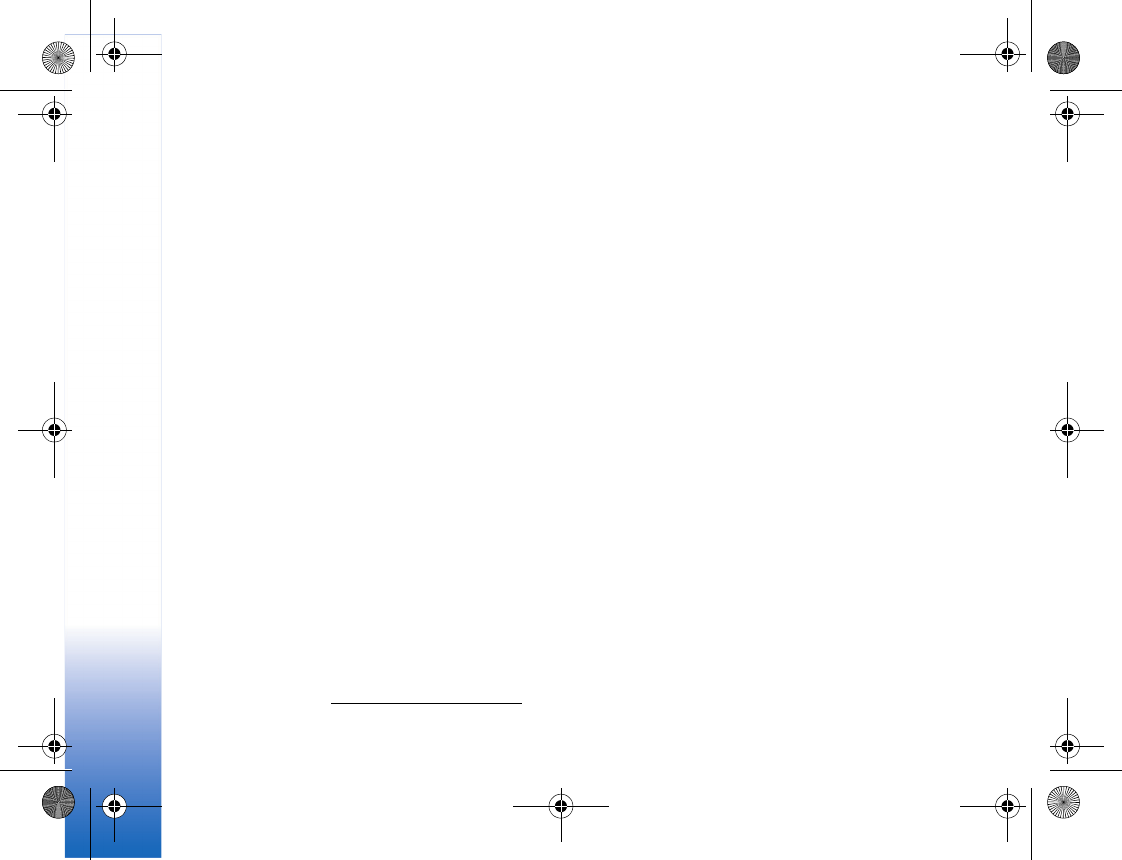
Welcome
12
Welcome
Congratulations on your purchase of this Nokia device.
Your device provides many functions that are practical for
daily use, such as a calendar, a clock, an alarm clock, a
radio, and a built-in camera. Use the camera for recording
video clips and taking pictures that you can, for example,
attach as a wallpaper in the idle mode. See "Camera,"
p. 28.
You can customize your device with ringing tones and
themes. See "Personalize your device," p. 95.
Other features on your device are:
• Multimedia messaging. See "Messaging," p. 55.
• Instant messages. See "Games," p. 84.
• Music player. See "Cingular Music," p. 36.
• Wireless Bluetooth technology. See "Bluetooth
connectivity," p. 112.
•Java
TM applications. See "Application manager,"
p. 109.
• Web browser. See "MEdia Net," p. 78.
Accessibility solutions
Nokia is committed to making mobile devices easy to use
for all individuals, including those with disabilities. For
more information, visit www.nokiaaccessibility.com.
Find information about your
device
Information about your device is provided on the device
label, which is on the back of the device under the battery.
The label contains the model and serial numbers, as well as
the following:
• Device type
• Device model
• International mobile equipment identity (IMEI)
• FCC ID number
Contact your service provider
In many cases, the service provider will make available
descriptions of its services and instructions for using
features, such as the following:
• Voice mail and voice privacy
• Call waiting, call forwarding, and caller ID
• Messaging
• News and information services
• Selected Internet services
Service providers may differ in their support of features.
R1114_en.book Page 12 Thursday, October 19, 2006 3:43 PM
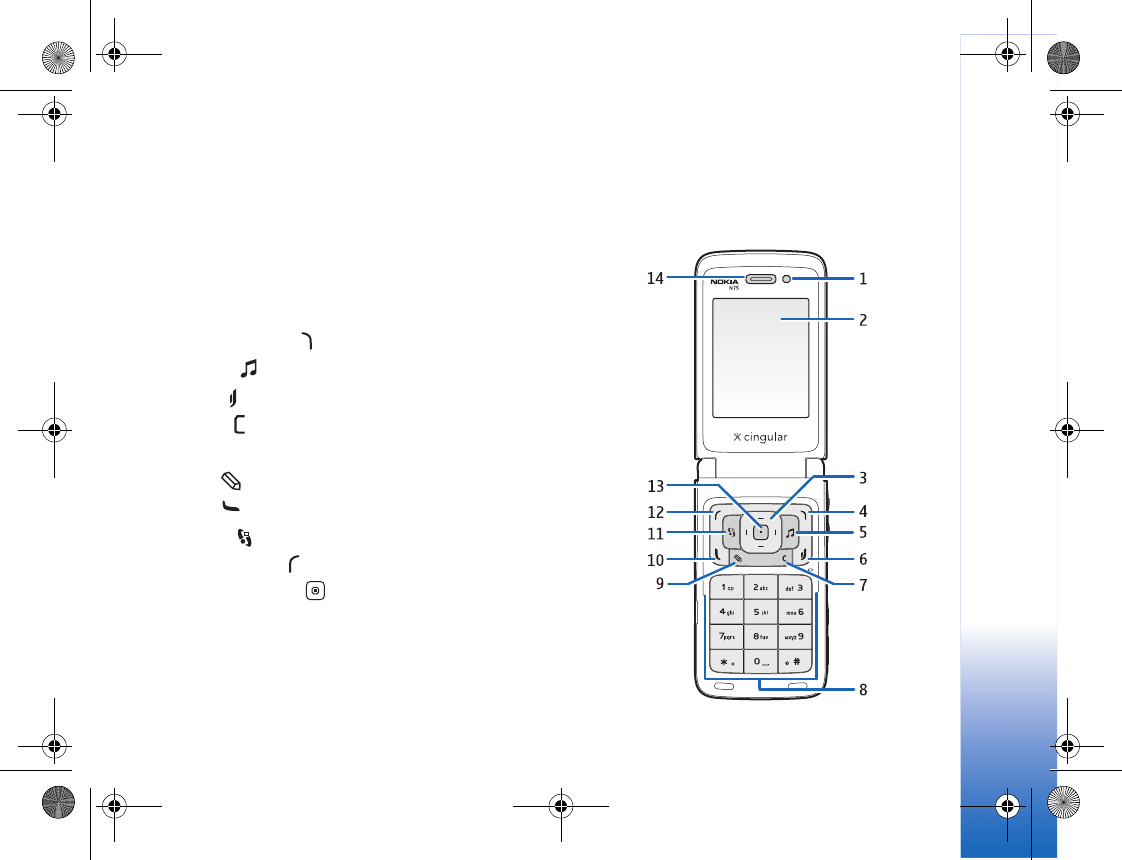
Your Nokia device
13
Your Nokia device
Keys and parts (fold open)
Light sensor (1)
Display screen (2)
4-way scroll key (3)
Right selection key ( ) (4)
Music key ( ) (5)
End key ( ) (6)
Clear key ( ) (7)
Keypad (8)
Edit key ( ) (9)
Call key ( ) (10)
Menu key ( ) (11)
Left selection key ( ) (12)
Center selection key ( ) (13)
Earpiece (14)
R1114_en.book Page 13 Thursday, October 19, 2006 3:43 PM
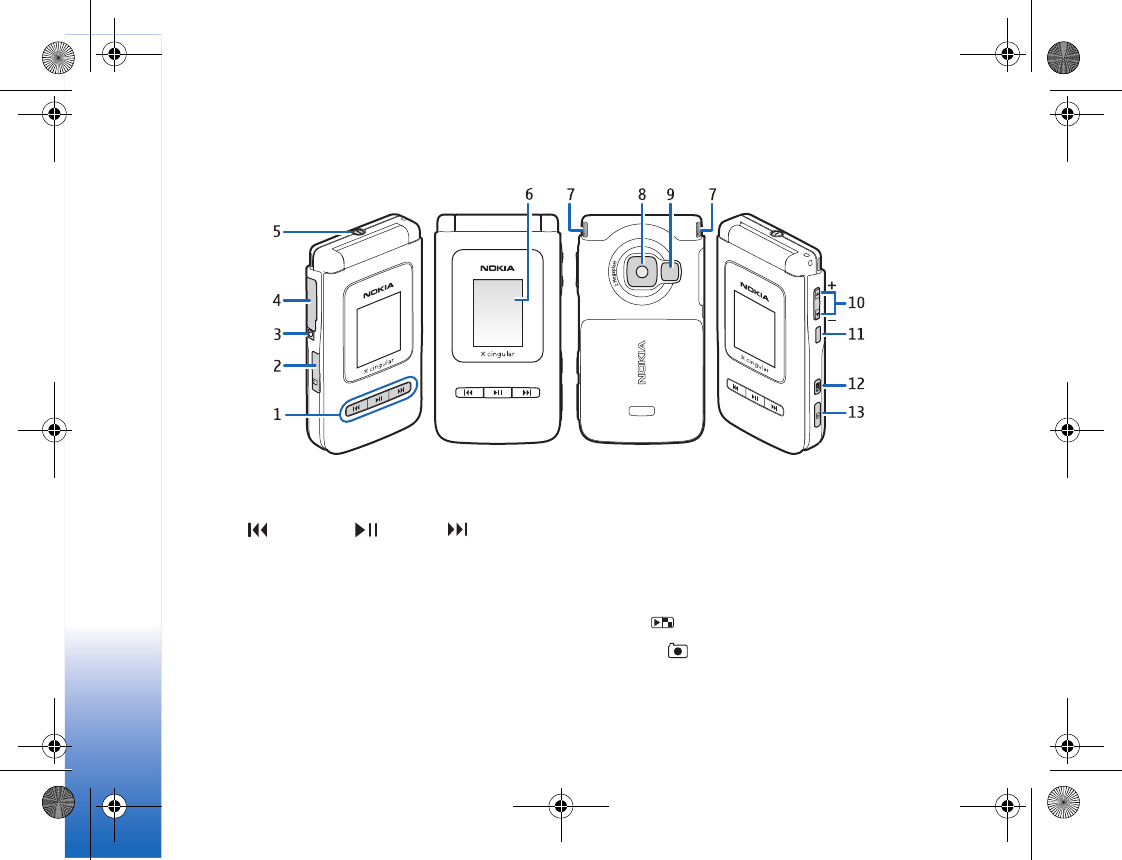
Your Nokia device
14
Keys and parts (fold closed, front, back and sides)
Player keys (1):
backward play/pause forward
Memory card slot (micro SD card) (2)
Charger connector (3)
Pop-PortTM connector (4)
Power button (5)
Cover display (6)
Stereo speakers (7)
Camera (8)
Camera flash (9)
Zoom/Volume key (10)
Infrared (IR) window (11)
Mode key( ) (12)
Capture key( ) (13)
R1114_en.book Page 14 Thursday, October 19, 2006 3:43 PM
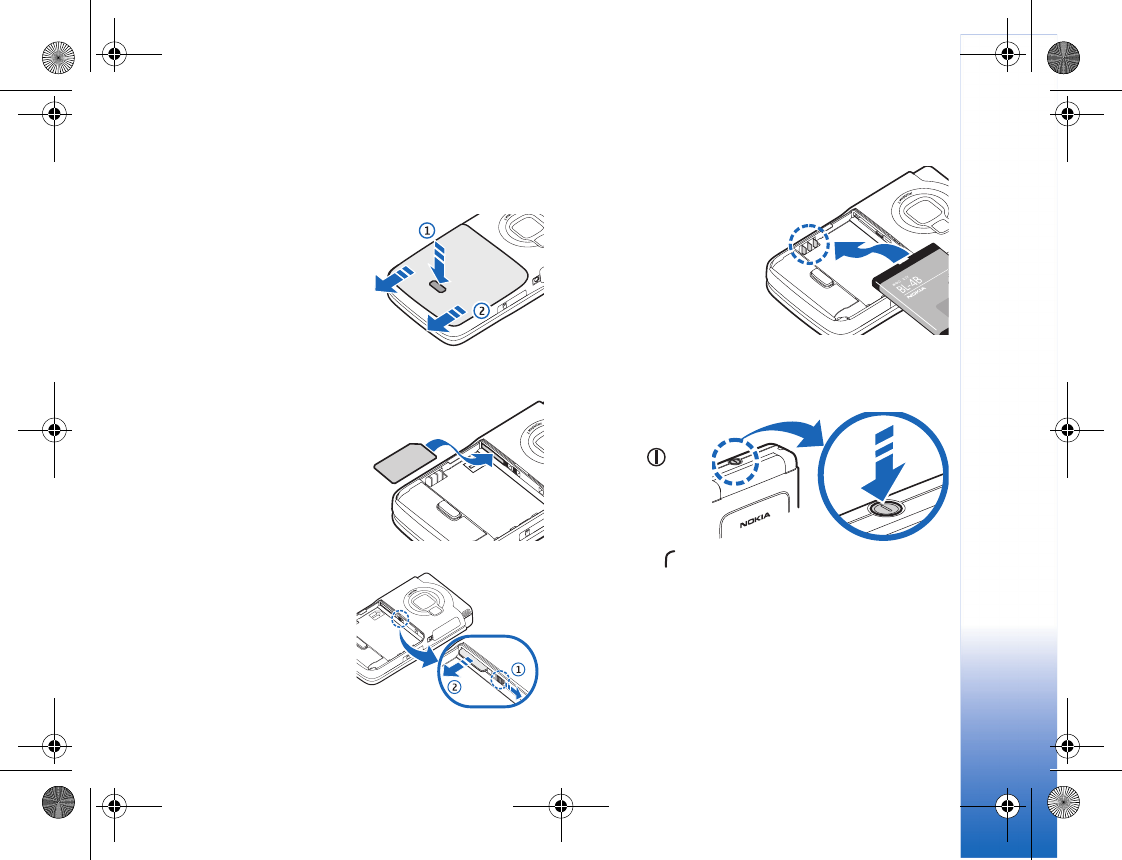
Your Nokia device
15
Insert the SmartChip card and
battery
Keep all SmartChip cards out
of the reach of small children.
Always switch the device off,
and disconnect the charger
before removing the battery.
1With the back of the
device facing you, press
the release button (1), and slide off the cover (2).
2Slide the SmartChip card
into the holder until it
clicks. Make sure that the
bevelled corner on the
card is facing the left side
of the device and that the
contact area on the card is
facing down.
To remove the
SmartChip card, slide the
lock to the right and pull
out the SmartChip card.
3Insert the battery.
4Replace the back cover.
Switch the device on
1Press and hold
the power
button ( ).
2If the device
asks for a UPIN
code or lock
code, enter it,
and press .
The factory setting for the lock code is 12345.
Your device has one internal antenna.
R1114_en.book Page 15 Thursday, October 19, 2006 3:43 PM
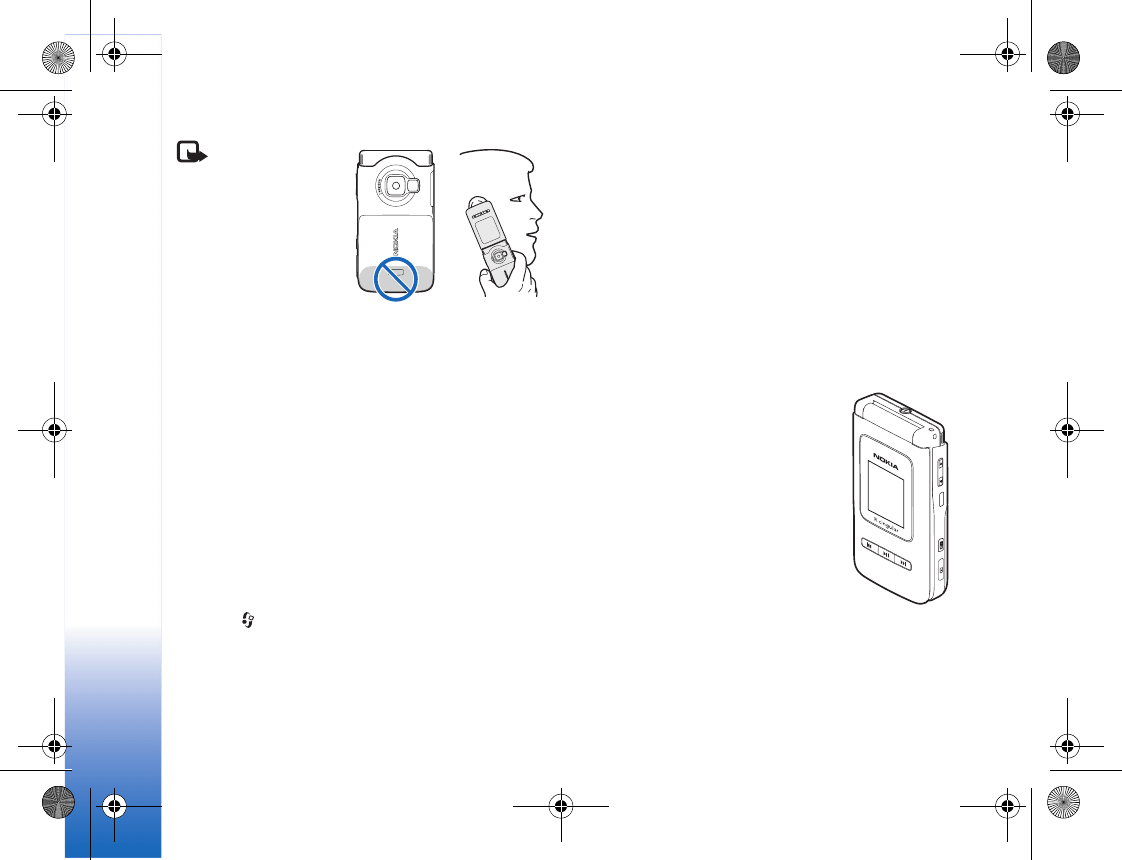
Your Nokia device
16
Note: As with
any other radio
transmitting device,
do not touch the
antenna
unnecessarily when
the device is switched
on. Contact with the
antenna affects call
quality and may cause the device to operate at a higher
power level than otherwise needed. Not touching the
antenna area during a phone call optimizes the antenna
performance and the battery life.
• When you switch on the device for the first time, it
may ask you to set the following information: Select
current city:, Time:, and Date:. Use the 4-way scroll
key, the center selection key, and the number keys. To
find the city, enter the first letters of the city name.
The city you select also defines the time zone for the
clock in your device.
• Your Nokia N75 normally has MMS, GPRS, streaming,
and mobile Internet settings automatically configured
in the device.
• Press to open the main menu.
Your service provider may have requested that certain
features be disabled or not activated in your device. If so,
they will not appear on your device menu. Your device
may also have been specially configured. This
configuration may include changes in menu names, menu
order, and icons. Contact your service provider for more
information.
Modes
Your device has two operating modes: Fold closed with
access to particular features including Music player,
Radio and Camera; Fold open for traditional mobile phone
use and access to all the features on your device.
Fold closed mode
When the fold is closed, the main
display deactivates and the cover
display lights up. Ongoing calls end,
unless the loudspeakers are in use or a
compatible headset is connected. To
change the settings, see "Cover
display," p. 100. If you are using Music
player or Radio to listen to an audio
clip, it continues to play.
With the fold closed, pressing the
mode key switches between 3 views:
R1114_en.book Page 16 Thursday, October 19, 2006 3:43 PM
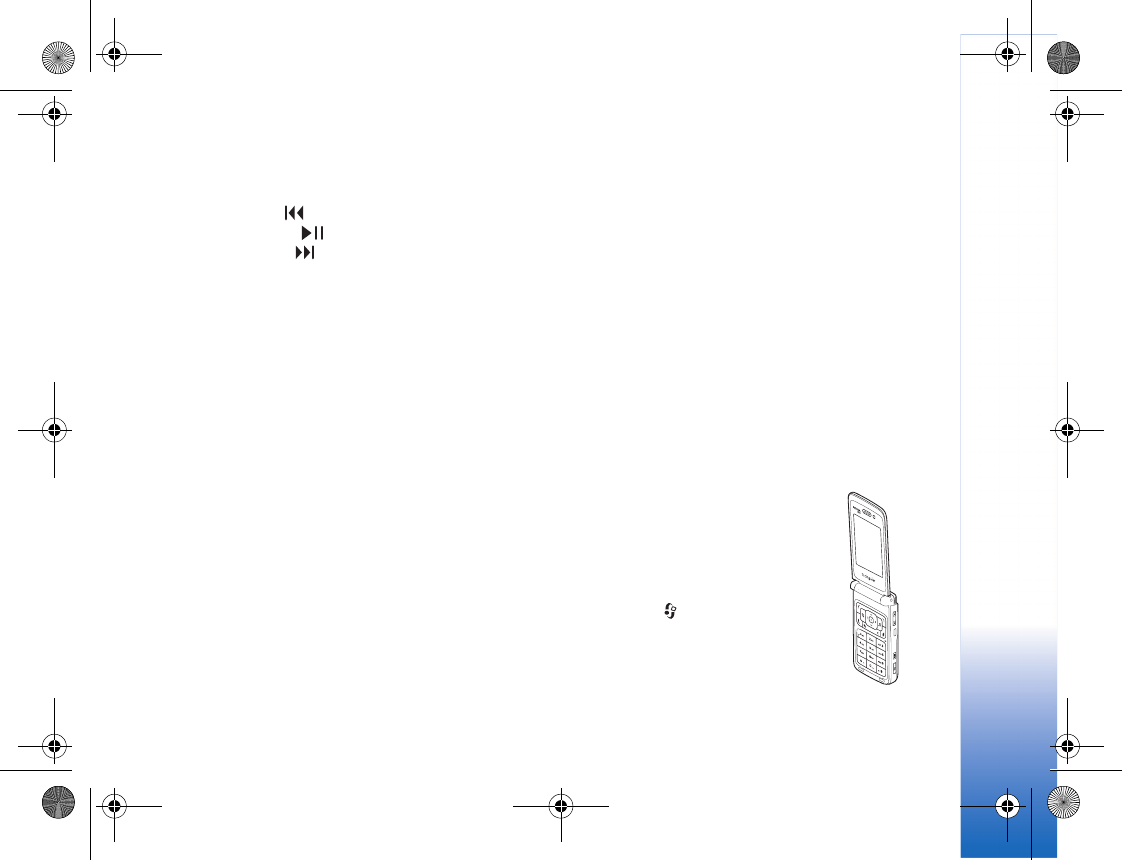
Your Nokia device
17
• ‘Basic’ idle: displays clock and status information,
signal strength and battery indicators. The following
softkeys are also available:
Left softkey ( ) selects Music player
Middle softkey ( ) selects Play/Pause
Right softkey ( ) selects Now playing
• ‘Today’ idle: dispalys calendar information
• ‘Picture’ idle displays a picture of your choice
If you are using Music player to listen to an audio clip,
volume bars and track information are displayed. To play,
pause, or play the next or previous audio clip, use the
player keys on the cover. To adjust the volume, use the
volume key on the right-hand side of the device.
If you are using Radio with the fold closed, volume bars
and station information are displayed. To turn the radio on
or off, and select the next or previous saved station, use
the player keys on the cover. To adjust the volume, use the
volume key on the right-hand side of the device.
If you are using Camera with the fold closed, hold the
device in landscape. The outer display becomes the
viewfinder. To activate the camera, press and hold the
capture key. To zoom in or out, use the volume key. To take
a picture, press the capture key. To switch between Image
mode and Video mode, press the mode key.
To make lighting and color adjustments before taking a
picture, press the middle cover key to activate the toolbar,
and use the volume key to scroll through the active
toolbar. See "Adjust color and lighting," p. 32 and
"Scenes," p. 32.
Calendar and clock alarms and notes for missed calls and
new received messages are also displayed. To view
received text messages and the text and image objects
of received multimedia messages, open the fold, and
view the message on the main display.
Incoming calls are indicated by their normal tone and a
note. In the cover display settings, select Answer if fold
opened to answer a call when you open the fold. If a
compatible headset is connected to the device, press the
answer key on the headset. To change the settings, see
"Cover display," p. 100.
To make calls or use the menu, open the fold.
Fold open mode
When you open the fold, the
main display lights up, the
keypad is available, and you can
access the menu. To access the
menu, press .
The fold opens about 170
degrees, as shown in the picture.
Do not force the fold to open
more.
R1114_en.book Page 17 Thursday, October 19, 2006 3:43 PM
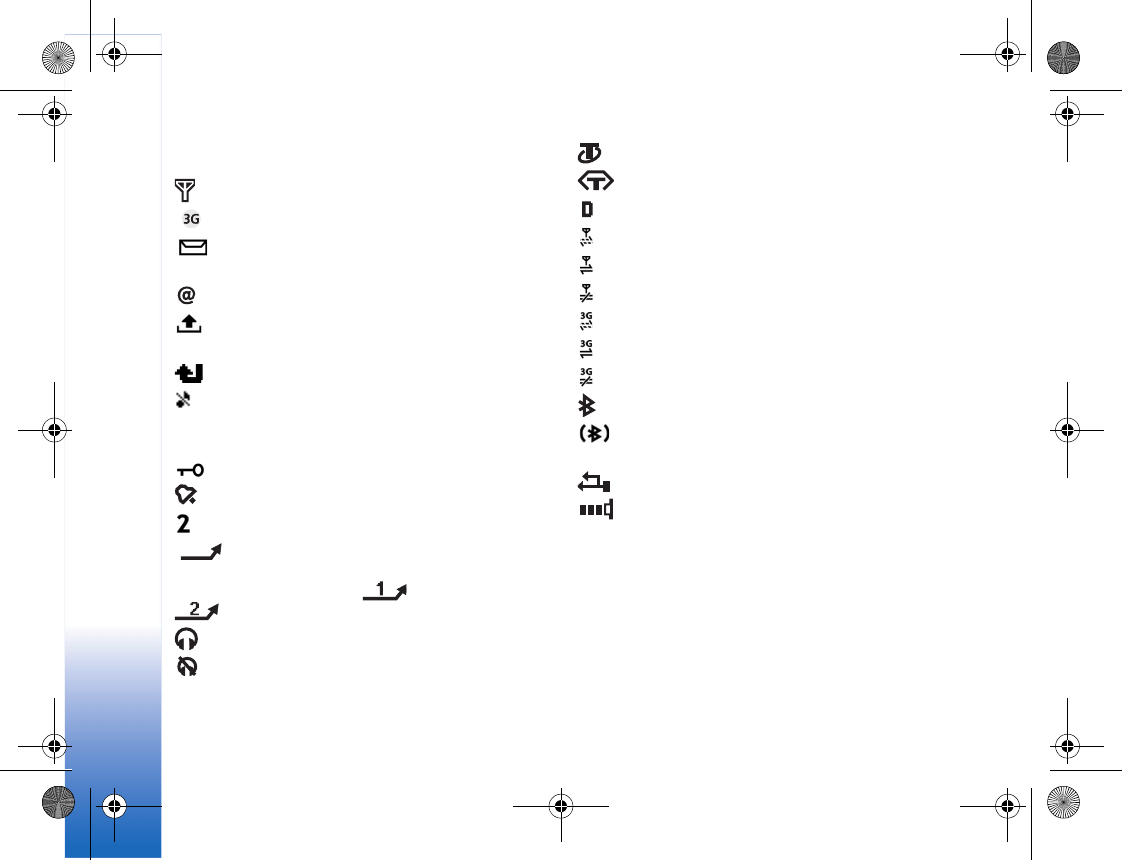
Your Nokia device
18
Essential indicators
The device is being used in a GSM network.
The device is being used in a UMTS network.
You have one or more unread messages in the Inbox
folder in Messag..
You have received new e-mail in the remote mailbox.
There are messages waiting to be sent in the Outbox
folder.
You have missed calls.
Shown if Ringing type is set to Silent and Message
alert tone, IM alert tone, and E-mail alert tone are set
to Off.
The device keypad is locked.
A clock alarm is active.
The second phone line is being used (network service).
All calls to the device are forwarded to another
number. If you have two phone lines (network service), the
indicator for the first line is and for the second
.
A compatible headset is connected to the device.
The connection to a compatible headset with
Bluetooth connectivity has been lost.
A compatible loopset is connected to the device.
A compatible TTY is connected to the device.
A data call is active.
A GPRS or EDGE packet data connection is available.
A GPRS or EDGE packet data connection is active.
A GPRS or EDGE packet data connection is on hold.
A UMTS packet data connection is available.
A UMTS packet data connection is active.
A UMTS packet data connection is on hold.
Bluetooth connectivity is on.
Data is being transmitted using Bluetooth
connectivity.
A USB connection is active.
An infrared connection is active. If the indicator is
blinking, the device is trying to connect to the other device
or the connection has been lost.
Useful shortcuts
Use shortcuts to quickly get the most from your device.
Refer to the relevant sections in this user guide for further
details of the functions.
R1114_en.book Page 18 Thursday, October 19, 2006 3:43 PM
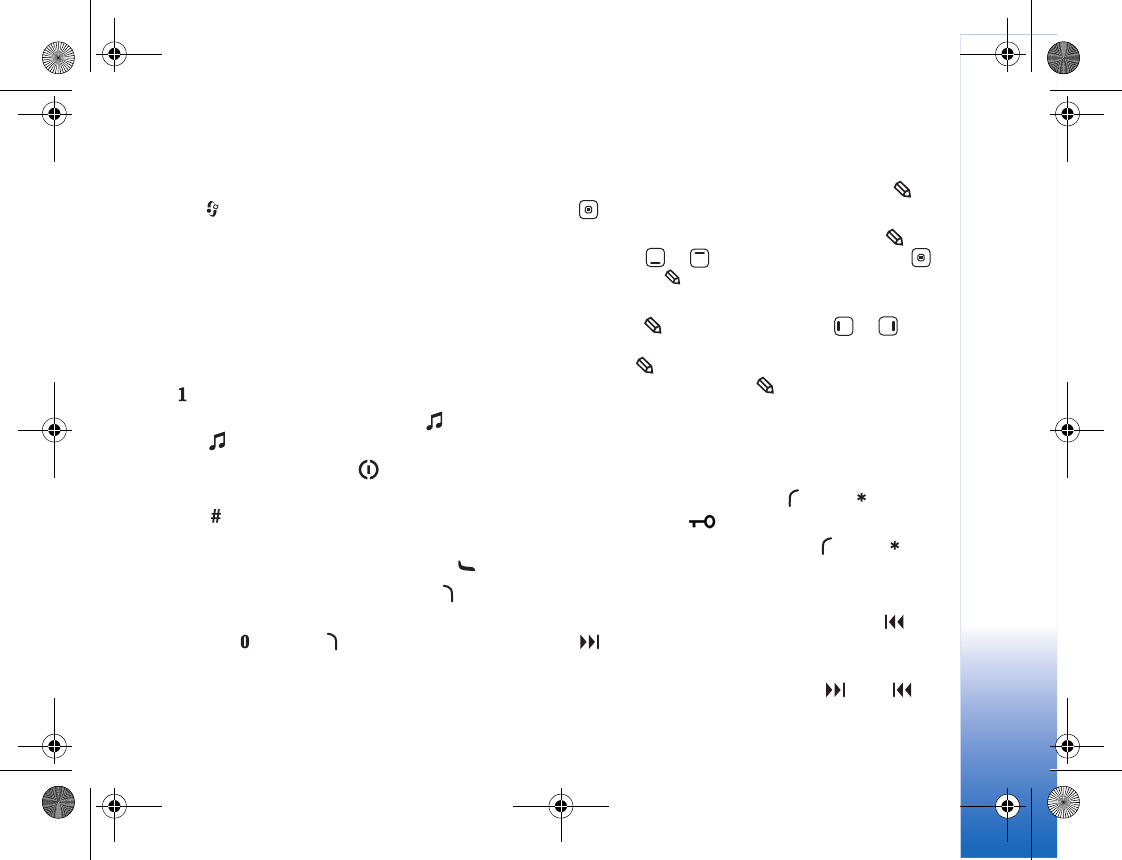
Your Nokia device
19
Idle mode
To switch between applications that are open, press and
hold , and select an application. If memory is low, the
device may close some applications. The device saves any
unsaved data before closing an application.
Leaving applications running in the background increases
the demand on battery power and reduces the battery life.
To start the camera, press and hold the capture key for
more than 1 second.
To call your voice mailbox (network service), press and hold
.
To open Cingular Music folder, press or press and
hold to start Music player. See "Music key," p. 25.
To change the profile, press , and select a profile.
To switch between Normal and Silent profiles, press and
hold . If you have two phone lines (network service),
this action switches between the two lines.
To open the last dialed numbers list, press .
To use voice commands, press and hold .
To start a connection to Services (network service), press
and hold or press . See "MEdia Net," p. 78.
For further shortcuts available in the idle mode, see "Active
idle mode," p. 97.
Edit text and lists
To mark an item in a list, scroll to it, and press and
at the same time.
To mark multiple items in a list, press and hold while
you press or . To end the selection, release ,
then release .
To copy and paste text: To select letters and words, press
and hold . At the same time, press or to
highlight text. To copy the text to clipboard, while still
holding , select Copy. To insert the text into a
document, press and hold , and select Paste.
Keypad lock (keyguard)
Use the keypad lock to prevent accidental keypresses.
To lock, in the idle mode, press , then . When the
keys are locked, is shown on the display.
To unlock with the fold open, press , then .
To lock the keypad with the fold open, press the power
key, and select Lock keypad.
To lock the keypad with the fold closed, press , then
, or press the power key twice to highlight Lock
keypad, and press and hold the power key to select it.
To unlock with the fold closed, press , then .
R1114_en.book Page 19 Thursday, October 19, 2006 3:43 PM
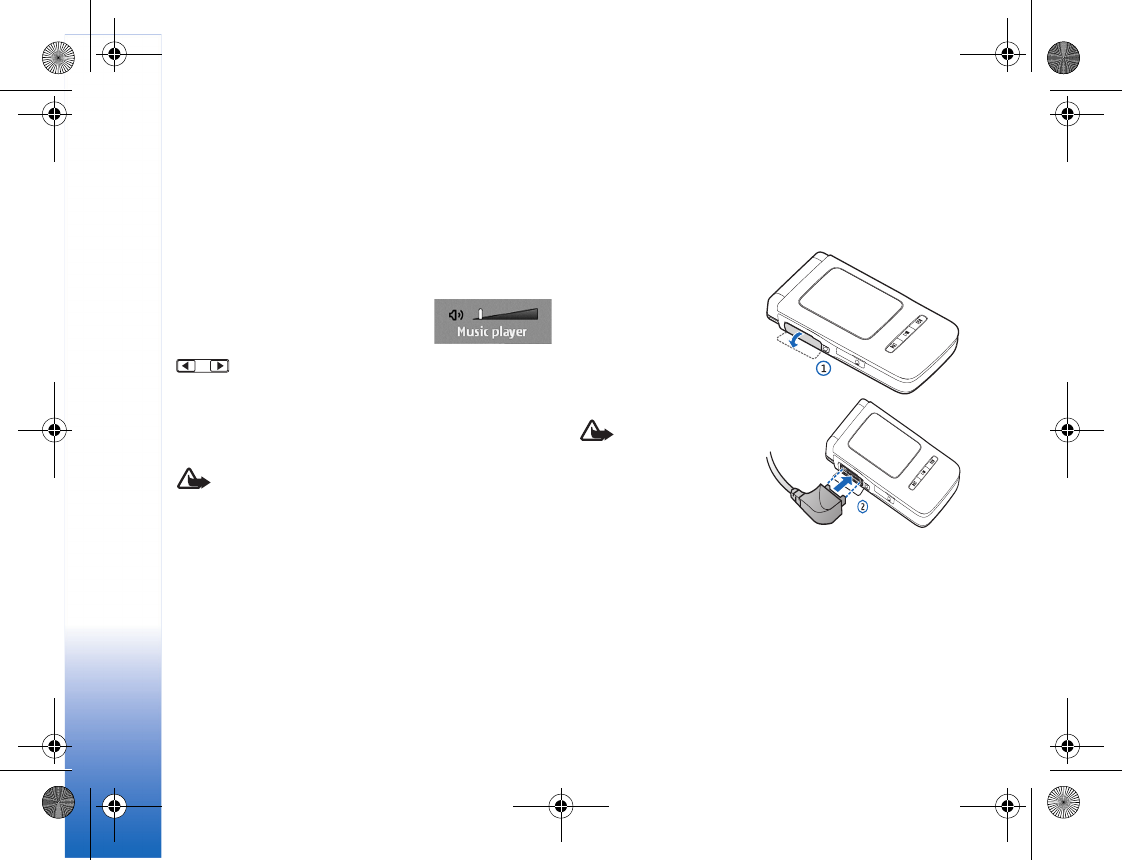
Your Nokia device
20
When the keypad lock is on, calls may be possible to the
official emergency number programmed into your device.
To turn on the display light when the keypad lock is on,
press the power key.
Volume and loudspeaker control
To increase or decrease the volume
level when you have an active call or
are listening to audio, press and hold
on the right side of the device.
The built-in loudspeakers allow you to speak and listen
from a short distance without having to hold the device
to your ear. Audio applications use the loudspeakers by
default.
Warning: Listen to music at a moderate level.
Continuous exposure to high volume may damage your
hearing. Do not hold the device near your ear when the
loudspeaker is in use, because the volume may be
extremely loud.
To locate the loudspeakers, see “Keys and parts” in the
Quick start guide.
To use the loudspeakers during a call, select Options >
Activate loudsp..
To turn off the loudspeakers, select Options > Activate
handset.
Headset
Connect a compatible
headset to the Pop-PortTM
connector of your device.
Ensure the headset
connector is ‘upside down’
before connecting to your
device. Do not use
excessive force.
Warning: When you
use the headset, your
ability to hear outside
sounds may be affected.
Do not use the headset
where it can endanger
your safety.
R1114_en.book Page 20 Thursday, October 19, 2006 3:43 PM
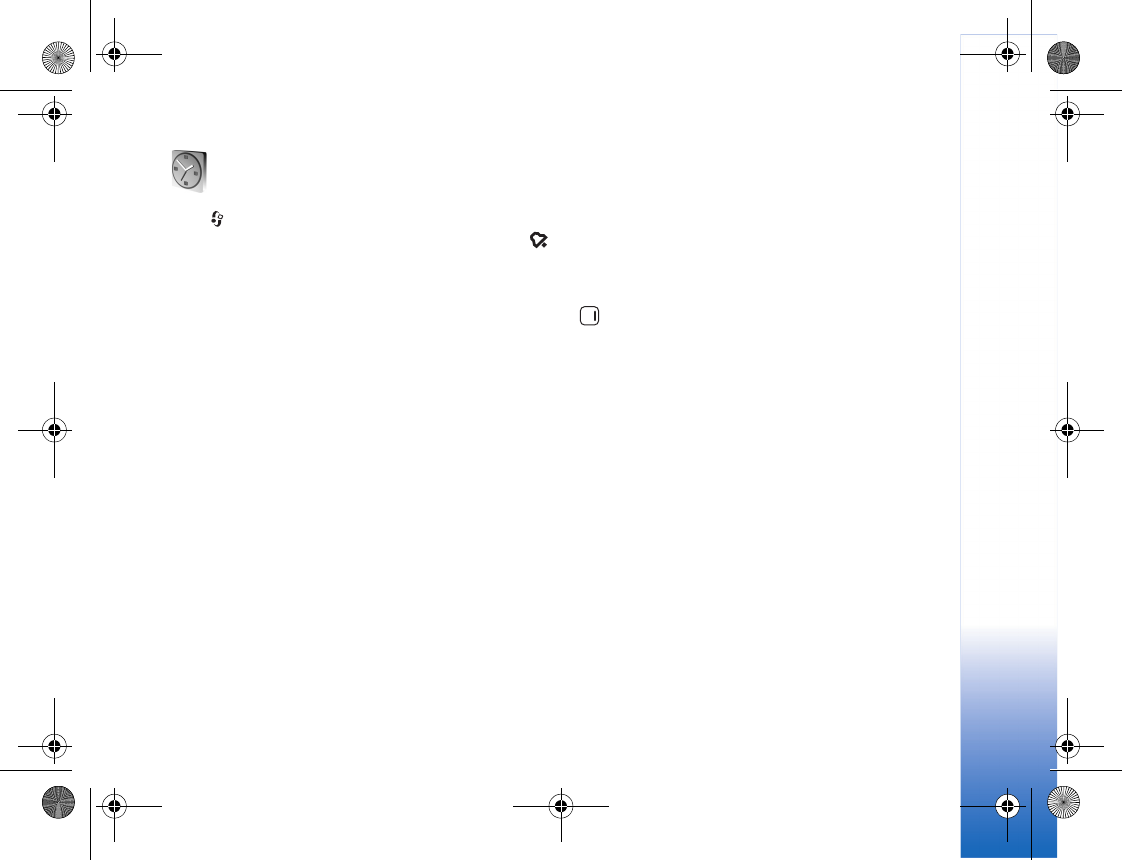
Your Nokia device
21
Clock
Press , and select Tools > Clock. To set a new alarm,
select Options > Set alarm. When an alarm is active,
is shown.
To turn off the alarm, select Stop, or to stop the alarm for
5 minutes, select Snooze.
If the alarm time is reached while the device is switched
off, the device switches itself on and starts sounding the
alarm tone. If you select Stop, the device asks whether you
want to activate the device for calls. Select No to switch
off the device or Yes to make and receive calls. Do not
select Yes when using a wireless phone may cause
interference or danger.
To cancel an alarm, select Clock > Options > Remove
alarm.
Clock settings
To change the clock settings, select Clock > Options >
Settings.
To change the time or date, select Time or Date.
To change the clock shown in the idle mode, select Clock
type > Analog or Digital.
To allow the mobile phone network to update the time,
date, and time zone information to your device (network
service), select Network operator time > Auto-update.
To change the alarm tone, select Clock alarm tone.
World clock
To open the world clock view, select Clock, and press
. In the world clock view, you can view the time in
different cities.
To add cities to the list, select Options > Add city. Enter
the first letters of the city name. The search field appears
automatically, and the matching cities are displayed.
Select the required city. You can add a maximum of 15
cities to the list.
To set your current city, scroll to a city, and select
Options > My current city. The city is displayed in the
clock main view, and the time in your device is changed
according to the city selected. Ensure that the time is
correct and matches your time zone.
R1114_en.book Page 21 Thursday, October 19, 2006 3:43 PM
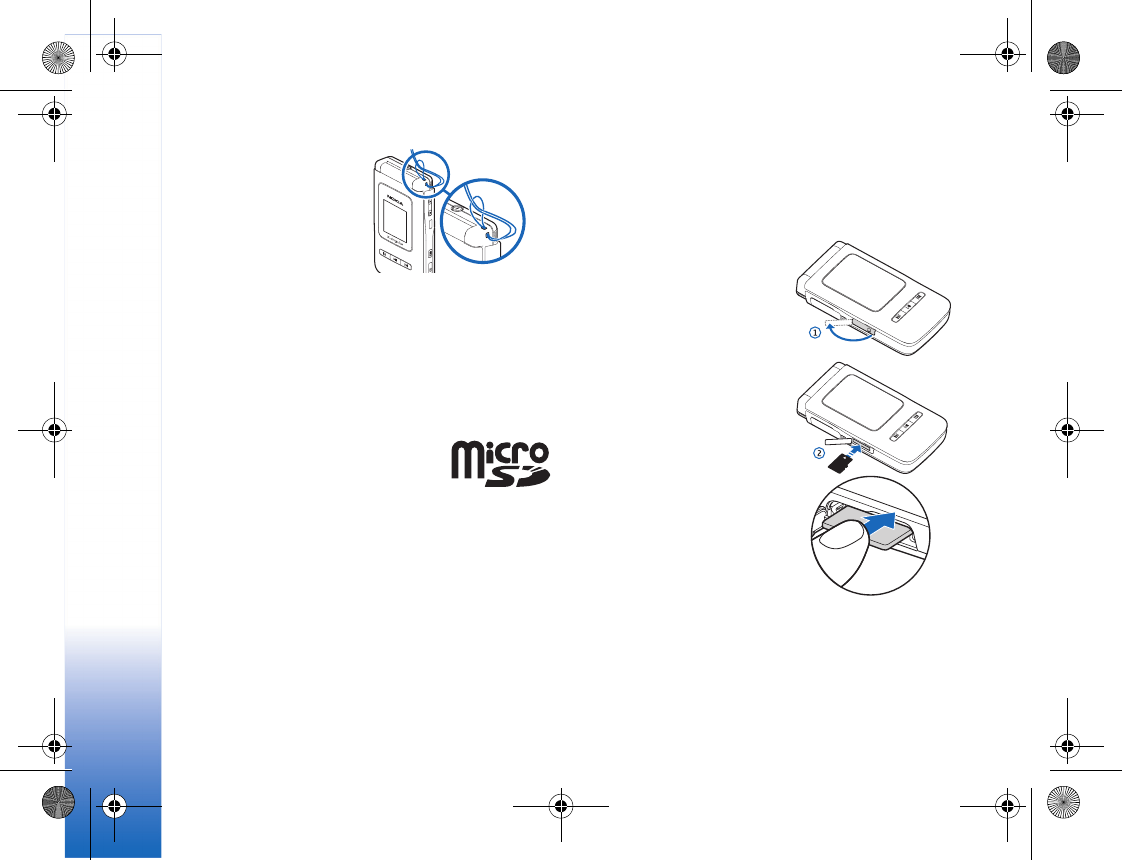
Your Nokia device
22
Wrist strap
Thread a strap as shown,
and tighten it.
Settings
You may have MMS, GPRS, streaming, and Mobile
Internet settings from your service providers already
installed in your device, or you may receive the settings
from the service providers as a special text message.
Memory card
You can use a compatible microSD card
as extra storage space to save the
memory on your device. You can also
back up information from your device
to the memory card.
Use only compatible microSD cards with this device. Other
memory cards, such as Reduced Size MultiMediaCards, do
not fit in the memory card slot and are not compatible
with this device. Using an incompatible memory card may
damage the memory card as well as the device, and data
stored on the incompatible card may be corrupted.
Use only microSD cards approved by Nokia for use with
this device. Nokia utilizes the approved industry standards
for memory cards but not all other brands may function
correctly or be fully compatible with this device.
Keep all memory cards out of the reach of small children.
Insert the memory card
1To insert the memory
card, place your finger in
the recess of the door of
the memory card slot, and
open the door.
2Insert the memory card in
the slot. Make sure that
the contact area on the
card is facing down and
towards the slot with the
bevelled corner facing
the base of the device.
Push the card in. You can
hear a click when the
card locks into place.
R1114_en.book Page 22 Thursday, October 19, 2006 3:43 PM
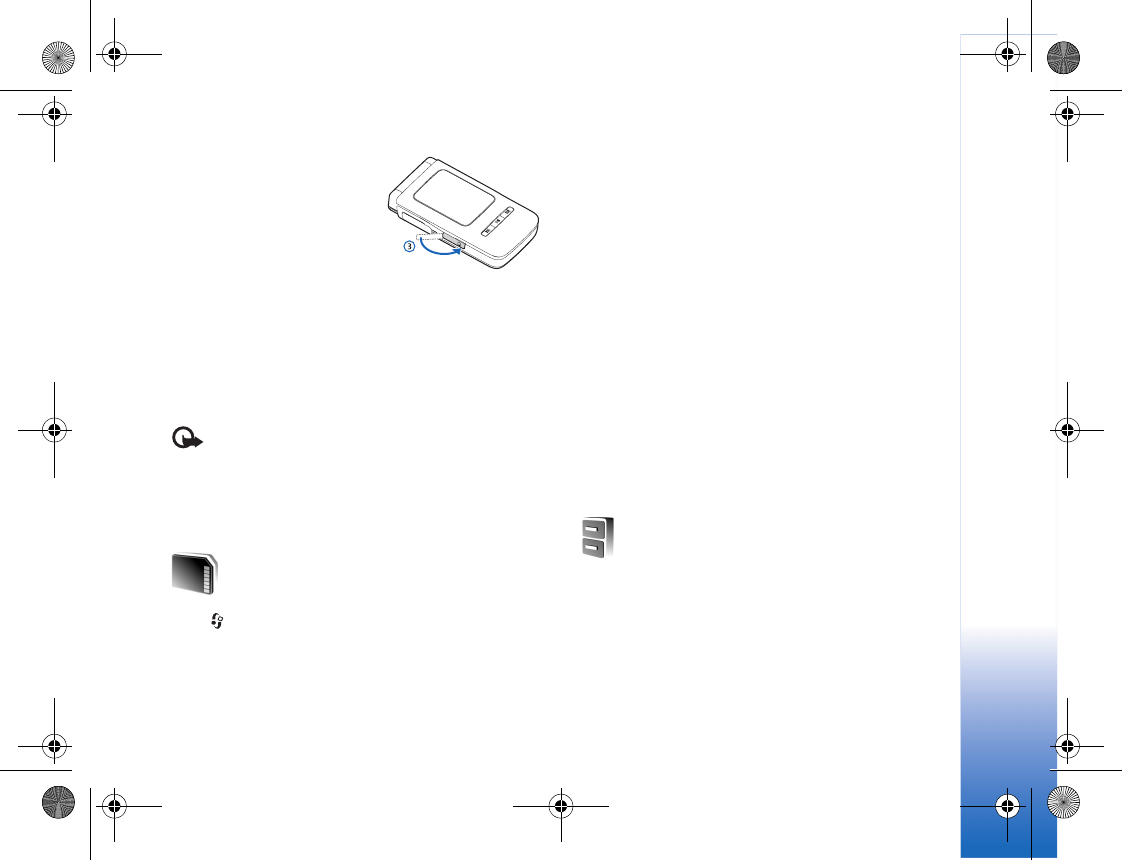
Your Nokia device
23
3Close the door. You
cannot use the memory
card if the door is open.
Eject the memory card
1Before you eject the card,
press the power key, and
select Remove mem.
card. All applications are
closed.
2When Remove memory card and press 'OK' is
displayed, open the door of the memory card slot.
3Press the memory card to release it from the slot.
4Remove the memory card.
5If the device is switched on, select OK.
Important: Do not remove the memory card in the
middle of an operation when the card is being accessed.
Removing the card in the middle of an operation may
damage the memory card as well as the device, and data
stored on the card may be corrupted.
Memory card tool
Press , and select Settings > Memory. You can use a
compatible memory card as extra storage space and to
back up the information in the device memory.
To back up information from the device memory to a
compatible memory card, select Options > Backup
phone mem.
To restore information from the compatible memory
card to the device memory, select Options > Restore
from card.
Format a memory card
When a memory card is reformatted, all data on the card
is permanently lost.
Some memory cards are supplied preformatted, and
others require formatting. Consult your retailer to find
out if you must format the memory card before you can
use it.
To format a memory card, select Options > Format
mem. card. Select Yes to confirm.
File manager
Many features of the device, such as address book,
messages, images, videos, ringing tones, calendar notes,
documents, and downloaded applications, use memory
to store data. The free memory available depends on how
much data is already saved in the device memory.
R1114_en.book Page 23 Thursday, October 19, 2006 3:43 PM
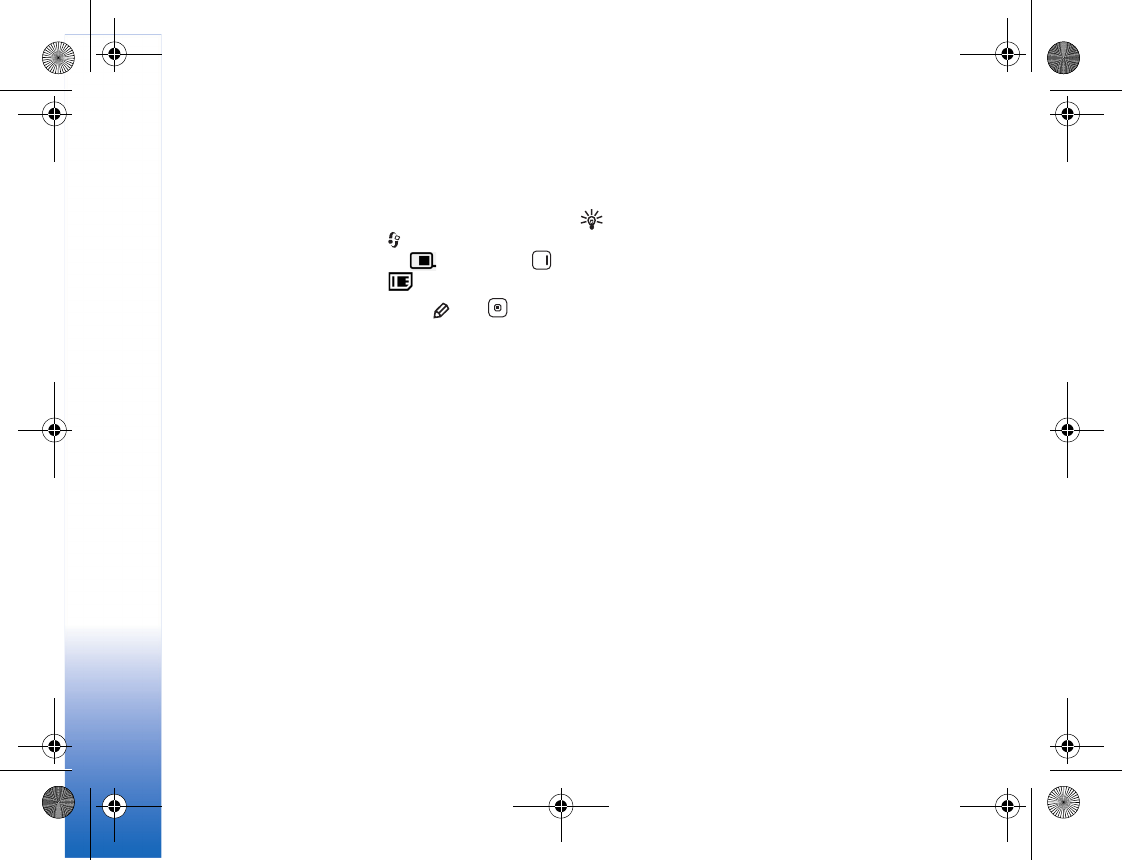
Your Nokia device
24
You can use a compatible memory card as extra storage
space. Memory cards are rewritable, so you can delete old
information and save new data on a memory card.
To browse files and folders in the device memory or on a
memory card (if inserted), press , and select Settings >
File mgr.. The device memory view ( ) opens. Press
to open the memory card view ( ), if available.
To move or copy files to a folder, press and at the
same time to mark a file, and select Options > Move to
folder or Copy to folder.
To find a file, select Options > Find and the memory from
which to search, and enter a search text that matches the
file name.
View memory consumption
To view what types of data you have in the device and
how much memory the different data types consume,
select Options > Check memory. The amount of available
free memory is shown in Free memory.
Memory low—free memory
The device notifies you if the device or the memory card
memory is low.
To free device memory, transfer data to a compatible
memory card, if you have one. Mark files to be moved, and
select Move to folder > Memory card and a folder. You
can also transfer media files to a compatible PC using
Nokia PC Suite.
Tip! You can use Nokia Phone Browser available in
Nokia PC Suite to view the different memories in your
device and transfer data.
To remove data to free memory, use File mgr., or go to the
respective application. For example, you can remove the
following:
• Messages from Inbox, Drafts, and Sent folders in
Messag.
• Retrieved e-mail messages from the device memory
• Saved Web pages
• Saved images, videos, or audio files
• Contact information
•Calendar notes
• Downloaded applications. See also "Application
manager," p. 109.
• Any other data that you no longer need
You can also shrink images within My Stuff, so that they
use less memory. See "Shrink," p. 48.
R1114_en.book Page 24 Thursday, October 19, 2006 3:43 PM
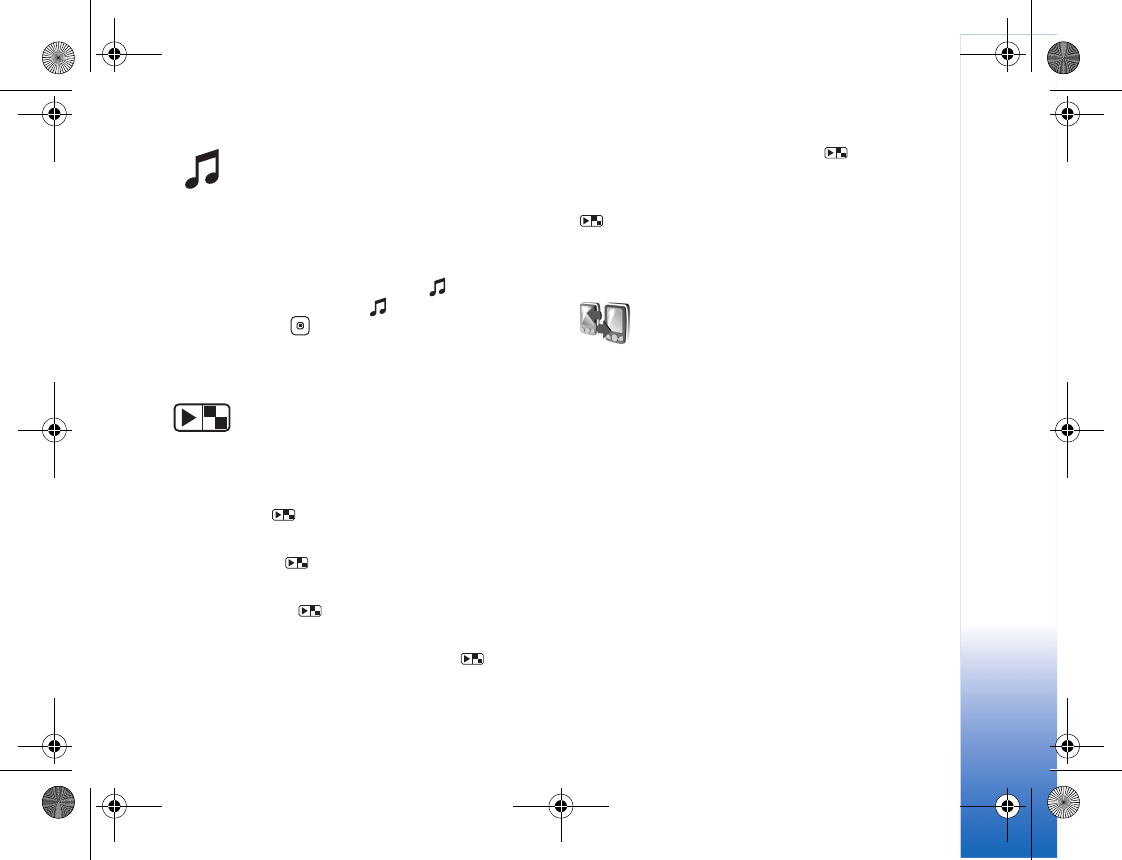
Your Nokia device
25
Music key
With the music key, you have quick access to Music player
and the Cingular Music folder containing multimedia
content and predefined applications.
To open Music player, press and hold . To open the
Cingular Music folder, press . To open the desired
application, press .
Mode key
The mode key is a multi-function key, allowing you to
switch easily between selected applications.
Press and hold to open the latest taken photo in My
Stuff.
In Camera, press to switch between Image mode and
Video mode.
In My Stuff, press to switch between Tile and
Thumbnail views.
With the fold closed, in Music player, press to switch
between Now playing and Music library views.
With the fold closed, in Radio, press to switch
between Channel and Channel list views.
With the fold closed and the device in idle mode, press
to switch between ‘basic’ idle (clock and softkeys
available); ‘today’ idle (calendar view); and ‘picture’ idle
(where the user can select a picture to display).
Transfer content from
another device
You can transfer content, such as an address book (or
contacts), between compatible Nokia devices using
Bluetooth connectivity or infrared. The type of content
that can be transferred depends on the Nokia device you
are trying to transfer content to. If the other device
supports synchronization, you can also synchronize data
between the other device and your Nokia device.
Copyright protections may prevent some images, music
(including ringing tones), and other content from being
copied, modified, transferred or forwarded.
You can insert your SmartChip card in the other device.
When your Nokia device is switched on without a
SmartChip card, the offline profile is automatically
activated.
R1114_en.book Page 25 Thursday, October 19, 2006 3:43 PM
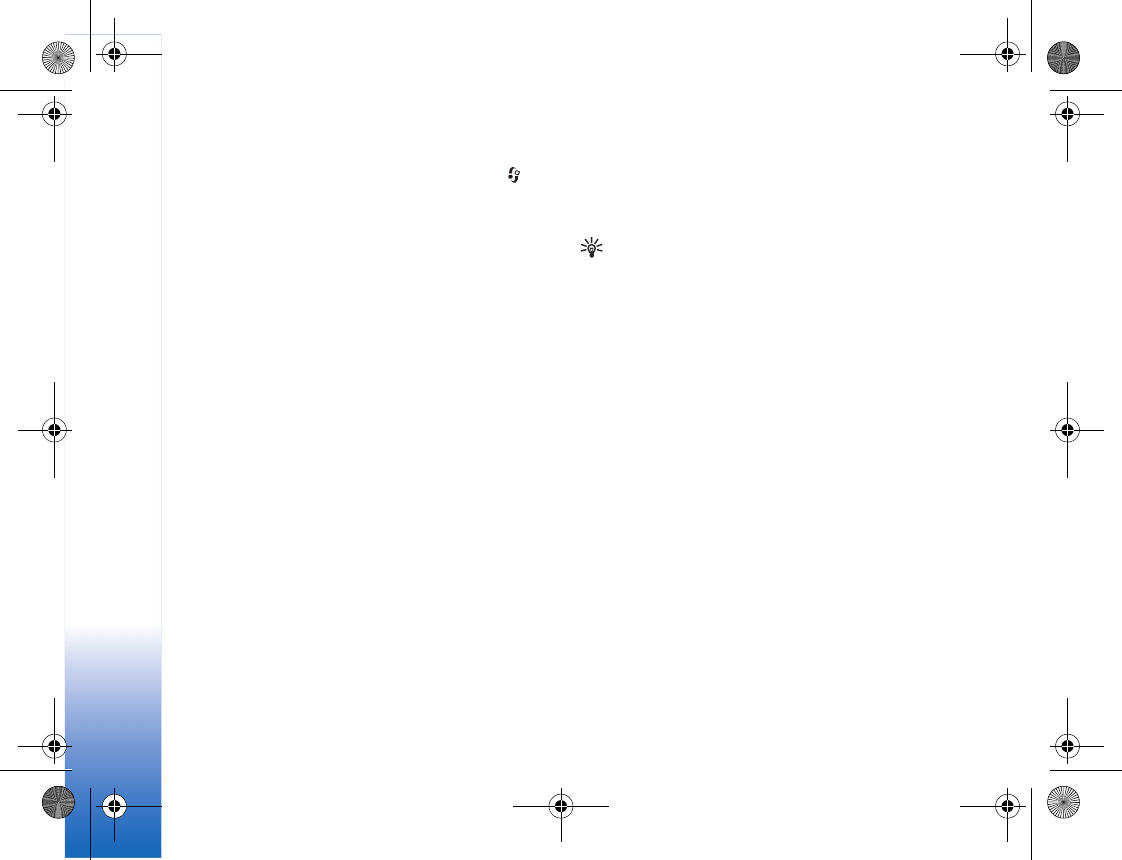
Your Nokia device
26
Transfer content (to your device)
1To use the application for the first time, press on
your Nokia device, and select Settings > Transfer. If
you have used the application before and want to start
a new transfer, select Transfer data.
In the information view, select Continue.
2Select whether you want to use Bluetooth
connectivity or infrared to transfer the data. Both
devices must support the selected connection type.
3If you select Bluetooth connectivity:
To have your Nokia device search for devices with
Bluetooth connectivity, select Continue. Select your
other device from the list. You are asked to enter a
code on your Nokia device. Enter a code (1-16 digits),
and select OK. Enter the same code on the other
device, and select OK. The devices are now paired. See
"Pair devices," p. 114.
For some phone models, the Transfer application is
sent to the other device as a message. To install
Transfer on the other device, open the message, and
follow the instructions on the display.
If you select infrared, connect the two devices. See
"Infrared connection," p. 115.
4From your Nokia device, select the content you want
to copy from the other device.
Content is copied from the memory of the other device to
the corresponding location in your Nokia device. Copying
time depends on the amount of data to be transferred. You
can cancel copying and continue later.
If the other device supports synchronization, you can keep
the data up-to-date in both devices.
Tip! Synchronizing data means that data is made the
same in each device, including deleted data. Use
Transfer data to copy data from one device to another.
To start a synchronization with a compatible Nokia device,
select Phones, scroll to the device, and select Options >
Synchronize. Follow the instructions on the display.
To view the log of a previous transfer, select Transfer log.
R1114_en.book Page 26 Thursday, October 19, 2006 3:43 PM
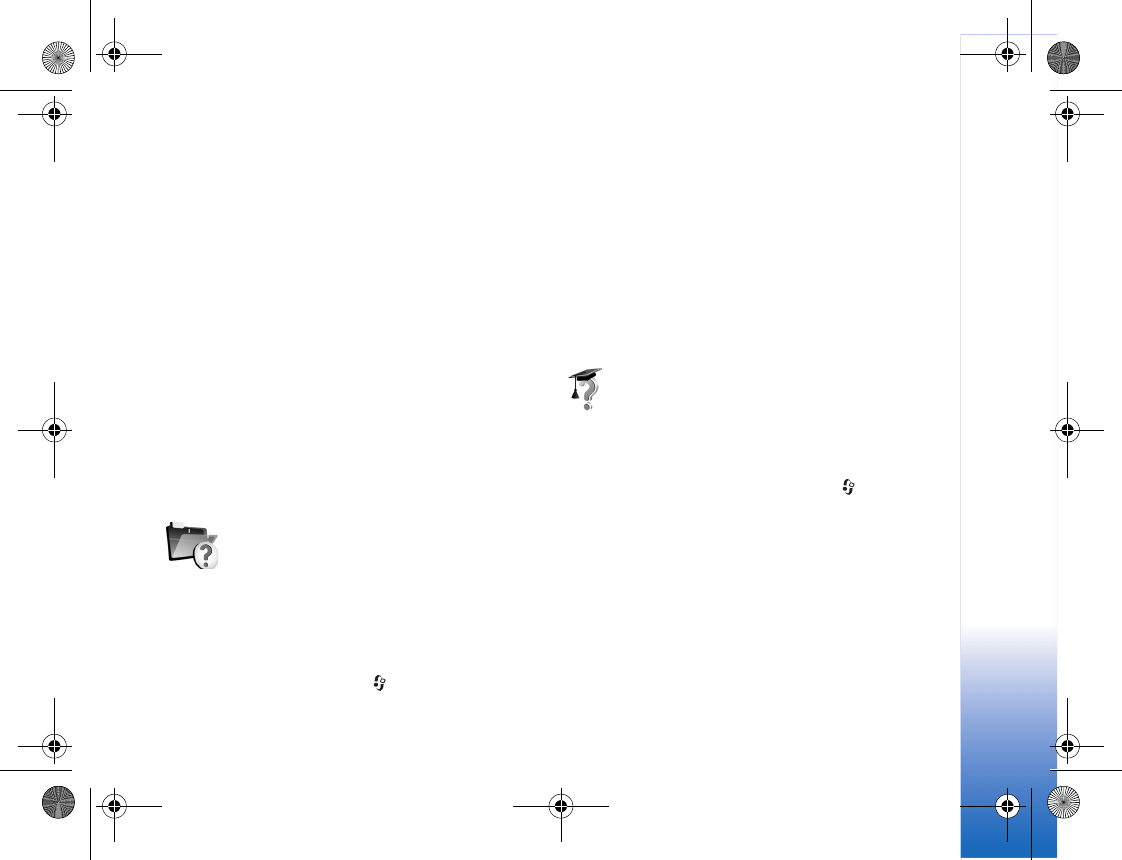
Support
27
Support
Nokia support and contact
information
Check www.nokia.com/support or your local Nokia Web
site for the latest version of this guide, additional
information, downloads, and services related to your Nokia
device.
On the Web site, you can find information on the use of
Nokia products and services. If you need to contact
customer service, check the list of local Nokia contact
centers at www.nokia.com/customerservice.
For maintenance services, check your nearest Nokia service
center at www.nokia.com/repair.
Help
Your device has context-sensitive help. When an
application is open, select Options > Help to access help
for the current view.
To switch between help and the application that is open in
the background, press and hold .
To open help from the main menu, select Tools > Help.
Select the desired application to view its help topics. To
search for help topics using keywords, select Options >
Search by keyword
When you are reading a help topic, scroll left or right to
view other related topics.
Tutorial
The tutorial gives you information about some of the
features of your device.
To access the tutorial in the menu, press , and select
Tools > Tutorial and the section you want to view.
R1114_en.book Page 27 Thursday, October 19, 2006 3:43 PM
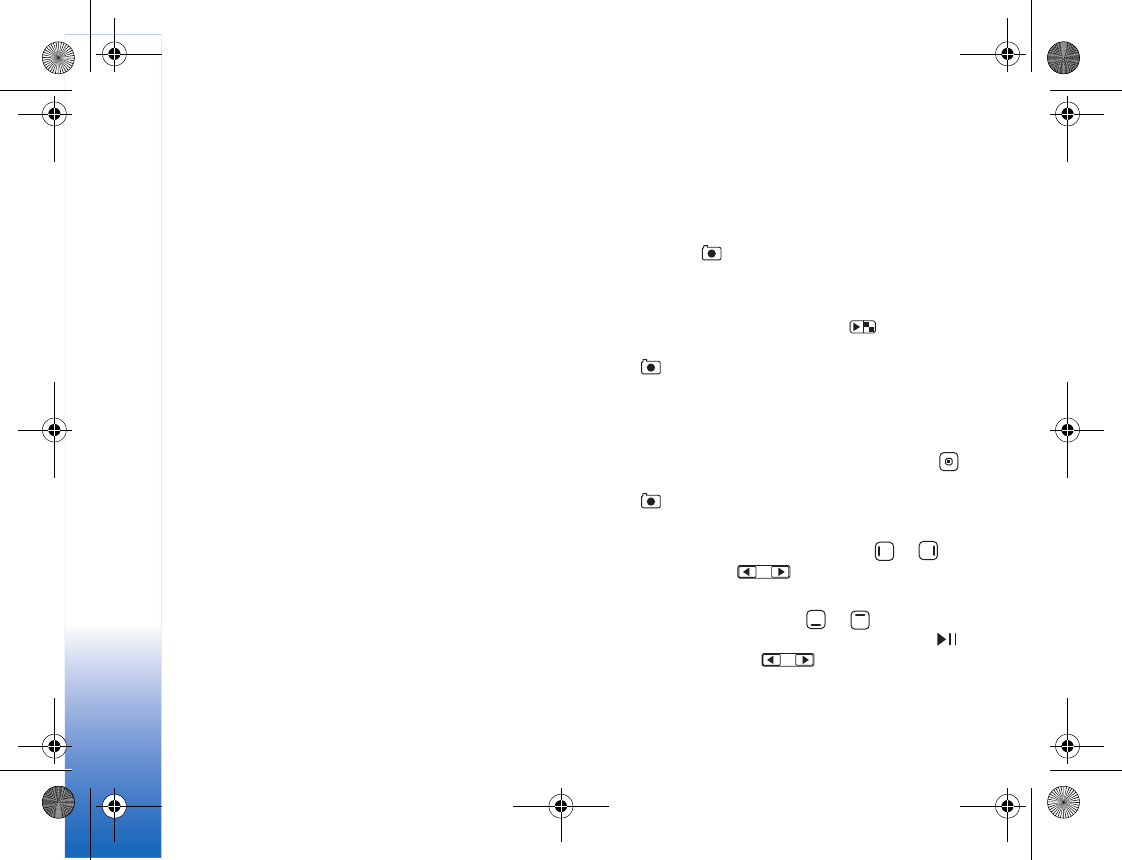
Camera
28
Camera
Your Nokia device has a high resolution camera on the
back of the device that you can use to take still pictures
and record videos.
This device supports an image resolution of 1600x1200
pixels (2 Mp). The image resolution in these materials may
appear different.
The images and video clips are automatically saved in the
Imgs. & video folder in My Stuff. The camera produces
.jpeg images. Video clips are recorded in the .mp4 file
format, or in the 3GPP file format with the .3gp file
extension (Sharing quality). See "Video settings," p. 35.
You can send images and video clips in a multimedia
message, as an e-mail attachment, or by using Bluetooth
connectivity.
Take pictures
When taking a picture, note the following:
• Use both hands to keep the camera still.
• The quality of a digitally zoomed picture is lower than
that of a nonzoomed picture.
• The camera switches to battery saving mode if there
are no keypresses for a short while. To continue taking
pictures, press .
To take a picture using the cover display as the viewfinder
(fold closed), do the following:
1If the camera is in Video mode, press to switch to
Image mode.
2Press . Do not move the device before the image is
saved.
To take a picture using the main display as the viewfinder,
do the following:
1Open the fold. If the camera is in Video mode, press
to select the Image mode from the active toolbar.
2Press . Do not move the device before the image is
saved.
To zoom in or out, in the main display, press or . In
the cover display, press .
To make lighting and color adjustments before taking a
picture, in the main display, press or to scroll to
items on the active toolbar. In the cover display, press
to activate the toolbar, and to scroll to items. See
"Adjust color and lighting," p. 32 and "Scenes," p. 32.
R1114_en.book Page 28 Thursday, October 19, 2006 3:43 PM
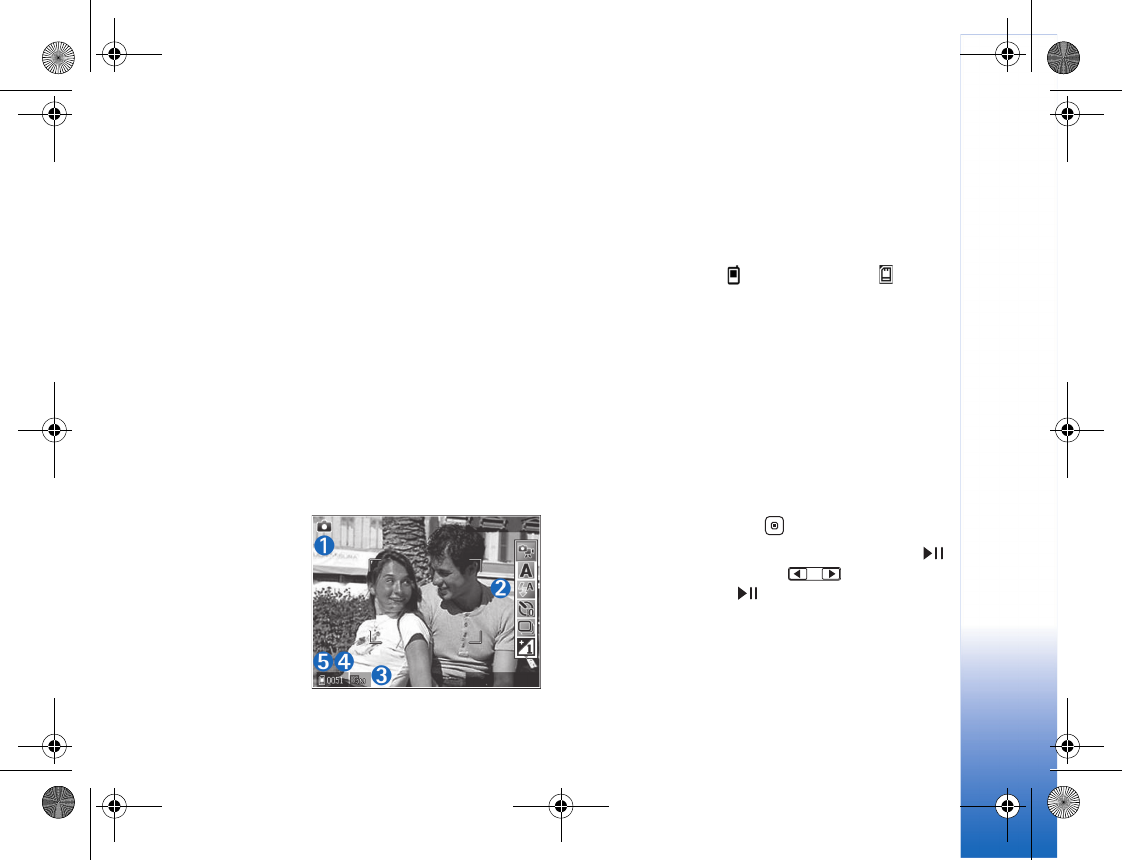
Camera
29
Saving the captured image may take longer if you change
the zoom, lighting, or color settings.
To free memory before taking a picture, in the main
display, select Options > Go to free memory (only
available if you have backed up images or video clips).
Still image camera indicators
The still image camera viewfinder (main display) displays
the following:
• The current capture mode indicator (1)
• The active toolbar (2), which you can scroll through
before capturing the image to change Scene modes,
adjust the flash setting, activate the self-timer or
sequence mode, or adjust Exposure compensation,
White balance or Color tone (the active toolbar is not
displayed during image capture). See "Active toolbar,",
p. 29.
•The image
resolution
indicator (3)
indicates
whether the
quality of the
image is Print
2M - Large
(1600x1200
resolution), Print
1M - Medium (1152x864 resolution) or Multimedia
message 0.3M - Small (640x480 resolution).
• The image counter (4) displays the estimated number
of images you can capture using the current image
quality setting and memory in use (the counter is not
displayed during focus and image capture).
• The device memory ( ) and memory card ( )
indicators (5) show where images are saved.
To display all viewfinder indicators, select Options >
Show icons. To display only the camera status indicators,
select Hide icons.
Active toolbar
You can use the active toolbar as a shortcut to select
items and adjust different settings before taking a picture
or recording a video.
If you are using the main display as a viewfinder, scroll to
the item you want, and press .
If you are using the cover display as a viewfinder, press
to display the active toolbar, use to scroll to the
item you want, and press .
R1114_en.book Page 29 Thursday, October 19, 2006 3:43 PM
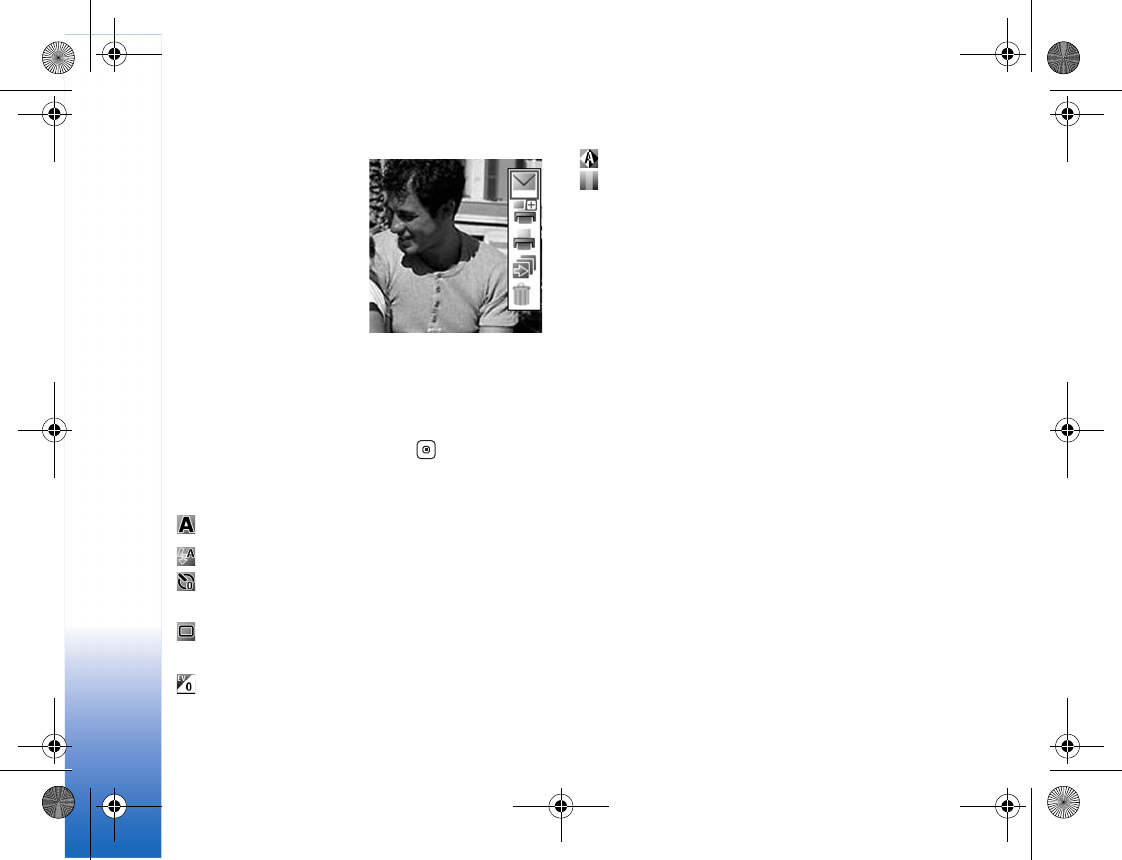
Camera
30
The available options vary
depending on the capture
mode. You can also define
whether the active
toolbar is always visible
on the display or
activated by a key press.
If you want the active
toolbar to be visible on
the main display before
and after taking a picture
or recording a video, select Options > Show icons.
If you want the active toolbar to be visible on the main
display only when required, select Options > Hide icons.
To activate the active toolbar, press .
Before taking a picture or recording a video, in the active
toolbar, select from the following:
to select the scene
to select the flash mode (images only)
to activate the self-timer (images only). See "You in
the picture—self-timer," p. 33.
to activate the sequence mode (images only). See
"Take pictures in a sequence," p. 33.
to adjust the exposure compensation (images only)
to adjust white balance
to select a color effect
The icons change depending on the current status of the
setting.
The available options may vary depending on the view you
are in.
See also active toolbar options in "After taking a picture,"
p. 30, "After recording a video," p. 34, and "Active toolbar,"
p. 29 in My Stuff.
After taking a picture
After you take a picture, there are several things you can
do with the image using the active toolbar in the main
display (available only if Show captured image is set to
On in the still image camera settings).
If you do not want to keep the image, select Delete.
To send the image using multimedia, e-mail, Bluetooth
connectivity, or infrared, or upload it to your online album,
press the call key, or select Send. For more information, see
"Messaging," p. 55, "Bluetooth connectivity," p. 112. This
option is not available during an active call. You can also
send the image to a call recipient during an active call.
Select Send to caller (only available during an active call).
R1114_en.book Page 30 Thursday, October 19, 2006 3:43 PM
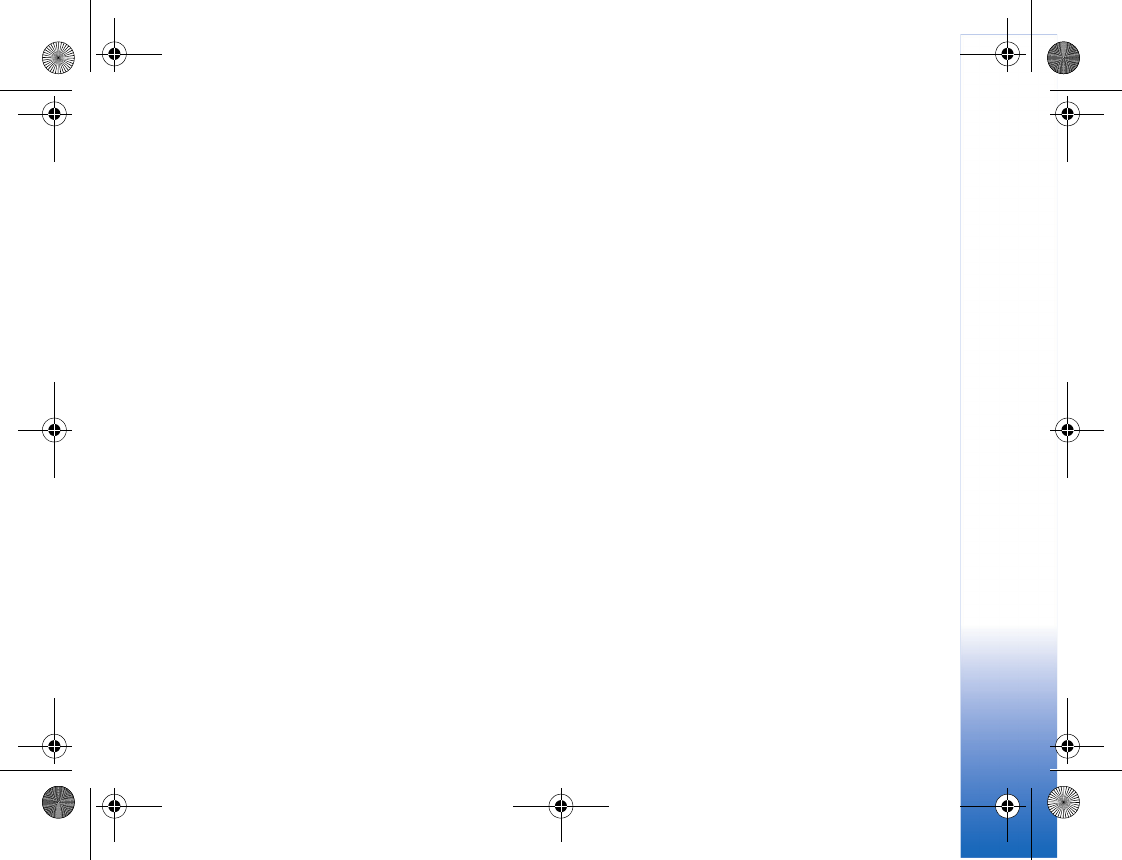
Camera
31
To tag images to the print basket for later printing, select
Add to Print Basket.
To print the picture, select Print.
To capture a new image, select New image.
To rename the image, select Options > Rename image.
To use the picture as wallpaper in the active idle mode,
select Options > Set as wallpaper.
Still image camera settings
There are two kinds of settings for the still image camera;
those which you can select using the active toolbar, and
the main settings. To adjust the active toolbar settings, see
"Adjust color and lighting," p. 32. Settings made using the
active toolbar return to the default settings after you close
the camera, but the main settings remain the same until
you change them again. To change the main settings,
select Options > Settings and from the following:
Image quality— Print 2M - Large (1600x1200
resolution), Print 1M - Medium (1152x864 resolution) or
Multimedia message 0.3M - Small (640x480 resolution)
If you want to print the image, select Print 2M - Large. If
you want to send it through e-mail, select Print 1M -
Medium. To send the image through MMS, select
Multimedia message 0.3M - Small.
Add to album—Select whether you want to save the
image to a certain album in My Stuff. If you select Yes, a
list of available albums opens.
Show captured image—Select On if you want to see the
captured image after it is taken or Off if you want to
continue taking pictures immediately.
Default image name—Define the default name for the
captured images.
Extended digital zoom —Select On to allow the zoom
increments to be smooth and continuous between digital
and extended digital zoom. If you want to limit the zoom
to where the selected image quality is maintained, select
Off.
Capture tone—Select the tone you want to hear when
you take a picture.
Memory in use—Select where to store your images.
Restore camera settings—Select OK to return the default
values to the camera settings.
Flash
Keep a safe distance when using the flash. Do not use the
flash on people or animals at close range. Do not cover
the flash while taking a picture.
R1114_en.book Page 31 Thursday, October 19, 2006 3:43 PM
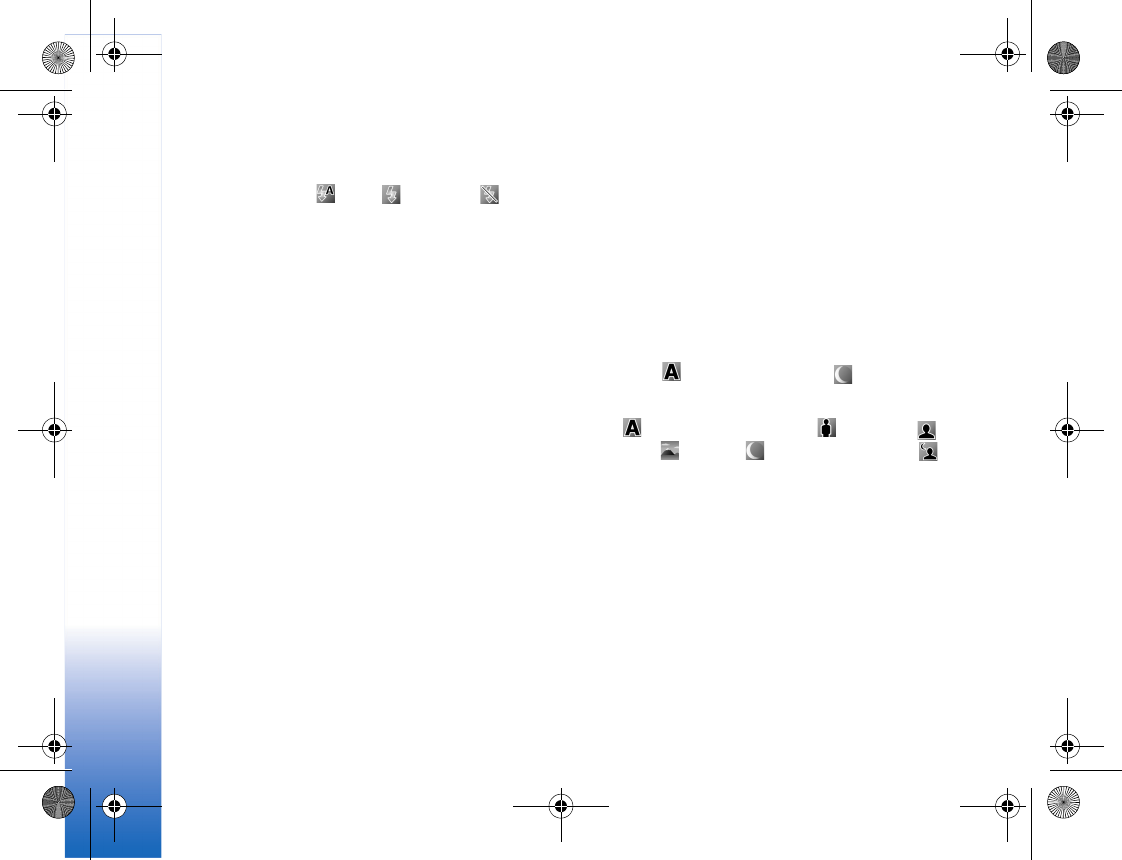
Camera
32
The camera has an LED flash for low light conditions. The
following flash modes are available for the still image
camera: Automatic (), On (), and Off ().
To select the desired flash mode, use the active toolbar.
Adjust color and lighting
To enable the camera to reproduce colors and lighting
more accurately, or to add effects to your pictures or
videos, scroll through the active toolbar. Select from the
following options: Scene modes, Flash mode, Switch to
sequence mode, Exposure compensation, White
balance and Color tone. Not all options are available in
Video mode.
The screen display changes to match any settings you
make, so that you see how the change affects the pictures
or videos.
These settings return to the default settings when you
close the camera.
If you select a new scene, the color and lighting settings
are replaced by the selected scene. See "Scenes," p. 32.
You can change the settings after selecting a scene if
necessary.
Scenes
A scene helps you find the correct color and lighting
settings for the current environment. Select a scene for
taking pictures or recording video clips from the scene list.
The settings of each scene have been set according to a
certain style or environment.
In the main display, scroll through the active toolbar, and
select from the following options:
Video scenes
Automatic ( ) (default) and Night ().
Image scenes
Auto ( ) (default), User defined (), Portrait (),
Landscape (), Night (), and Night portrait ().
When you take pictures, the default scene is Auto. You can
select the User defined scene as the default scene.
To make your own scene suitable for a certain
environment, in the main display, scroll to User defined,
and select Options > Change. In the user defined scene
you can adjust different lighting and color settings. To
copy the settings of another scene, select Based on scene
mode and the desired scene. In the cover display, select
Settings > User scene > Change. To copy the settings of
another scene, select Based on scene.
R1114_en.book Page 32 Thursday, October 19, 2006 3:43 PM
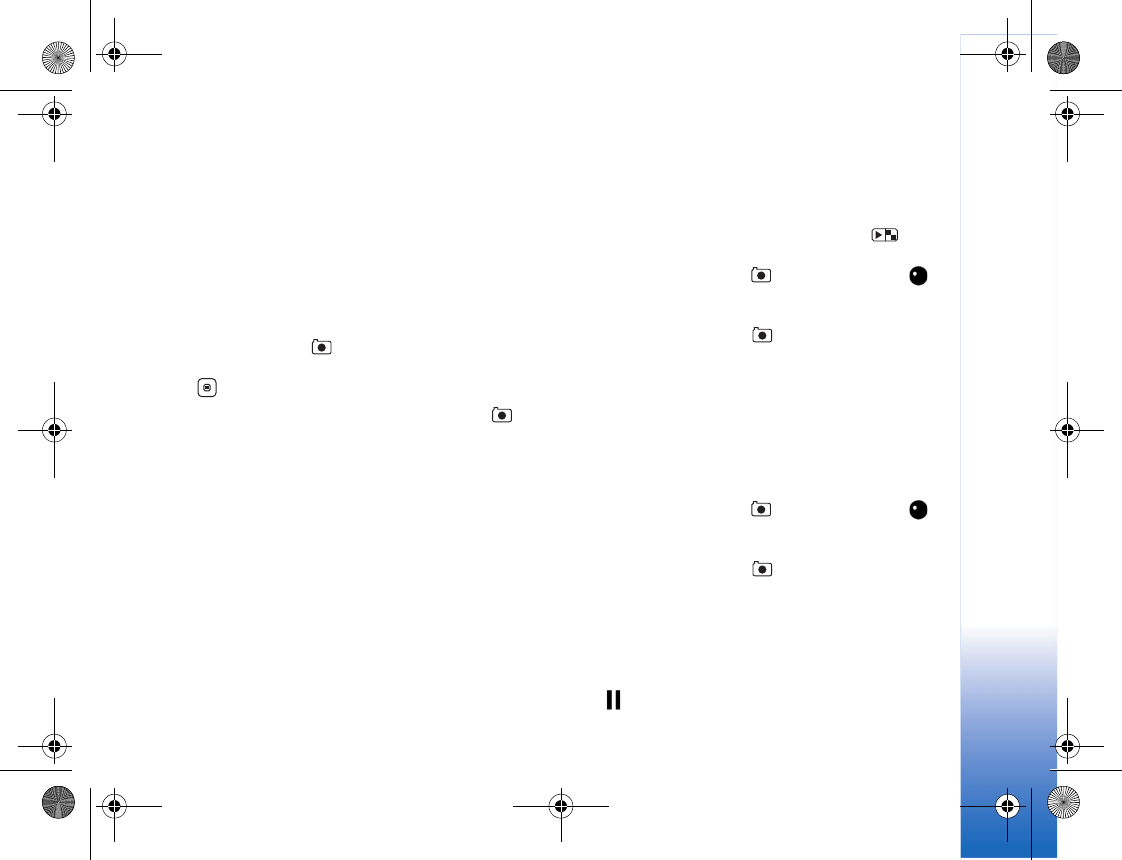
Camera
33
Take pictures in a sequence
To set the camera to take pictures in a sequence (if enough
memory is available), using the active toolbar in the main
display, select Sequence mode.
In sequence mode, you can select Burst to capture six
images in quick succession, or set an interval between
time-lapse shots. You can set the time-lapse interval to 5
sec, 10 sec, 30 sec, 1 min, 5 min,10 min or 15 min.
To take pictures, press . After you take the pictures,
they are shown in a grid on the display. To view a picture,
press to open it.
To return to the sequence mode viewfinder, press .
You in the picture—self-timer
Use the self-timer to delay the capture so that you can
include yourself in the picture. To set the self-timer delay,
in the active toolbar, select Self timer > 2 seconds, 10
seconds, or 20 seconds. To activate the self-timer, select
Activate. The device beeps when the timer is running. The
camera takes the picture after the selected delay elapses.
To switch off Self timer, in the active toolbar, select Self
timer > Off.
You can also use the self-timer in the sequence mode.
Record videos
To record videos using the cover display as the viewfinder
(fold closed):
1If the camera is in the Image mode, press to
switch to Video mode.
2To start recording, press . The red record icon is
shown and a tone sounds, indicating that recording
has started.
3To stop recording, press or select Stop. The video
clip is automatically saved to the Imgs. & video folder
of My Stuff. See "My Stuff," p. 46. The maximum
length of the video is 60 minutes (if enough memory is
available).
To record videos using the main display as the viewfinder:
1Open the fold. If the camera is in the Image mode,
select Video mode from the active toolbar.
2To start recording, press . The red record icon is
shown and a tone sounds, indicating that recording
has started.
3To stop recording, press or select Stop. The video
clip is automatically saved to the Imgs. & video folder
of My Stuff. See "My Stuff," p. 46. The maximum
length of the video is 60 minutes (if enough memory is
available).
To pause recording at any time, select Pause. The pause
icon ( ) blinks on the display. Video recording
R1114_en.book Page 33 Thursday, October 19, 2006 3:43 PM
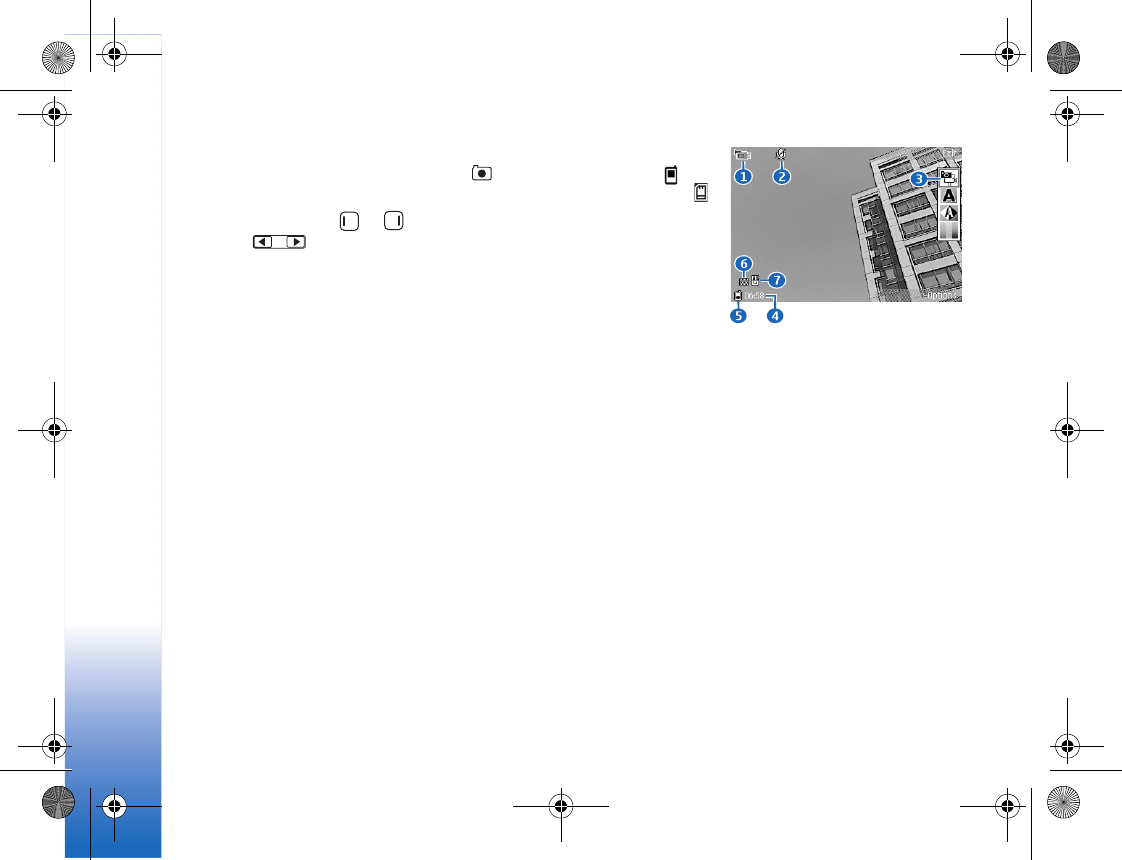
Camera
34
automatically stops if recording is set to pause and there
are no keypresses within a minute. Press the again to
resume recording.
To zoom in or out, press or . (if using the main
display), or (if using the cover display).
To make lighting and color adjustments before recording
a video, scroll to items on the active toolbar. See "Adjust
color and lighting," p. 32 and "Scenes," p. 32.
To free memory before recording a video, in the main
display, select Options > Go to free memory (only
available if you have backed up images or video clips).
Video capture indicators
The video viewfinder (main display) displays the following:
• The current capture mode indicator (1)
• The audio mute on indicator (2)
• The active toolbar (3), which you can scroll through
before recording to change Scene modes or adjust
White balance or Color tone (the toolbar is not
displayed during recording)
• The total available video recording time (4). When you
are recording, the current video length indicator also
shows the elapsed time and time remaining.
•The device
memory ( ) and
memory card ( )
indicators (5)
show where
videos are saved.
• The video quality
indicator (6)
indicates
whether the
quality of the video is High, Normal, or Sharing.
• The video clip file type (7)
To display all viewfinder indicators, select Options > Show
icons. Select Hide icons to display only the video status
indicators, and during the recording, the available record
time, zoom bar when zooming, and the selection keys.
After recording a video
After you record a video clip, select the following from the
active toolbar in the main display (available only if Show
captured video is set to On in Video settings):
To immediately play the video clip you just recorded, select
Play.
If you do not want to keep the video, select Delete.
To send the video clip using multimedia, e-mail, Bluetooth
connectivity, or infrared, or upload it to your online album,
R1114_en.book Page 34 Thursday, October 19, 2006 3:43 PM
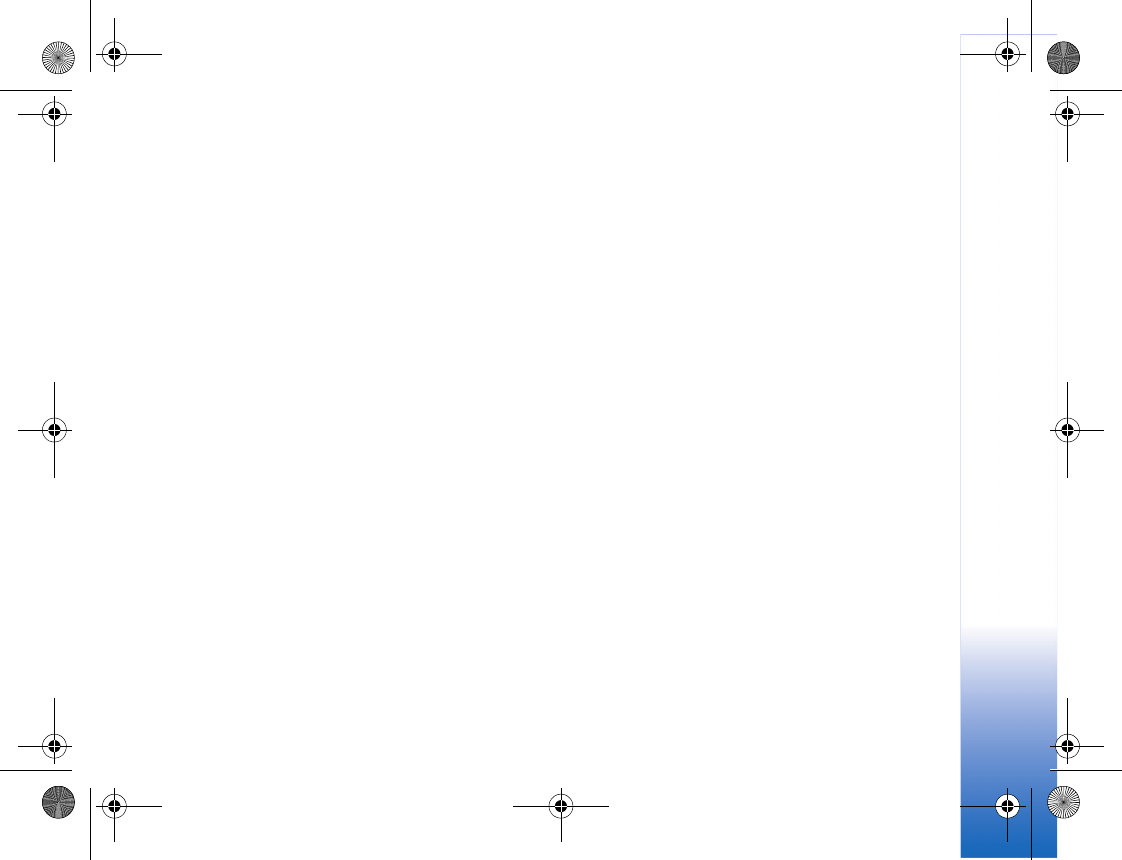
Camera
35
press the call key, or select Send. For more information, see
"Messaging," p. 55, "Bluetooth connectivity," p. 112. This
option is not available during an active call. You cannot
send video clips saved in the .mp4 file format in a
multimedia message. You can also send the video clip to a
call recipient during an active call. Select Send to caller.
To record a new video clip, select New video.
To rename the video, select Options > Rename video.
Video settings
There are two kinds of settings for the video recorder;
those which you can select using the active toolbar, and
main settings. To adjust the active toolbar settings, see
"Adjust color and lighting," p. 32. The active toolbar
settings return to the default settings after you close the
camera, but the main settings remain the same until you
change them again. To change the main settings, in the
main display, select Options > Settings and from the
following:
Video quality—Set the quality of the video clip to High
(best quality for long term usage and playback on a
compatible TV or PC and handset), Normal (standard
quality for playback through your handset), or Sharing
(limited video clip size to send using multimedia message).
If you want to view the video on a compatible TV or PC,
select High, which has CIF resolution (352x288) and the
.mp4 file format. To send the video clip through MMS,
select Sharing (QCIF resolution, .3gp file format). The size
of the video clip recorded with Sharing is limited to 300
KB (about 20 seconds in duration) so that it can be
conveniently sent as a multimedia message to a
compatible device.
Audio recording—Select On if you want to record both
image and audio.
Add to album—Select whether you want to add the
recorded video clip to a certain album in My Stuff. Select
Yes to open a list of available albums.
Show captured video—Select whether you want the first
frame of the recorded video clip to be shown on the
display after the recording stops. Select Play from the
active toolbar to view the video clip.
Default video name—Define the default name for the
captured video clips.
Memory in use—Define the default memory store: device
memory or memory card (if inserted).
Restore camera settings—Select OK to return the default
values to the camera settings.
R1114_en.book Page 35 Thursday, October 19, 2006 3:43 PM
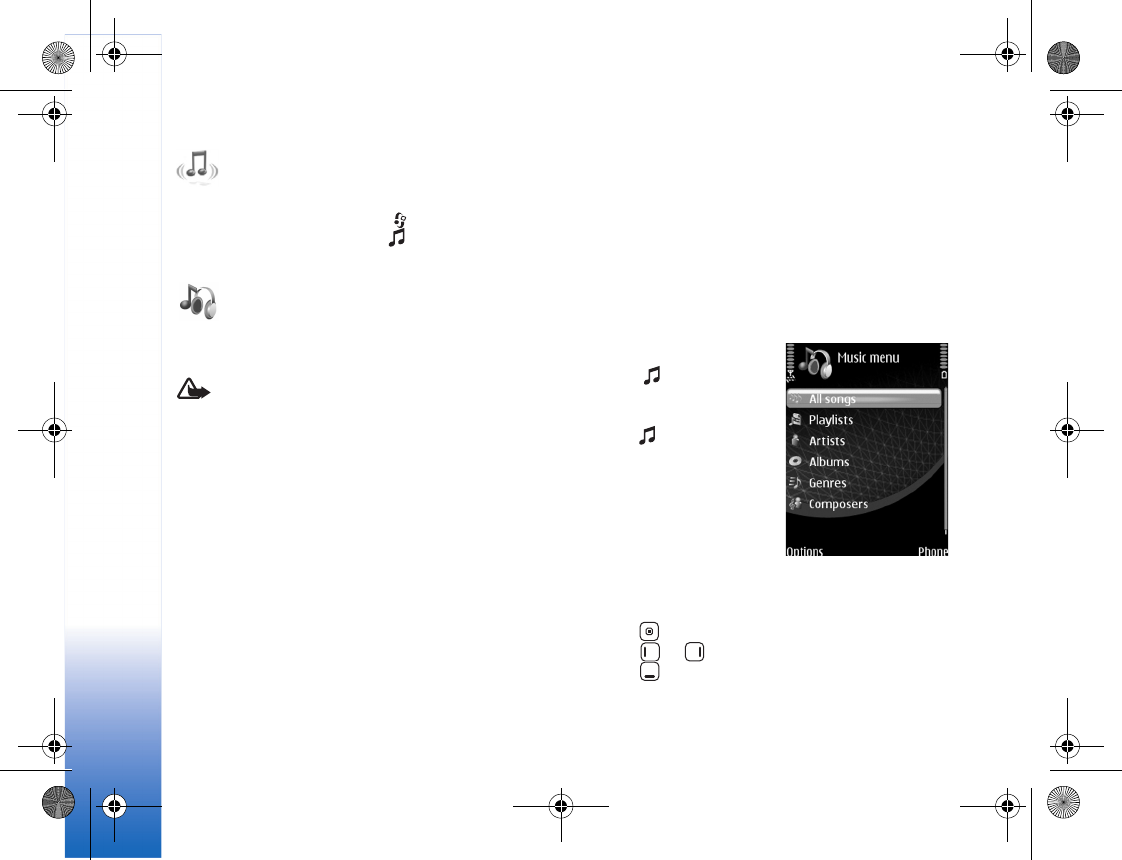
Cingular Music
36
Cingular Music
To access Cingular Music press , and select Cingular
Music. Alternatively, just press .
Music player
Music player lets you listen to music on your
device using the loudspeaker or headset, and lets
you create playlists of songs.
Warning: Do not hold the device near your ear when
the loudspeaker is in use, because the volume may be
extremely loud.
You can listen to music with the fold open or closed. If you
are listening to music when a call comes in, the music
pauses when you answer the call, and resumes shortly
after the end of the call. The music also pauses if you use
the video camera.
Music player supports files with extensions AAC, AAC+,
eAAC+, MP3, WMA, WAV, 3G2, 3GP, 3GPP, 3GPP2, MPEG,
MP4, M4A, DCF, ODF, ASF, and M3U. Music player does
not necessarily support all features of a file format or all
the variations of file formats.
Copyright protections may prevent some images, music
(including ringing tones), and other content from being
copied, modified, transferred or forwarded.
Play music
To play music with the fold
open, do the following:
1Press and select
Music player.
Alternatively, press and
hold to go to the
Music menu view.
2In Music menu view,
select a category such as
All tracks or Albums.
3Select the music you want
to play.
In Now playing view, use the scroll keys to control
playback:
• Press to play or pause a song
• Press or to skip backwards or forwards
• Press to stop playback
R1114_en.book Page 36 Thursday, October 19, 2006 3:43 PM
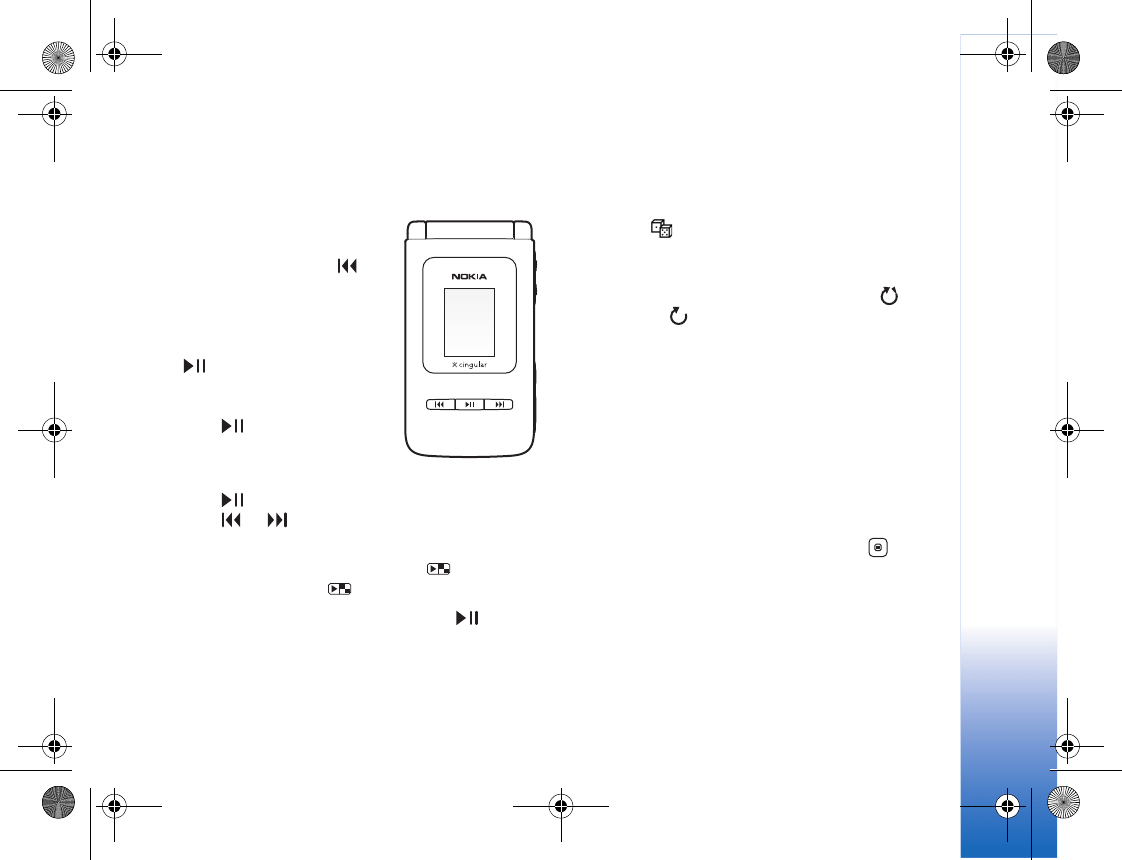
Cingular Music
37
To return from Now playing view to Music menu view,
where you can select more music, select Options > Go to
Music menu.
To play music with the fold closed,
do the following:
1In the idle mode, press .
2In Music menu view, use the
volume keys on the side of the
device to select a category such
as All tracks or Albums. Press
.
3Use the volume keys to select
the music you want to play, and
press .
In Now playing view, use the cover
keys to control playback:
• Press to play or pause a song
• Press or to skip backwards or forwards
To return to Music menu view from Now playing view,
where you can select more music, press . To return to
Now playing view, press again.
To return to view from the idle mode, press .
Random and repeat play
To switch random play on or off, select Options >
Shuffle > On or Off. When random play is selected, the
shuffle icon is displayed in the top right corner.
To repeat the current song, all songs, or to switch repeat
off, select Options > Repeat > Repeat song or All or Off.
When repeat is selected, either the repeat song or the
repeat all icon is displayed in the top right corner.
Playlists
Create a playlist
To create a playlist of songs, in the main display, do the
following:
1In Music menu view, select Playlists.
2Select Options > Create playlist.
3Enter a name for the playlist, and select OK.
4Expand and collapse an artist title to find the songs
you want to include in the playlist. Press to add
items. To show the song list under an artist title, scroll
to the right. To hide the song list, scroll to the left.
5When you have made your selections, select Done.
Add songs to a playlist
You can add songs to an existing playlist or first create a
new playlist.
R1114_en.book Page 37 Thursday, October 19, 2006 3:43 PM
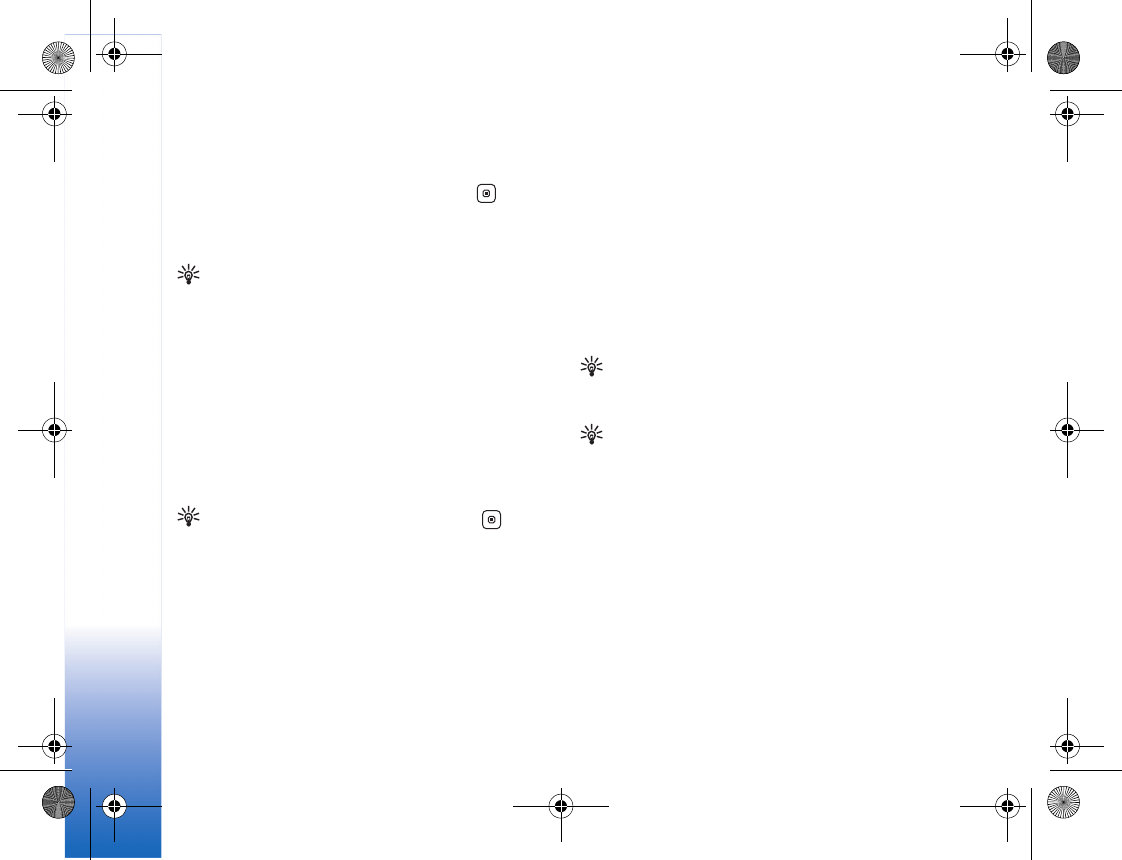
Cingular Music
38
1In a song list, select Options > Add songs.
2Expand and collapse an artist title to find the songs
you want to include in the playlist. Press to add
items. To show the song list under an artist title, scroll
to the right. To hide the song list, scroll to the left.
3When you have made your selections, select Done.
Tip! You can add songs to a playlist that is currently
playing.
To search for a song, begin entering letters with the
keypad.
Reorder songs
1Select Options > Reorder list in a playlist.
2The selected song is ready to be moved. Scroll up or
down to move it or leave it there, and select Drop.
3Scroll to the song you want to move, and select Grab.
4Scroll to a new position, and select Drop.
5When you have reordered the list, select Done.
Tip! To grab and drop, you can also press .
Remove songs from a playlist
You can remove songs from a playlist.
1Scroll to a song in a playlist.
2Select Options > Remove from playlist.
3Select Yes to confirm. This deletion does not delete the
song from the device; it only removes it from the
playlist.
Add items from views to a playlist
You can add songs, albums, artists, genres, and composers
from different views of Music menu to existing or new
playlists.
1In a view opened from Music menu, select an item.
2Select Options > Add to a playlist > Saved playlist or
New playlist.
3If you select New playlist, enter a name for the playlist,
and select OK.
4If you select Saved playlist, select the playlist and OK.
Tip! In some of the views you can select multiple
songs to be added by selecting Options > Mark/
Unmark > Mark.
Tip! You can add a song that you are currently
listening to to a playlist.
Automatic playlists
The following playlists appear in the playlist view
automatically:
Most played tracks—Includes the 40 most-played songs
listed from the most recently played songs
Recent tracks—Includes 40 most recently played songs in
reverse order, ending with the most recently played song
Recent additions—Includes songs that you have added to
the library within the past week
R1114_en.book Page 38 Thursday, October 19, 2006 3:43 PM
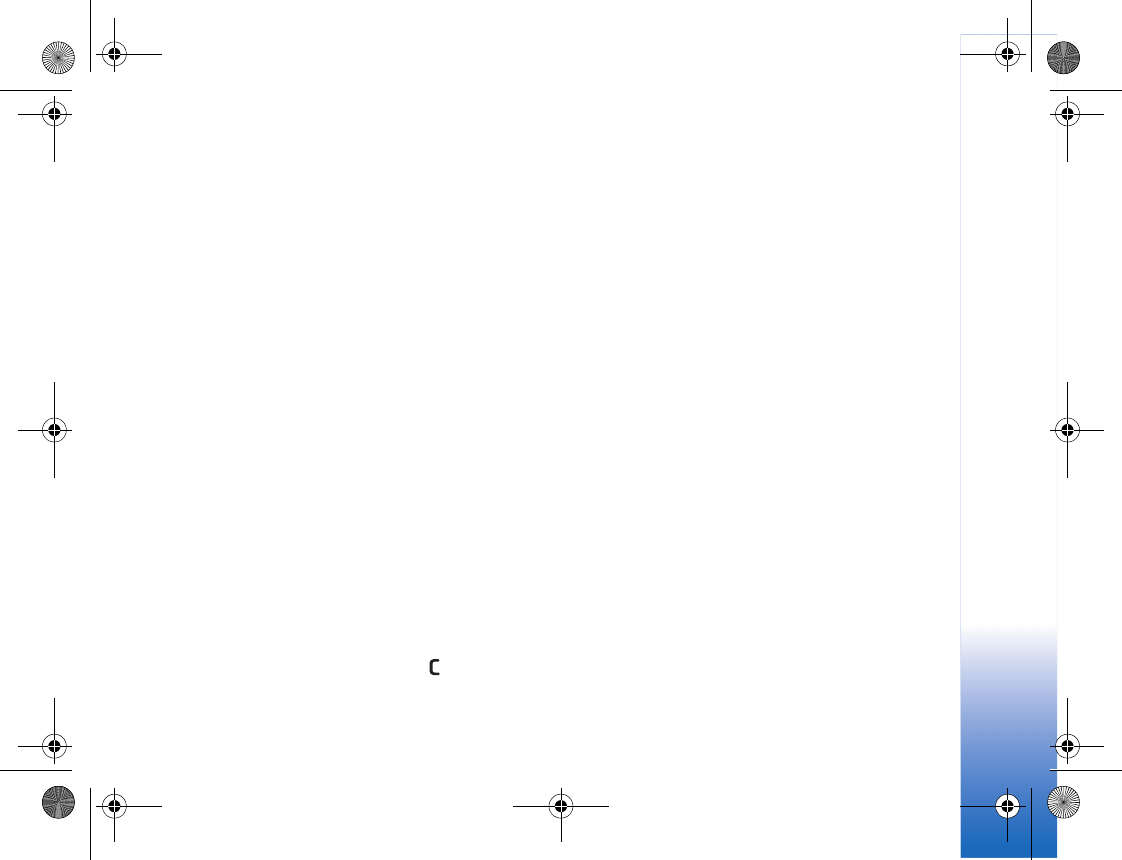
Cingular Music
39
Visualizations
Visualizations are animations that are timed to the beat of
the music, and they show in the main display. To start a
visualization, in Now playing view, select Options >
Visualization and a visualization.
To return to Now playing view, select Close.
Modify audio
Equalizer
To modify the tone of the music playback, in the main
display, select Options > Equalizer.
To use one of the preset equalizer settings, scroll to it, and
select Activate. Each preset has different settings on an 8–
band graphic equalizer.
Modify equalizer presets
1To create a new preset, select Options > New preset.
To modify an existing preset, select Options > Edit.
2To adjust the frequency settings, scroll left or right to
select a frequency band and up or down to increase or
decrease the volume of the selected frequency band.
3To reset the settings to their original values, select
Options > Reset to defaults.
To delete a preset, scroll to it, and press . The default
presets cannot be deleted.
Audio settings
To modify the balance and stereo image or to enhance
bass, select Options > Audio settings.
Rename items
1In the Music menu view, select Artist, Album, Genre,
or Composer > Options > Rename.
2Enter the new name, and select OK. All songs that
belong to the selected artist, album, genre, or
composer are updated.
Set a song as a ringing tone
1Select a song (file size smaller than 600kB).
2Select Options > Set as ringing tone. The selected
song is set as the ringing tone for the active profile.
Some media files, such as images, music, or video clips, are
protected with digital usage rights. The activation keys for
such files may allow or restrict their usage. For example,
you may listen to a music track only a limited number of
times. During one playback time, you may rewind or fast-
forward the track, or pause it, but once you stop the track,
you have used one usage time.
Copyright protections may prevent some images, music
(including ringing tones), and other content from being
copied, modified, transferred or forwarded.
R1114_en.book Page 39 Thursday, October 19, 2006 3:43 PM
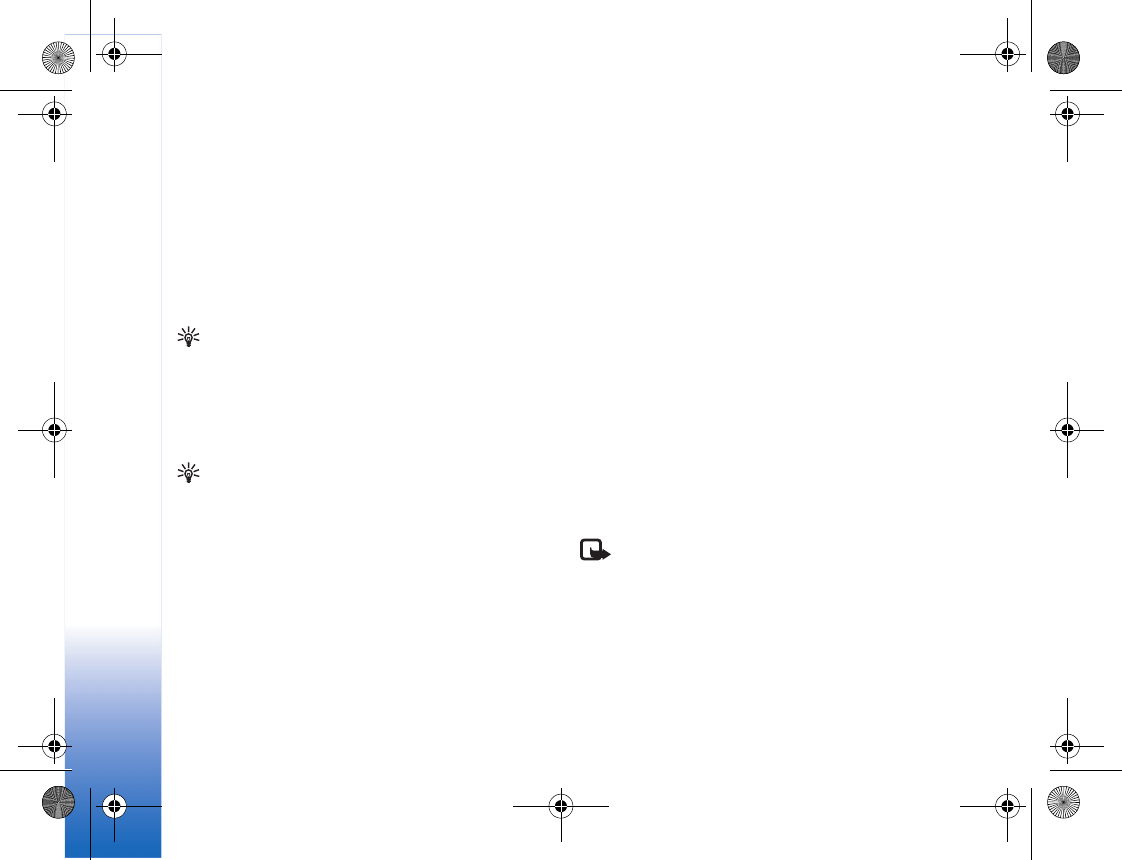
Cingular Music
40
Add music
When you insert a memory card, the device asks whether
you want to scan the memory card for new music files. If
you select Yes, music playback stops while the device
scans the memory card and updates the music library.
After you add or remove music files in the device, you can
update your music library. In Music menu view, select
Options > Update Music library.
Tip! You can transfer music files from your device to
a compatible memory card (if inserted) with Nokia
Audio Manager available in Nokia PC Suite.
If you remove the memory card while music is playing,
playback stops while the device removes any songs on the
memory card from your music library.
Tip! You can synchronize music files between a
compatible PC and your device using Windows Media
Player.
You can transfer music from a compatible PC or other
compatible devices using a USB cable or Bluetooth
connection. For details about connecting your device, see
"Settings," p. 99.
Transfer music
You can use three different methods to transfer music to
your device:
• To synchronize music files from a compatible PC to your
device with Windows Media Player, attach the USB
cable and select Media player as the connection
method. Use this method to copy WMDRM protected
music (both purchased and subscription) to your
device. This option copies both the music and the
license to use it.
• To use Nokia Audio Manager in Nokia PC Suite, attach
the USB cable and select PC Suite as the connection
method. Use this method to rip and convert music to
newer formats like eAAC+.
• To view your device on your PC as an external hard
drive, connect to your PC with Cable or Bluetooth
connectivity. If you are using the USB cable, select
Data transfer. Use this method to be able to drag and
drop files to your device’s memory card. You may not be
able to transfer data that has been protected against
copying.
Get connected with Windows Media Player
Note: Windows Media Player version 10 or later is
required to synchronize music files. If you have an older
version of Windows Media Player, please visit the
Microsoft website to download a later version.
To synchronize music files from a compatible PC to your
device with Windows Media Player:
R1114_en.book Page 40 Thursday, October 19, 2006 3:43 PM
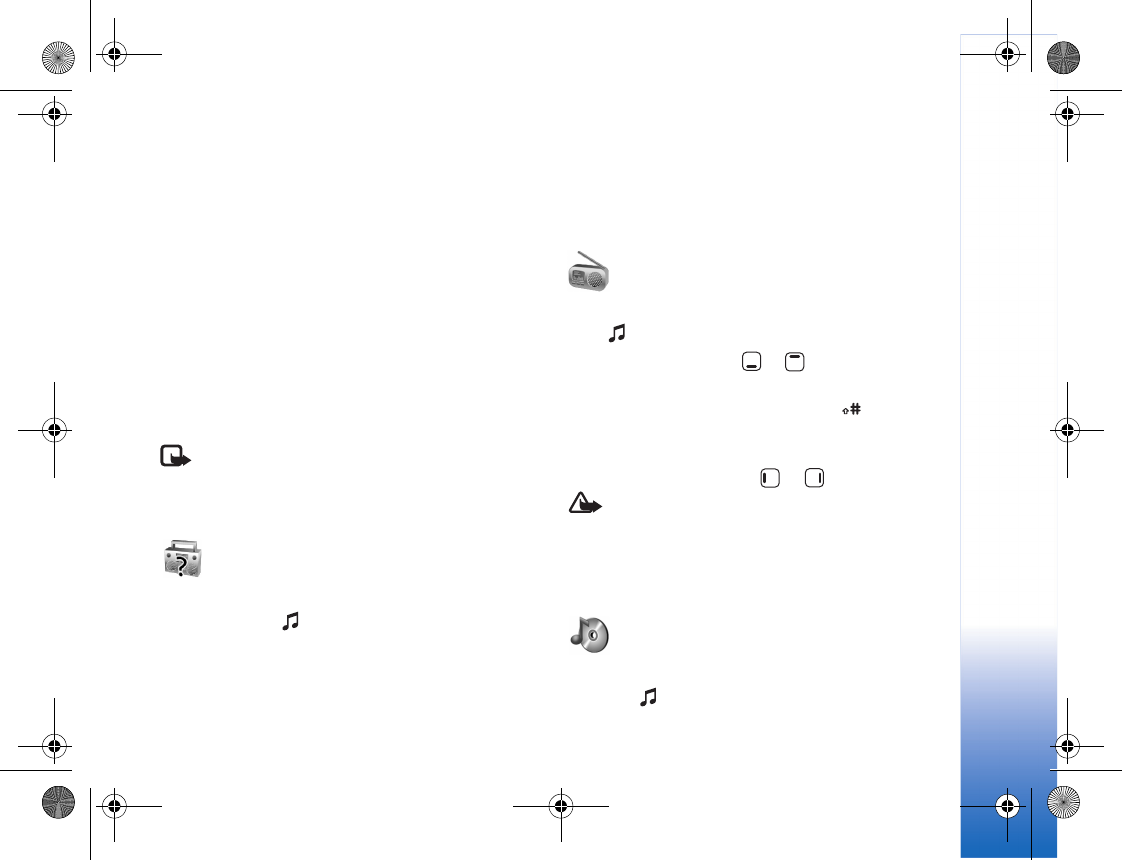
Cingular Music
41
1Install Windows Media Player drivers on to your PC
from the CD-ROM provided.
2Start Windows Media Player version 10 or later (or
other PC client that can handle purchased content).
3Connect your device to the PC using the USB cable and
select Media player mode. Windows recognizes a new
device is connected and attempts to install the required
driver.
4At the first screen of the install wizard, select ‘No, not
this time’. At the second screen, select ‘Install the
software automatically (Recommended)’.
When the driver installation is complete, your Nokia
device appears under ‘Portable devices’ in the Windows
Media Player window. You are now ready to start
synchronizing music to your device.
Note: Upgrading to a later version of Windows
Media Player may require you to install a different
version of driver.
Music ID
Music ID allows you to find out title, artist and
other information about a song. To open the
application, press , and select Music ID. From the
following, select:
ID song! - to connect to the web. If the song is identified,
the relevant song information is returned to your device.
manage ids - to place identified songs in this folder.
help me out - to open online help.
exit - to close the application.
MobiRadio
MobiRadio allows you to listen to digital music
channels on your device. To open the application,
press , and select MobiRadio.
To change channels, press or . Pause for a moment
to allow the device to respond.
To enter a channel number directly, press to open the
channel guide, followed by the channel number, and then
press OK.
To change the volume, press or .
Warning: Do not hold the device near your ear when
the loudspeaker is in use, because the volume may be
extremely loud.
For more information, visit www.mobitv.com
Shop Music
Shop Music allows you to purchase music
online. To connect to Cingular’s music download
site, press , and select Shop Music.
R1114_en.book Page 41 Thursday, October 19, 2006 3:43 PM
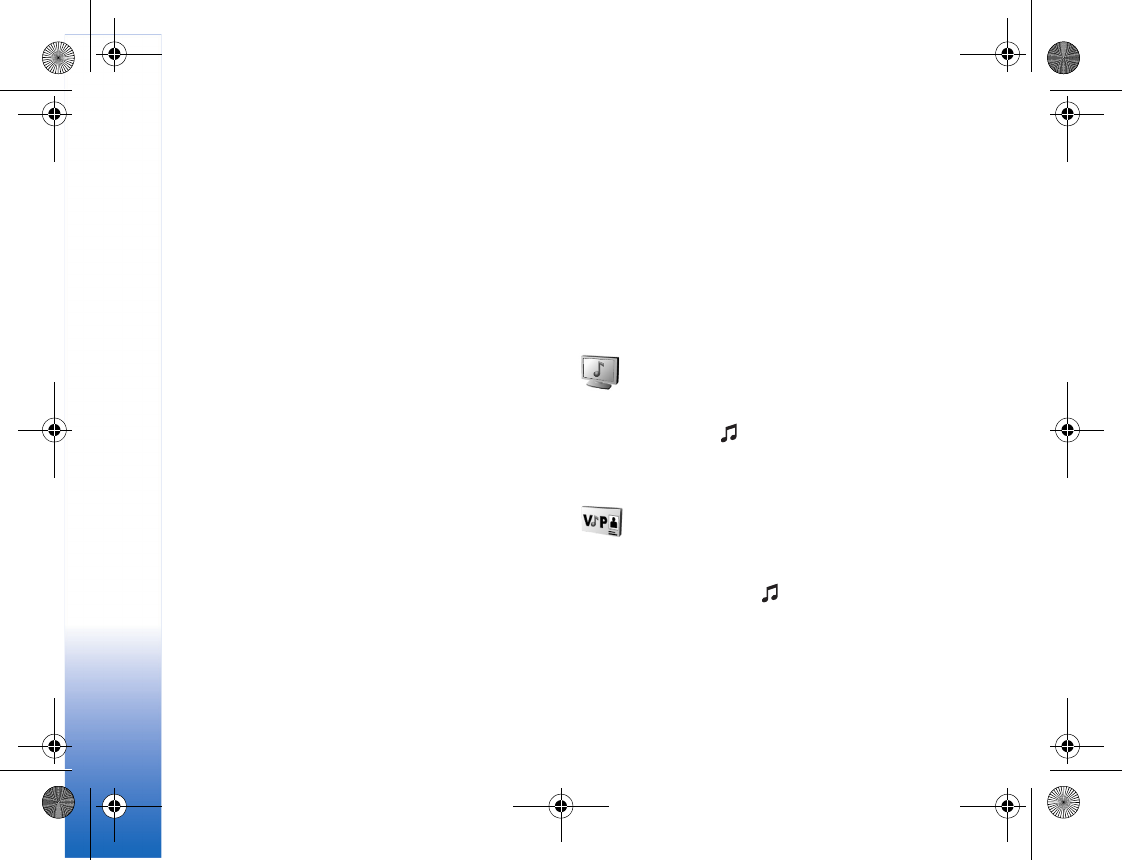
Cingular Music
42
You can search, browse, and purchase music for
downloading to your device. The variety, availability and
appearance of these services may vary.
1In Music menu view, select Options > Go to Music
shop. This option is not available if the music service
Web address has not been defined. See "Shop
settings," p. 42.
2Choose from the options on the screen to search,
browse, or select ringing tones.
Shop settings
The settings may also be predefined and not editable.
You must have valid Internet connections in order to use
this service. For more details, see "Access points," p. 102.
The availability and appearance of music shop settings
may vary.
You also must have the Web address of Music shop
defined in music shop settings.
To change or define the Web address for Music shop, in
Music menu view, select Options > Go to Music shop.
In Music shop, select Options > Settings. Define the
following:
Address:—Enter the Web address of the Music shop
service.
Default access point:—Enter the default access point. This
may be supplied by your service provider.
User name:—Enter your user name for Music shop. If this
field is left empty, you may have to enter your user name
at login.
Password:—Enter your password for Music shop. If this
field is left empty, you may have to enter your password at
login.
Music Video
Music Video allows you to purchase music videos
online. To connect to Cingular’s music video
download site, press , and select Music Video.
Contact your service provider for more information.
Billboard
Billboard allows you to obtain the latest music
industry news and information.
To access this service, press , and select Billboard. Press
OK to accept the disclaimer.
Contact your service provider for more information.
R1114_en.book Page 42 Thursday, October 19, 2006 3:43 PM
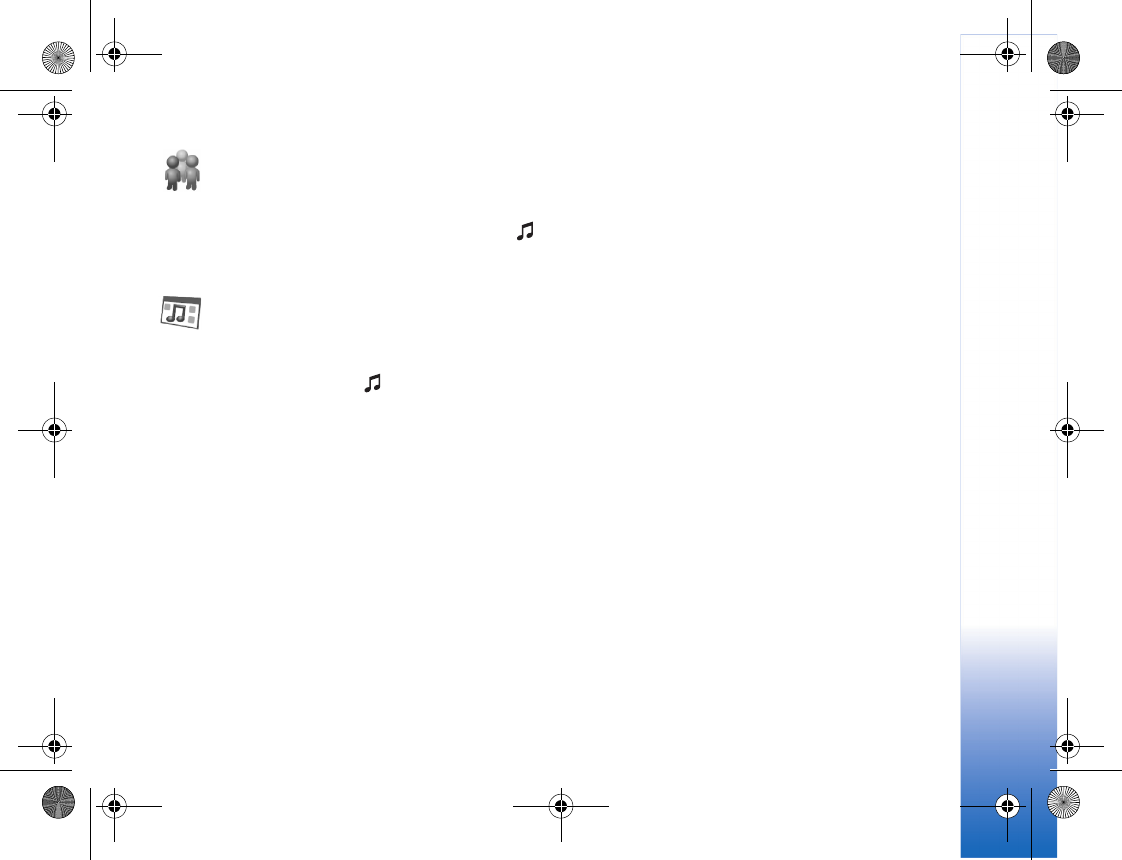
Cingular Music
43
Community
Community allows to you to interact with friends
and the community via one or more of the online
‘hot user’ communities. To open the application, press ,
and select Community
Music Apps
Music Apps allows you to purchase music related
applications to download to your device.
To open the application, press , and select Music Apps
Digital Rights Management
Content owners may use different types of digital rights
management (DRM) technologies to protect their
intellectual property, including copyrights. This device uses
various types of DRM software to access DRM protected
content. With this device you can access content protected
with WMDRM 10 and OMA DRM 1.0 (forward lock only). If
certain DRM software fails to protect the content, content
owners may ask that such DRM software's ability to access
new DRM-protected content be revoked. Revocation may
also prevent renewal of such DRM-protected content
already in your device. Revocation of such DRM software
does not affect the use of content protected with other
types of DRM or the use of non-DRM-protected content.
R1114_en.book Page 43 Thursday, October 19, 2006 3:43 PM
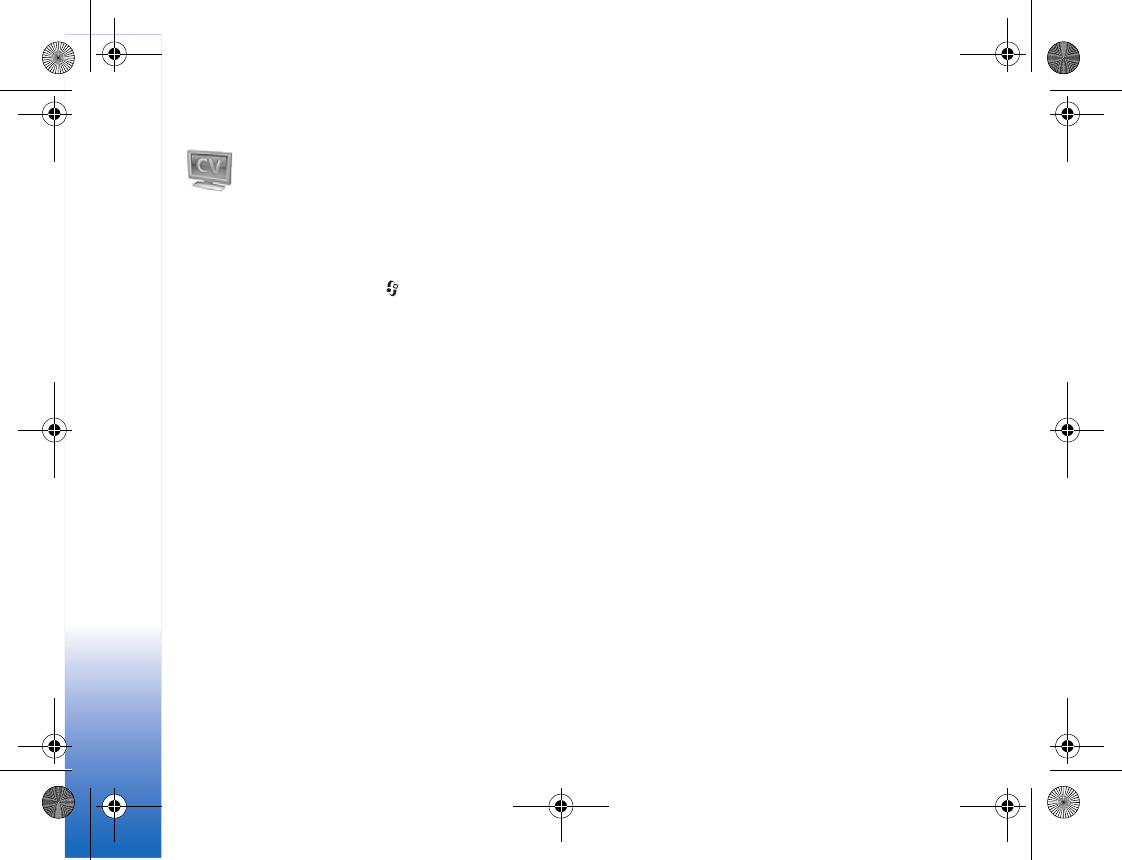
Cingular Video
44
Cingular Video
Cingular Video allows access to a range of video media
from categories including news, sport, weather, and
entertainment.
To access Cingular Video press , and select Video
(network service). Select a category and play a clip.
R1114_en.book Page 44 Thursday, October 19, 2006 3:43 PM
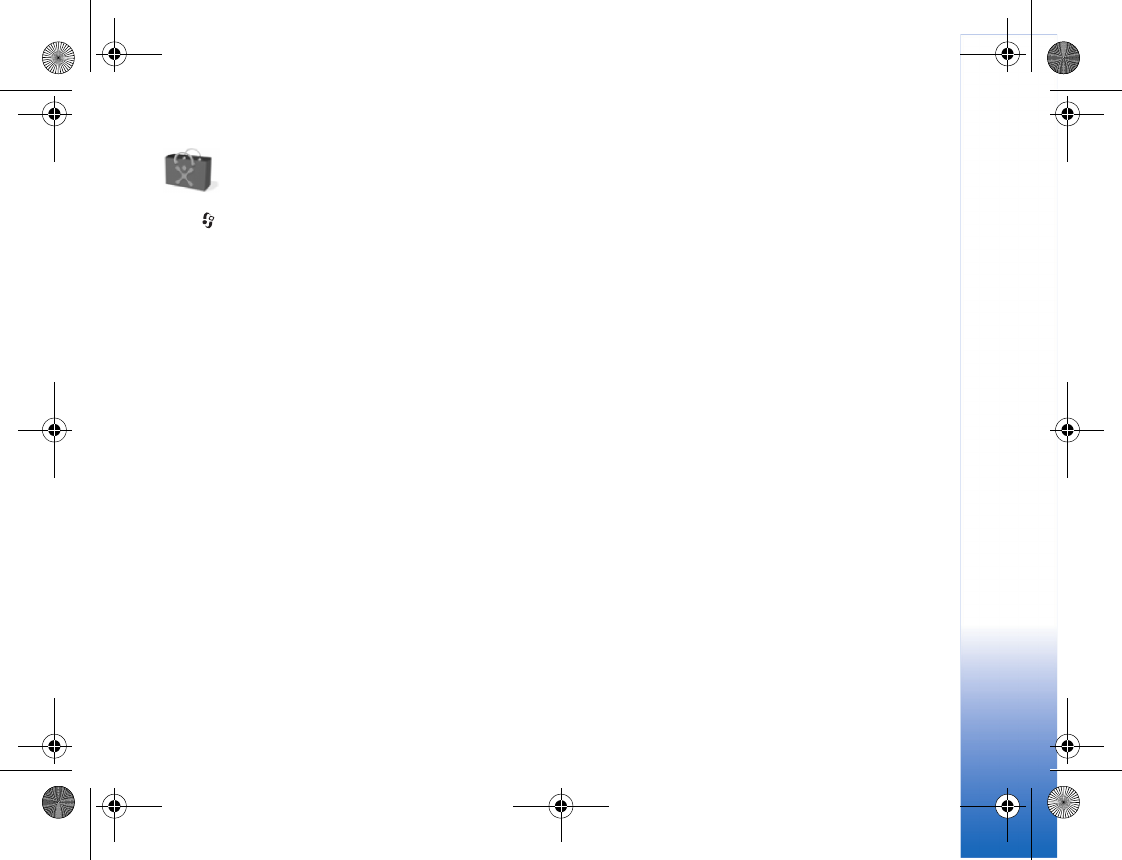
Cingular Mall
45
Cingular Mall
Press , and select Mall (network service).
Cingular Mall allows access to a range of Cingular
download sites.
For more information, contact your service provider.
R1114_en.book Page 45 Thursday, October 19, 2006 3:43 PM
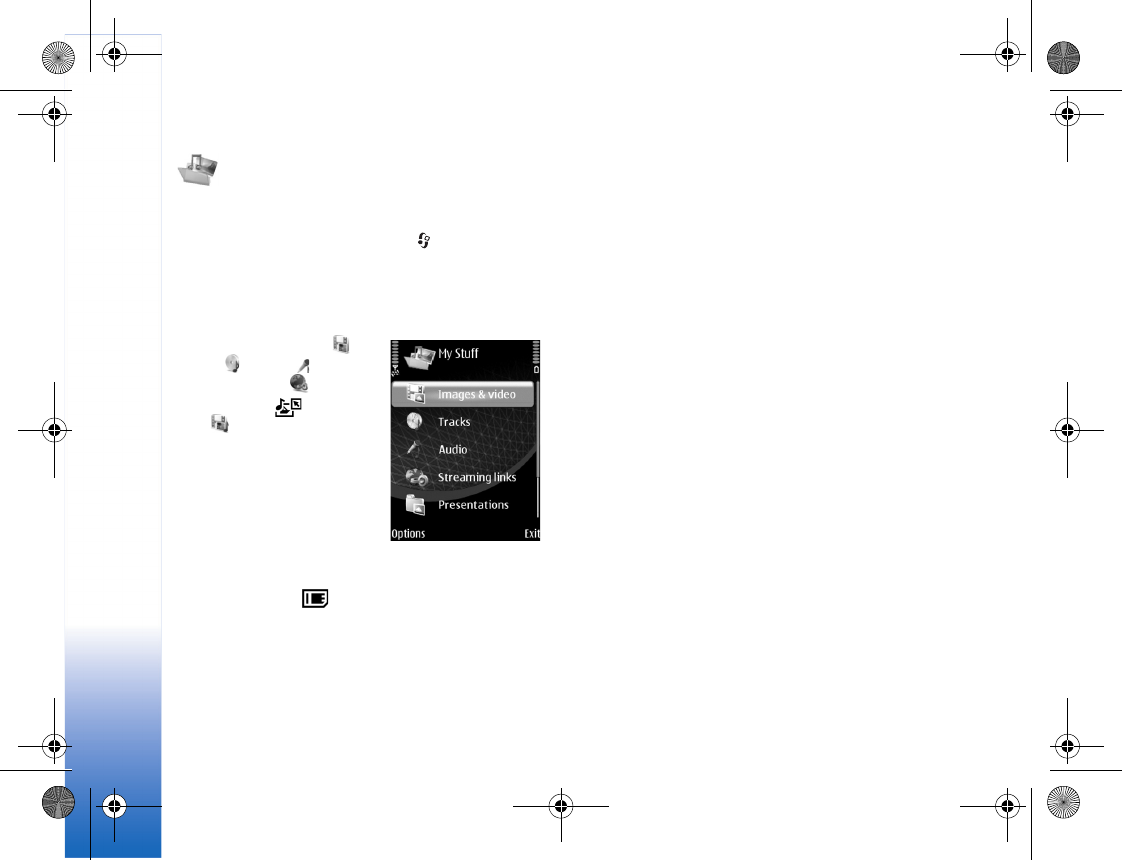
My Stuff
46
My Stuff
To store and organize your images, video clips, audio clips,
playlists, and streaming links, press , and select My
Stuff.
View and browse files
Select Images & video ,
Tracks , Audio ,
Streaming links ,
Presentations , or All
files .
You can browse and open
folders; and mark, copy, and
move items to folders. You
can also create albums; and
mark, copy, and add items to
albums. See "Albums," p. 49.
Files stored on your compatible memory card (if inserted)
are indicated with .
To open a file, select it. Video clips, .ram files, and
streaming links are opened and played in RealPlayer, and
music and audio clips in Music. See "RealPlayer," p. 90,
and "Cingular Music," p. 36.
To copy or move files to the memory card (if inserted) or to
device memory, select a file and Options > Move and copy
> Copy to memory card or Move to memory card, or
Copy to phone mem. or Move to phone mem..
To download tracks or audio clips into My Stuff using the
browser, in the Tracks or Audio folders, select Track
downl. or Audio downl.. To download images or videos, in
the Images & video folder, select the download photos or
download videos icon. The browser opens, and you can
select a bookmark from which the site can download.
Images and video clips
Pictures taken and video clips recorded with the camera
are stored in the Images & video folder in My Stuff.
Images and video clips can also be sent to you in a
multimedia message, as an e-mail attachment, through
Bluetooth connectivity, or by using infrared. To be able to
view a received image or video clip in My Stuff or in the
media player, you must save it in the device memory or on
a memory card (if inserted).
Open the Images & video folder in My Stuff. The images
and video clip files are in a loop, and ordered by date. The
number of files is displayed. To browse the files one by one,
R1114_en.book Page 46 Thursday, October 19, 2006 3:43 PM
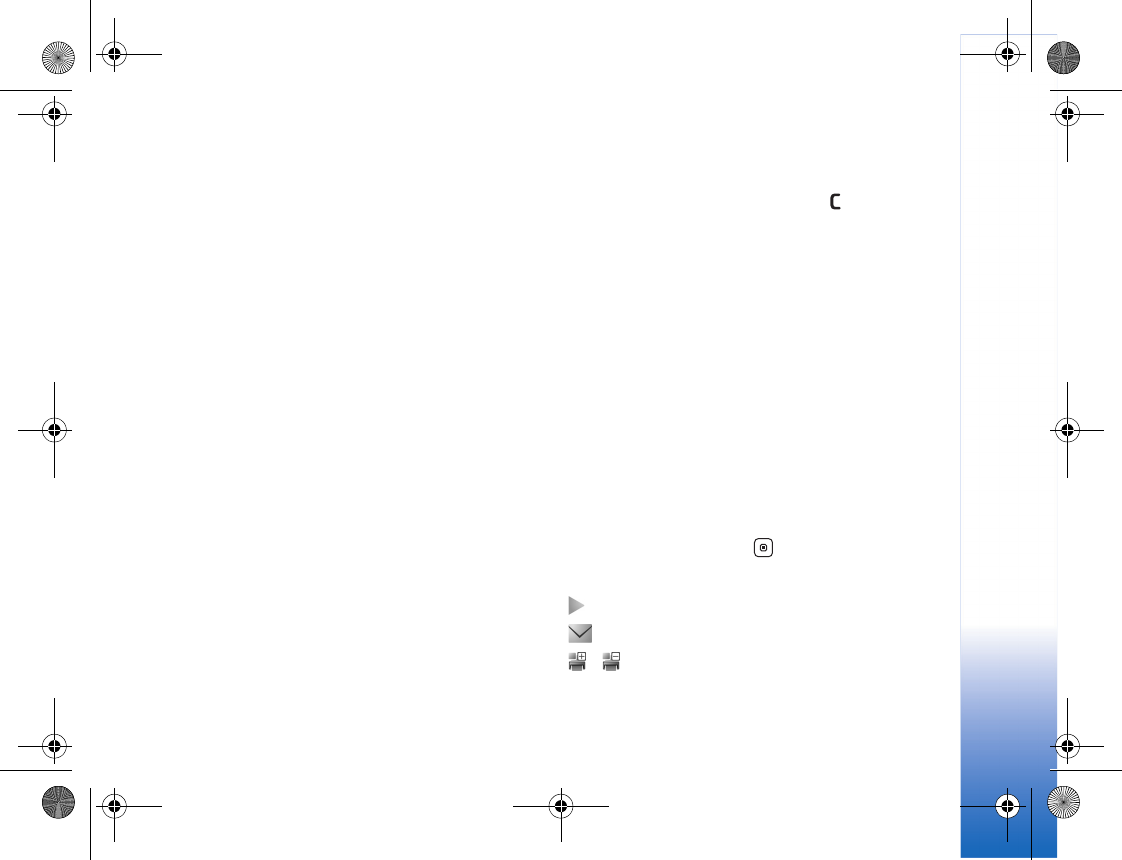
My Stuff
47
scroll left or right. To browse files in groups, scroll up or
down.
To open an image or video clip, select it.
When an image is opened, you can do the following:
• Zoom in or out—Select Options > Zoom in or Zoom
out. The zooming ratio is shown on the lower left part
of the display. The zooming ratio is not stored
permanently.
• Rotate it left or right—Select Options > Rotate.
• Access shortcuts using the active toolbar. See "Active
toolbar," p. 47.
To edit a video clip or a photo, select Options > Edit. An
image editor or a video editor opens. See "Edit video clips,"
p. 50. See "Edit images," p. 50.
To create custom video clips, select a video clip or several
clips in My Stuff and Options > Edit. See "Edit video
clips," p. 50.
To print your images on a compatible printer, or to store
them on your memory card (if inserted) for printing, select
Options > Print. See "Print images," p. 48. You can also tag
images for later printing by adding them to the print
basket in My Stuff. See "Print basket," p. 49.
To add an image or a video clip to an album in My Stuff,
select Options > Albums > Add to album. See "Albums,"
p. 49.
To use an image as a background picture, select the image
and Options >Use image > Set as wallpaper.
To delete an image or video clip, press .
Active toolbar
When you have opened an image or a video clip, you can
use the active toolbar as a shortcut to select different
tasks.
In the active toolbar, scroll up or down to different items,
and select one. The available options vary depending on
the state you are in and on whether you have selected an
image or a video clip. You can also define whether the
active toolbar is always visible on the display or activated
by a keypress:
• If you want the active toolbar to be always visible on
the display, select Options > Show icons.
• If you want the active toolbar to be visible only when
you need it, select Options > Hide icons. To activate
the active toolbar, press .
Select from the following:
to play the selected video clip
to send the selected image or video clip
/ to add or remove an image from the print basket.
See "Print basket," p. 49.
R1114_en.book Page 47 Thursday, October 19, 2006 3:43 PM
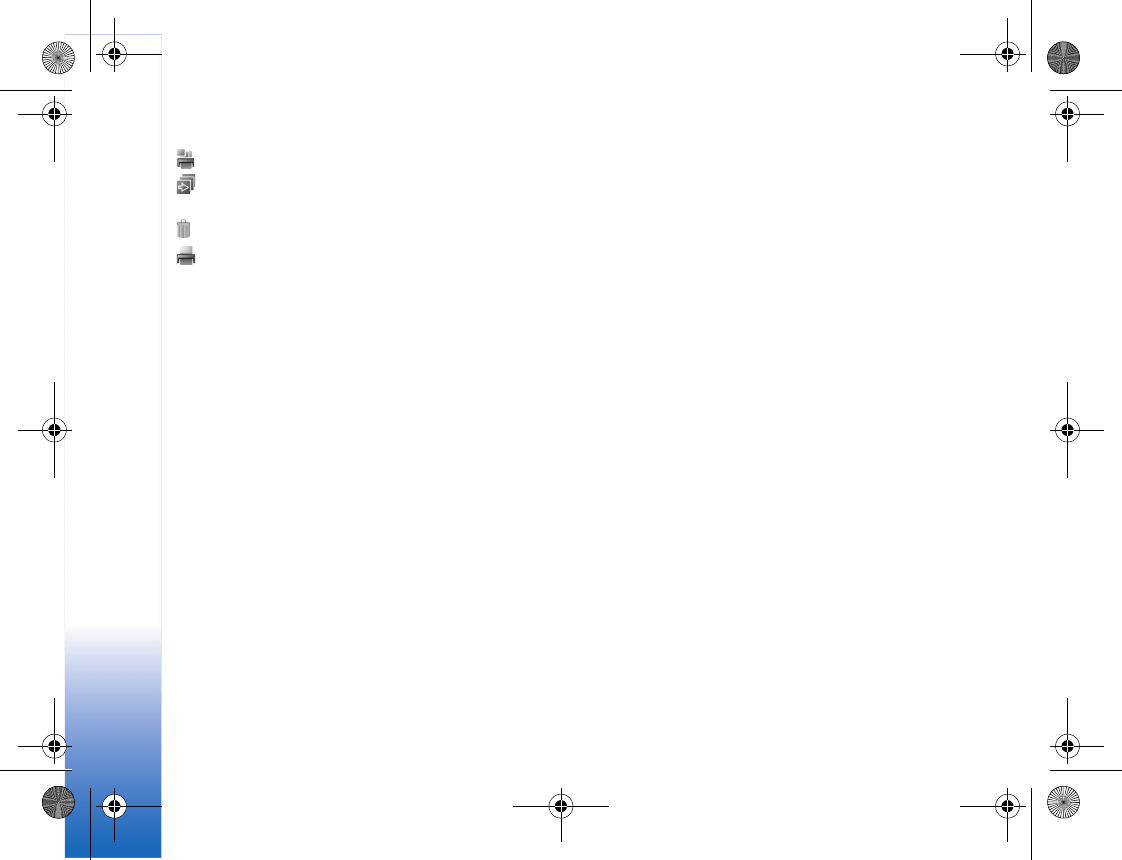
My Stuff
48
to view the images in the print basket
to start a slide show of the images in the selected
album
to delete the selected image or video clip
to print the viewed image
The available options may vary depending on the view you
are in.
Shrink
To free memory for new pictures, reduce the resolution of
images saved in My Stuff. To back up the images first,
copy them to a compatible PC or other location. To reduce
the resolution of images, select Options > Shrink. To
reduce the resolution of an image to 640x480, select
Options > Shrink..
To increase free memory space after you have copied
items to other locations or devices, select Options > Free
memory. You can browse a list of files you have copied. To
remove a copied file from My Stuff, select Options >
Delete.
Print images
To print images with Image print, select the image you
want to print, and the print option in My Stuff, Camera,
image editor, or image viewer.
Select Image print to print your images using the USB data
cable supplied with your device, Bluetooth connectivity, or
a compatible memory card (if available).
You can only print images that are in .jpeg format. The
pictures taken with the camera are automatically saved in
.jpeg format.
To print to a printer compatible with PictBridge, connect
the data cable before you select the print option.
Printer selection
When you select Image print for the first time, a list of
available compatible printers is displayed after you select
the image. Select a printer. The printer is set as the default
printer.
If you have connected a printer compatible with PictBridge
using Nokia Connectivity Cable CA-53, the printer is
automatically displayed.
If the default printer is not available, a list of available
printing devices is displayed.
To change the default printer, select Options > Settings >
Default printer.
R1114_en.book Page 48 Thursday, October 19, 2006 3:43 PM
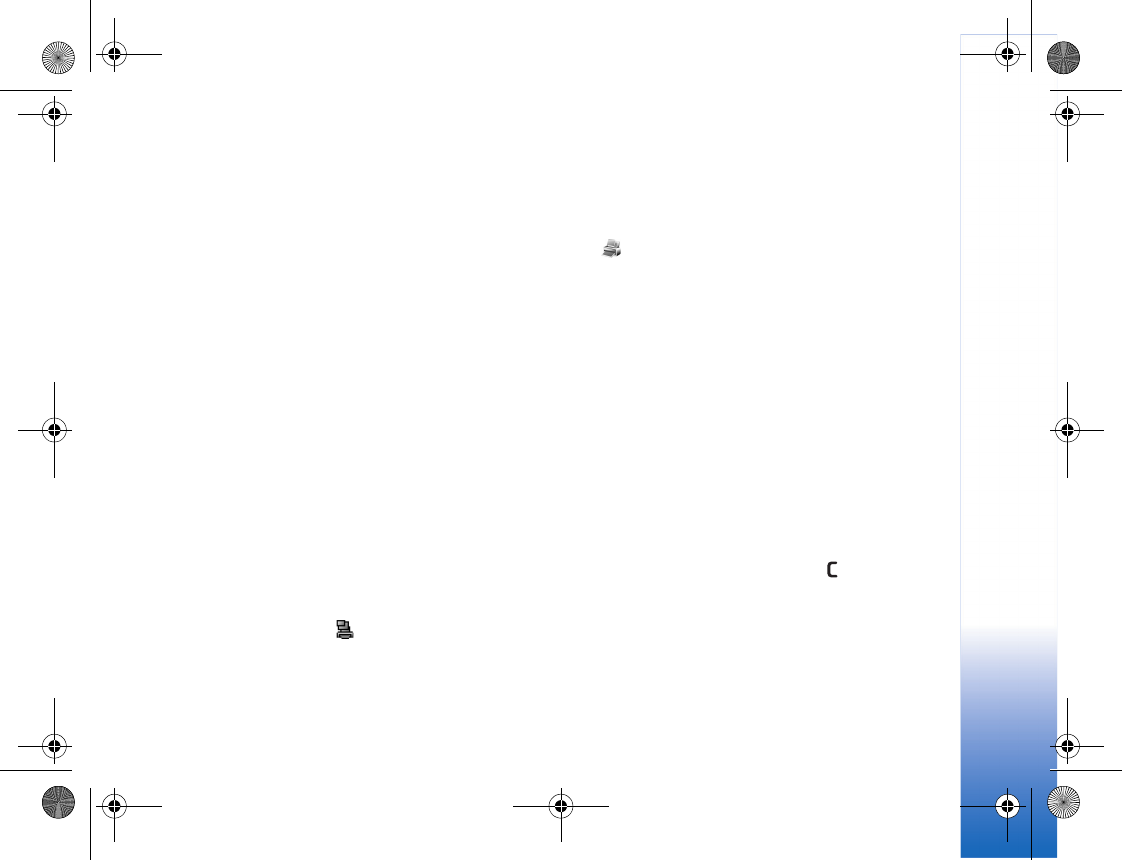
My Stuff
49
Print preview
The print preview view opens only when you start printing
an image in My Stuff.
The selected images are displayed using predefined
layouts. To change the layout, scroll left and right through
the available layouts for the selected printer. If the images
do not fit on a single page, scroll up or down to display the
additional pages.
Print settings
The available options vary, depending on the capabilities of
the printing device you selected.
To set a default printer, select Options > Default printer.
To select the paper size, select Paper size, the size of paper
from the list, and OK. Select Cancel to return to the
previous view.
Print basket
You can tag images to the print basket, and print them
later with a compatible printer or in a compatible printing
kiosk, if available. See "Print images," p. 48. The tagged
images are indicated with in the Images & video
folder and albums.
To tag an image for later printing, select it and Add to
Print Basket from the active toolbar; or scroll to it in the
Images & video folder, and select Options > Print > Add
to print basket.
To view the images in the print basket, select View Print
Basket from the active toolbar, or select the print basket
icon from the Images & video folder (available only
when you have added pictures to the print basket).
To remove an image from the print basket, select an image
in the Images & video folder or in an album and Remove
from print from the active toolbar.
Albums
With albums you can conveniently manage your images
and video clips. To view the albums list, in the Images &
video folder, select Options > Albums > View albums.
To add a picture or a video clip to an album in My Stuff,
scroll to it and select Options > Albums > Add to album.
A list of albums opens. Select the album to which you
want to add the picture or video clip.
To remove a file from an album, press . The file is not
deleted from the Images & video folder in My Stuff.
To create a new album, in the albums list view, select
Options > New album.
R1114_en.book Page 49 Thursday, October 19, 2006 3:43 PM
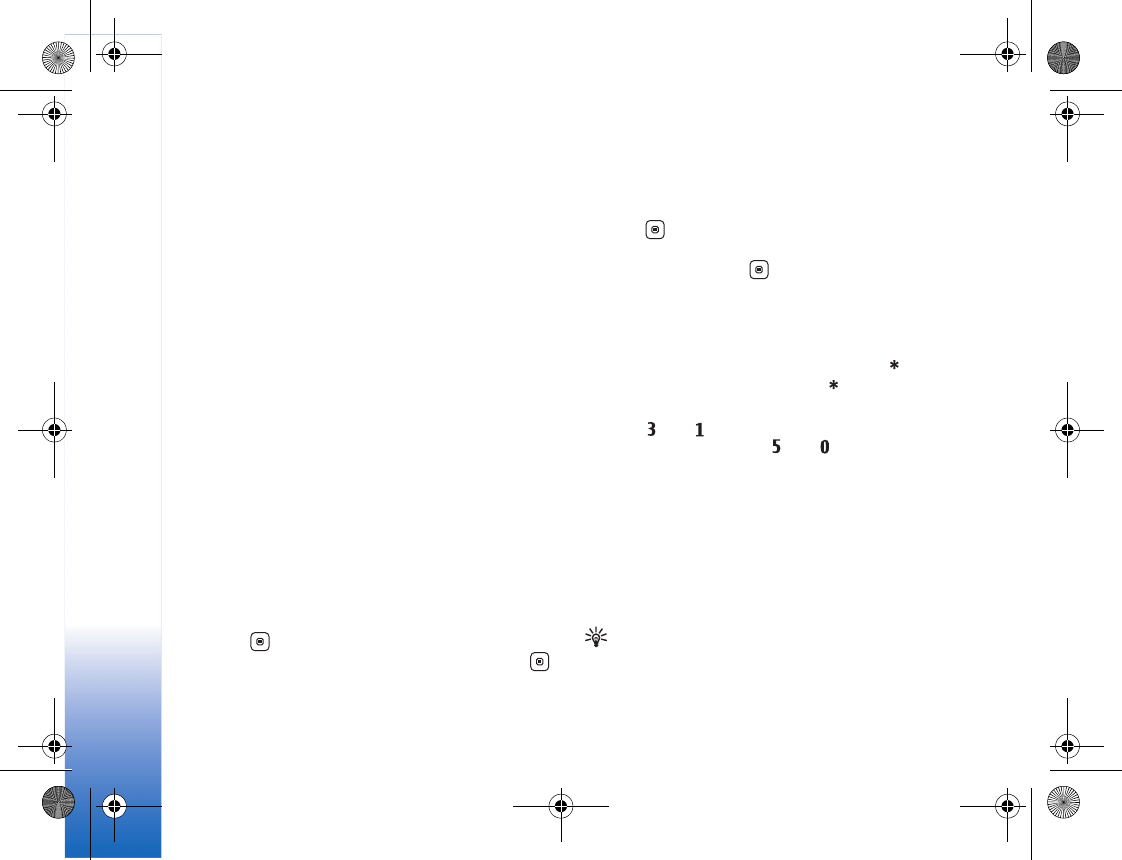
My Stuff
50
Edit images
To edit pictures after taking them, or the ones already
saved in My Stuff, select Options > Edit.
Select Options > Apply effect to open a grid where you
can select different edit options indicated by small icons.
You can crop and rotate the image; adjust the brightness,
color, contrast, and resolution; and add effects, text, clip
art, or a frame to the picture.
Crop image
To crop an image, select Options > Apply effect > Crop.
To crop the image size manually, select Manual or select
a predefined aspect ratio from the list. If you select
Manual, a cross appears in the upper left corner of the
image. Scroll to select the area to crop, and select Set.
Another cross appears in the lower right corner. Again
select the area to be cropped. To adjust the first selected
area, select Back. The selected areas form a rectangle,
which forms the cropped image.
If you selected a predefined aspect ratio, select the upper
left corner of the area to be cropped. To resize the
highlighted area, use the scroll key. To freeze the selected
area, press . To move the area within the picture, use
the scroll key. To select the area to be cropped, press .
Reduce red eye
To reduce red eye in an image, select Options > Apply
effect > Red eye reduction. Move the cross onto the eye,
and press . A loop appears on the display. To resize the
loop to fit the size of the eye, move the scroll key. To
reduce the redness, press .
Shortcuts
Shortcuts in the image editor:
• To view an image in the full screen, press . To
return to the normal view, press again.
• To rotate an image clockwise or counterclockwise,
press or .
• To zoom in or out, press or .
• To move on a zoomed image, scroll up, down, left, or
right.
Edit video clips
To edit video clips in My Stuff and create custom video
clips, scroll to a video clip, and select Options > Edit >
Merge, Change audio, Add text, Cut, or Create muvee.
Tip! You can use Movie director to create custom
video clips. Select the video clips and images with
which you want to create a muvee and Options >
Edit > Create muvee. See "Movie director," p. 52.
R1114_en.book Page 50 Thursday, October 19, 2006 3:43 PM
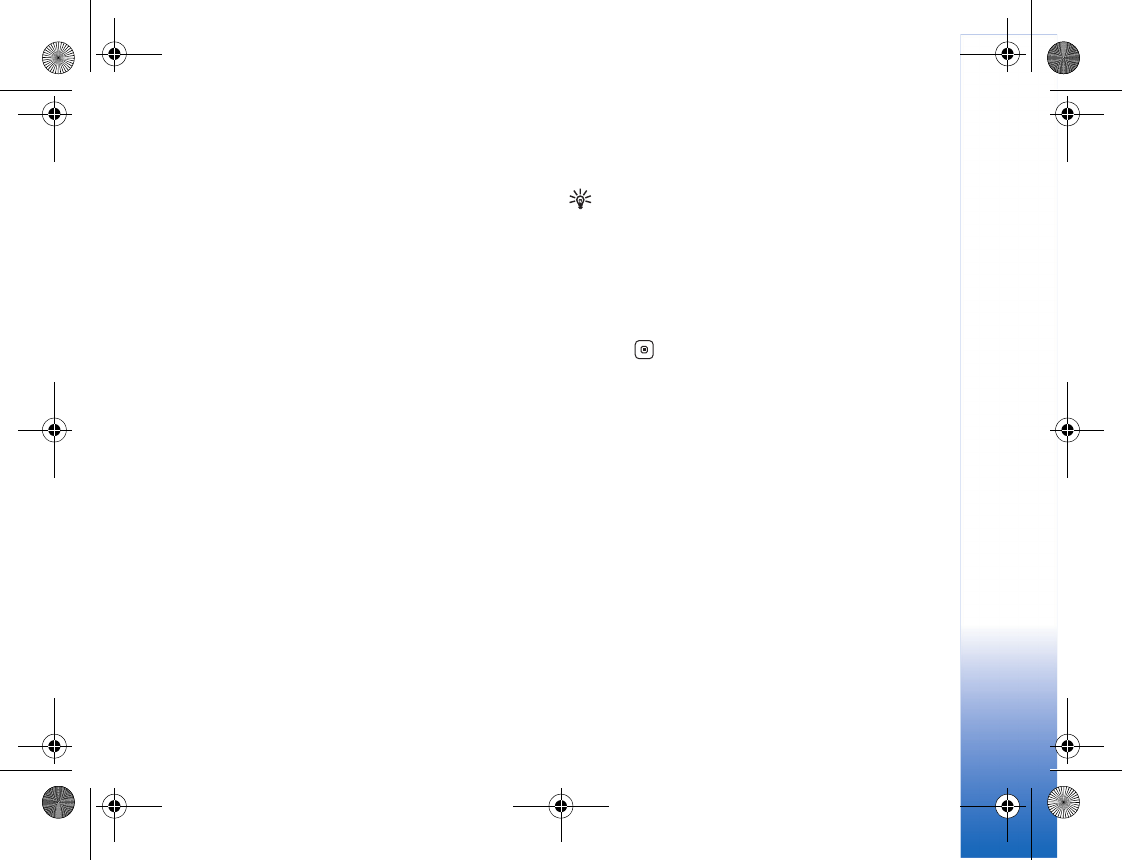
My Stuff
51
The video editor supports video file formats 3gp and .mp4,
and audio file formats .aac, .amr, .mp3 and .wav.
The custom video clips are automatically saved in the
Images & video in My Stuff. The clips are saved on the
memory card. If the memory card is not available, the
device memory is used.
Add images, video, audio, and text
You can add images, video clips, audio and text to a video
clip selected in My Stuff to create custom video clips.
To combine an image or a video clip with the selected
video clip, in the Images & video folder, select Options>
Edit > Merge > Image or Video clip.
To add a new audio clip and replace the original audio clip
in the video clip, select Options> Edit > Change audio and
an audio clip.
To add text to the beginning or the end of the video clip,
select Options > Edit > Add text, enter the text you want
to add, and select OK. To select where you want to add the
text, select Beginning or End.
Cut video clip
You can trim a video clip, and add start and end marks to
exclude parts from the video clip. In the Images & video
folder, select Options > Edit > Cut.
To play the selected video clip from the start, select
Options > Play.
Tip! To take a still picture of a video clip, press the
edit key.
To select which parts of the video clip are included in the
custom video clip, and define the start and end points for
them, scroll to the desired point on the video, and select
Options > Start mark or End mark. To edit the start or
end point of the selected part, scroll to the desired mark,
and press . You can move the selected mark forwards
or backwards on the timeline.
To remove all the marks, select Options > Remove > All
marks.
To preview the video clip, select Options > Play marked
section. To move on the timeline, scroll left or right.
To stop playing the video clip, select Pause. To continue
playing the clip, select Options > Play. To return back to
the cut video view, select Back.
To save the changes, select My Stuff > Done.
Send videos
To send the video, select Options > Send > Via
multimedia, Via Bluetooth, Via infrared, or Web upload.
Contact your network operator or service provider for
details of the maximum multimedia message size that you
R1114_en.book Page 51 Thursday, October 19, 2006 3:43 PM
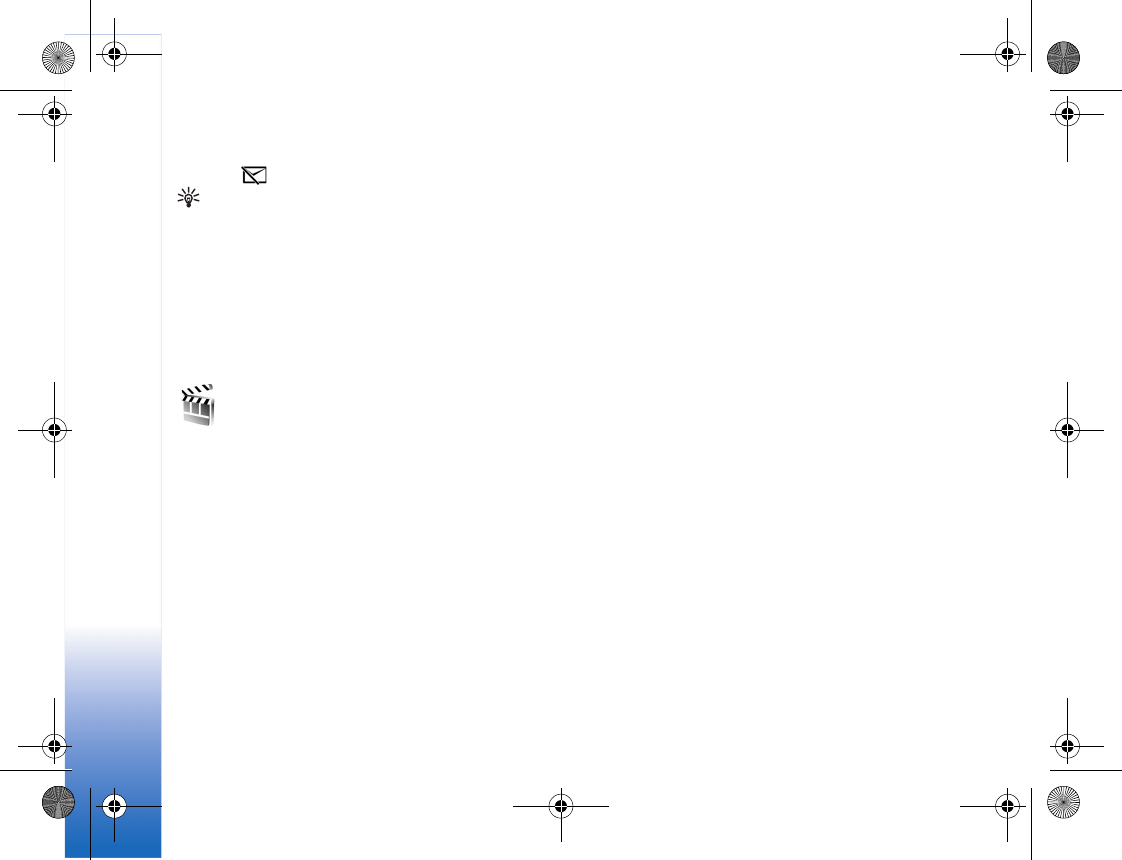
My Stuff
52
can send. If your video is too large to send in a multimedia
message, appears.
Tip! If you want to send a video clip that is over the
maximum multimedia message size allowed by your
service provider, you can send the clip using Bluetooth
wireless technology. See "Send data using Bluetooth
connectivity," p. 114. You can also transfer your videos to
a compatible PC using Bluetooth connectivity, a USB data
cable, or by using a compatible memory card reader
enhancement (sold separately).
Movie director
Launch Movie director from My Stuff. Muvees are styled
video clips that can contain videos, images, music, and
text. The style determines the transitions, visual effects,
graphics, music, and text that are used in the muvee.
Create muvees
1 Open the Imgs. & video folder in My Stuff. Select the
video clips and images you want to create a muvee
with and select Options > Edit > Create muvee.
2Select a style for the muvee from the style list. Movie
director uses the music and text associated with the
chosen style.
3Select Create muvee.
The muvee is created automatically and a Preview view is
displayed. You can select Save to save the muvee in the
Gallery, Recreate to shuffle the media files and create a
new muvee, or press Back to select a different style for
your muvee. You can also select Customize to change the
muvee settings and create a custom muvee to which you
can add images, music, and text.
Create a custom muvee
1Open the Imgs. & video folder in My Stuff. Select the
videos and images you want to create a muvee with
and select Options > Edit > Create muvee.
2Select a style for the muvee from the style list. In the
style view, select Options > Customize. Select from
the following:
Videos & Images—select from the following:
•Add/Remove to add or remove video clips and
images, or Add/Remove > Capture to open the
camera application to capture new video clips and
images.
•Move to reorder the position of video clips and
images in the custom muvee.
•Select contents to select video segments to include/
exclude in the muvee.
Music—to select a music clip from the list.
R1114_en.book Page 52 Thursday, October 19, 2006 3:43 PM
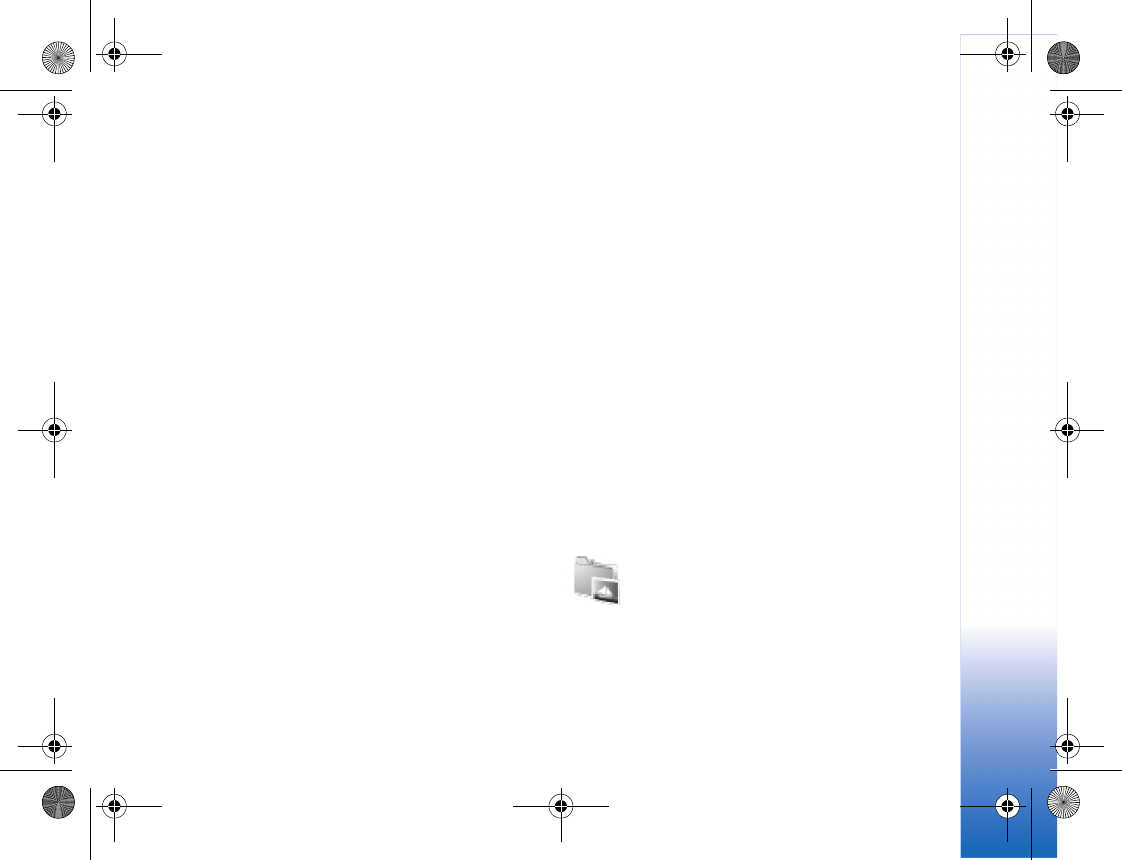
My Stuff
53
Message—to edit the Opening message and Closing
message.
Length—to define the duration of the muvee, select
User defined. Select Multimedia message, Same as
music, or Auto-select. If the muvee duration is less
than the music duration, the muvee is repeated to
match the music duration. If the muvee duration is
longer than the music duration, the music is repeated
to match the muvee duration.
Settings—to change the settings for muvee production.
Select from the following:
•Memory in use—select where to store your muvees.
•Resolution—select the resolution of your muvees.
•Default muvee name—set a default name for the
muvees.
3Select Create muvee.
The muvee is created automatically and a Preview view is
displayed. You can select Save to save the muvee in the
Gallery, Recreate to shuffle the media files and create a
new muvee, or Customize to return to the muvee settings.
Slide show
In the active toolbar, select Start slide show to view a
slide show of images in full screen. The slide show starts
from the selected file. Select from the following:
Pause—to pause the slide show
Continue—to resume the slide show, if paused
End—to close the slide show
To browse the images, scroll left and right (available only
when Zoom and pan is off).
To adjust the tempo of the slide show, before starting the
slide show, select Options > Slide show > Settings >
Delay between slides.
To make the slide show move smoothly from one slide to
another, and let My Stuff randomly zoom into and out of
the images, select Zoom and pan.
To add audio to the slide show, select Options > Slide
show > Settings and from the following:
Music—Select On or Off.
Track—Select a music file from the list.
To decrease or increase the volume, use the volume keys
on the side of your device.
Presentations
With presentations, you can view svg (scalable
vector graphics) files, such as cartoons and
maps. These files maintain their appearance when printed
or viewed with different screen sizes and resolutions. To
view svg files, select the Presentations folder, scroll to an
image, and select Options > Play.
R1114_en.book Page 53 Thursday, October 19, 2006 3:43 PM
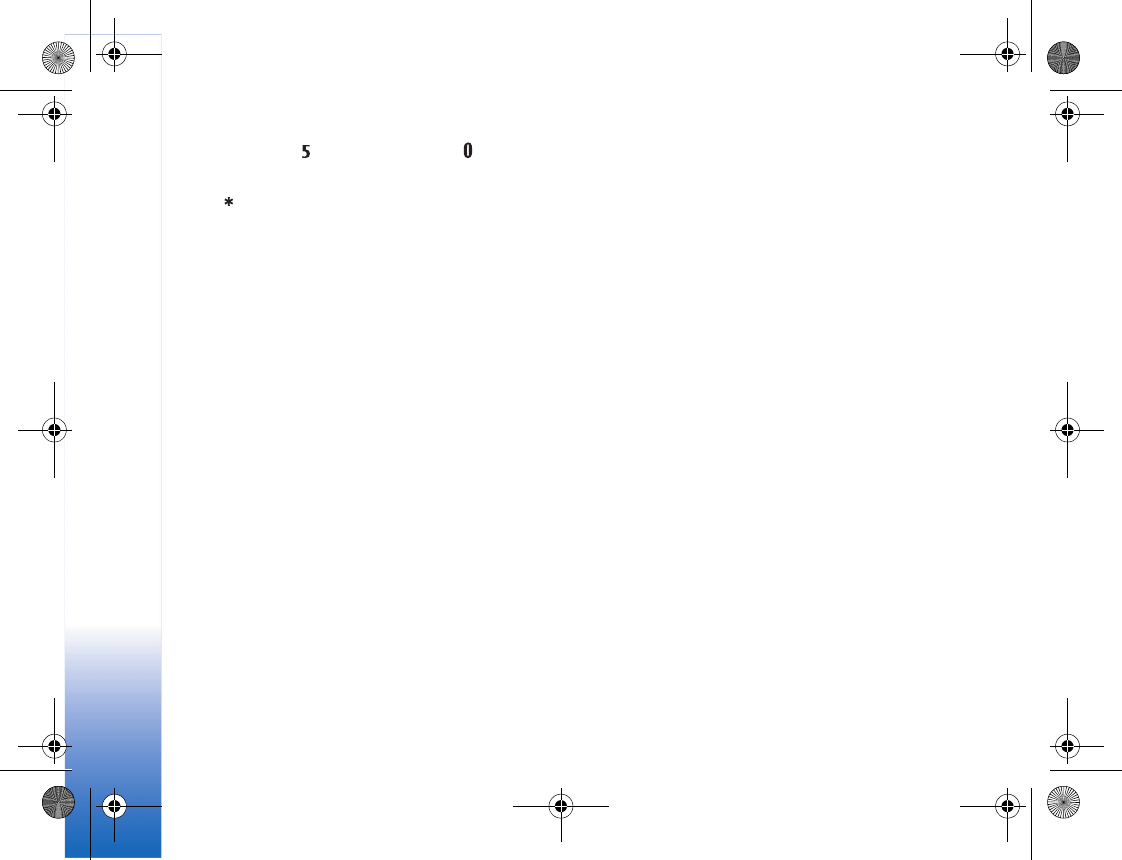
My Stuff
54
To zoom in, press . To zoom out, press .
To switch between full screen and normal screen,
press .
R1114_en.book Page 54 Thursday, October 19, 2006 3:43 PM
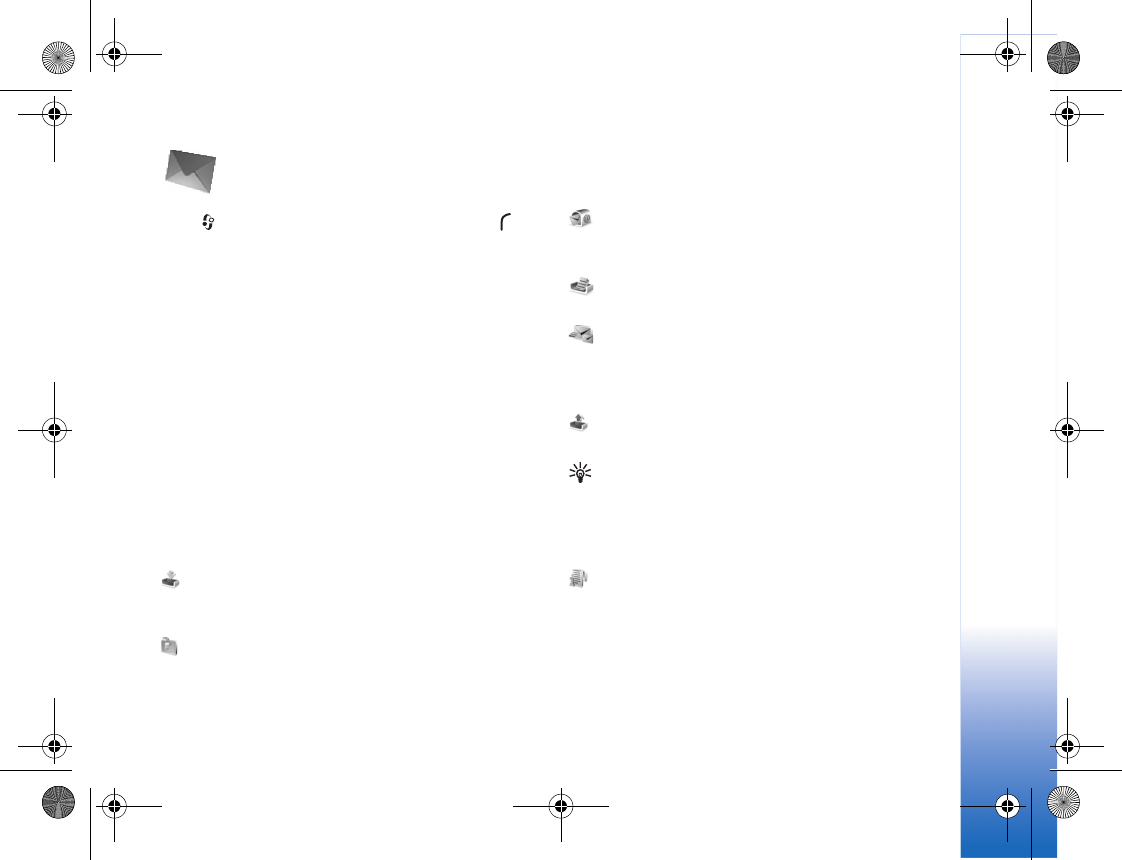
Messaging
55
Messaging
Press , and select Messag.. Alternatively, press . In
Messag., you can create, send, receive, view, edit, and
organize text messages, multimedia messages, e-mail
messages, and special text messages containing data. You
can also send postcards, receive Web service messages and
cell broadcast messages, and send service commands.
Messages and data received using Bluetooth connectivity
or infrared are received in the Inbox folder in Messag..
To create a new message, select New message.
Only devices that have compatible features can receive
and display multimedia messages. The appearance of a
message may vary depending on the receiving device.
Copyright protections may prevent some images, music
(including ringing tones), and other content from being
copied, modified, transferred or forwarded.
Messag. contains the following folders:
Inbox—Received messages, except e-mail and cell
broadcast messages, are stored here. E-mail messages are
stored in the Mailbox.
My folders—Organize your messages into folders. My
folders is the Templates folder, which contains sample
texts for common messages
Mailbox—Connect to your remote mailbox to
retrieve your new e-mail messages or view your previously
retrieved e-mail messages offline. See "E-mail," p. 66.
Drafts—Draft messages that have not been sent are
stored here.
Sent—The last 20 messages that have been sent,
excluding messages sent using Bluetooth connectivity or
infrared, are stored here. To change the number of
messages to be saved, see "Other settings," p. 68.
Outbox—Messages waiting to be sent are temporarily
stored here.
Example: Messages are placed in Outbox, for
example, when your device is outside network
coverage. You can also schedule e-mail messages to be
sent the next time you connect to your remote
mailbox.
Reports—You can request the network to send you a
delivery report of the text messages and multimedia
messages you have sent (network service). Receiving a
delivery report of a multimedia message that has been
sent to an e-mail address may not be possible.
R1114_en.book Page 55 Thursday, October 19, 2006 3:43 PM
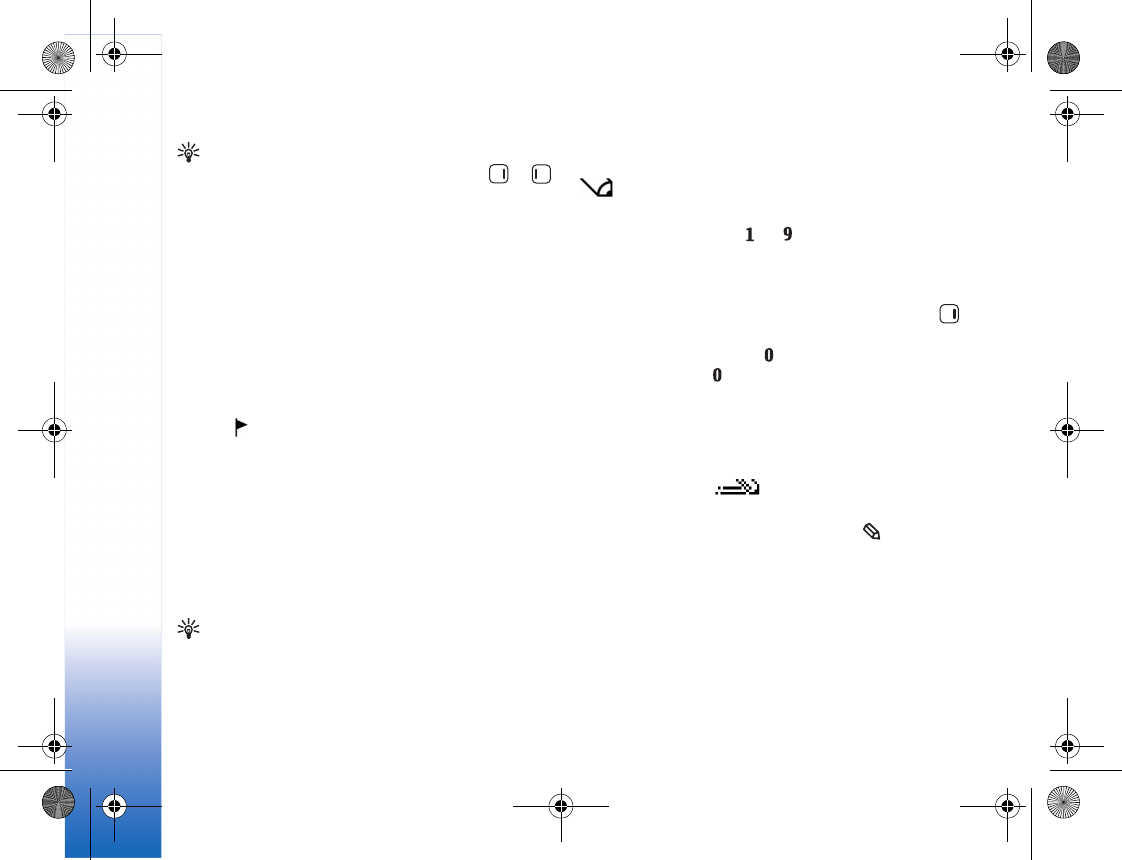
Messaging
56
Tip! When you have opened any of the default
folders, to switch between the folders, press or .
To enter and send service requests (also known as USSD
commands), such as activation commands for network
services, to your service provider, select Options >
Service command in the main view of Messag..
Cell broadcast (network service) allows you to receive
messages on various topics, such as weather or traffic
conditions, from your service provider. For available topics
and relevant topic numbers, contact your service provider.
In the main view of Messaging, select Options > Cell
broadcast. In the main view, you can see the status of a
topic, a topic number, name, and whether it has been
flagged ( ) for follow-up.
Cell broadcast messages cannot be received in UMTS
networks. A packet data connection may prevent cell
broadcast reception.
Write text
ABC, abc, and Abc indicate the selected character mode.
123 indicates the number mode.
Tip! To avoid rewriting messages that you send often,
use texts in the Templates folder.
Traditional text input
is displayed when you write text using traditional
text input.
• Press a number key ( — ) repeatedly until the
desired character appears. There are more characters
available for a number key than are printed on the key.
• If the next letter is located on the same key as the
present one, wait until the cursor appears (or press
to end the time-out period), and enter the letter.
• To insert a space, press . To move the cursor to the
next line, press three times.
Predictive text input
You can enter any letter with a single keypress. Predictive
text input is based on a built-in dictionary to which you
can add new words. is displayed when you write
text using predictive text input.
1To activate predictive text input, press , and select
Predictive text on. This activates predictive text input
for all editors in the device.
R1114_en.book Page 56 Thursday, October 19, 2006 3:43 PM
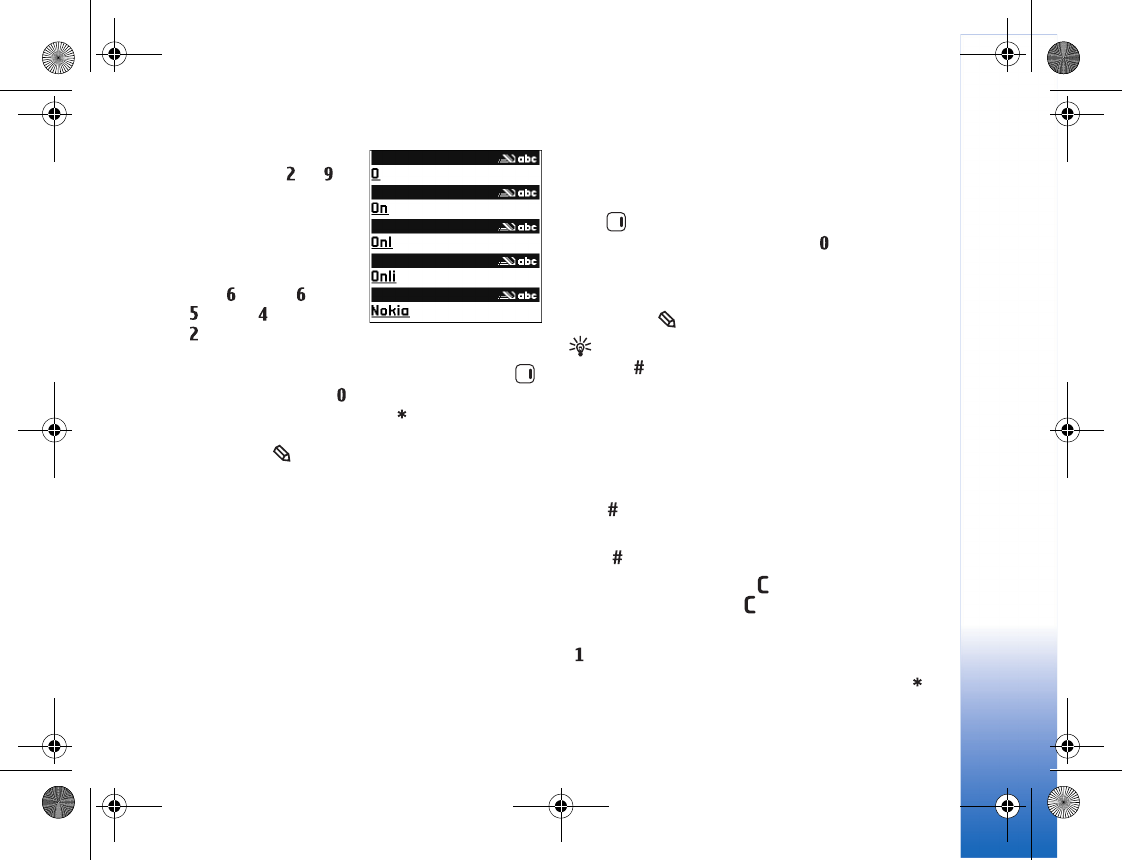
Messaging
57
2To write the desired word,
press the keys — .
Press each key only once
for one letter. For
example, to write "Nokia"
when the English
dictionary is selected,
press for N, for o,
for k, for i, and
for a.
The word suggestion changes after each keypress.
3When you finish writing the word correctly, press
to confirm it, or press to add a space.
If the word is not correct, press repeatedly to view
the matching words the dictionary has found one by
one, or press , and select Predictive text >
Matches.
If the ? character is shown after the word, the word is
not in the dictionary. To add a word to the dictionary,
select Spell, enter the word using traditional text input,
and select OK. The word is added to the dictionary.
When the dictionary is full, a new word replaces the
oldest added word.
4Start writing the next word.
Write compound words
A compound word is one that does not appear in the
dictionary, but is made up of smaller words. If a question
mark appears when you are typing a compound word, the
word is not in the dictionary.
Write the first half of a compound word; to confirm it,
press . Write the last part of the compound word. To
complete the compound word, press to add a space.
Turn predictive text input off
To turn predictive text input off for all editors in the
device, press , and select Predictive text > Off.
Tip! To turn predictive text input on or off, quickly
press twice.
Tips on text input
To insert a number in the letter mode, press and hold the
desired number key.
To switch between the letter and number mode, press and
hold .
To switch between the different character modes,
press .
To delete a character, press . To delete more than one
character, press and hold .
The most common punctuation marks are available under
.
To open a list of special characters, press and hold .
R1114_en.book Page 57 Thursday, October 19, 2006 3:43 PM
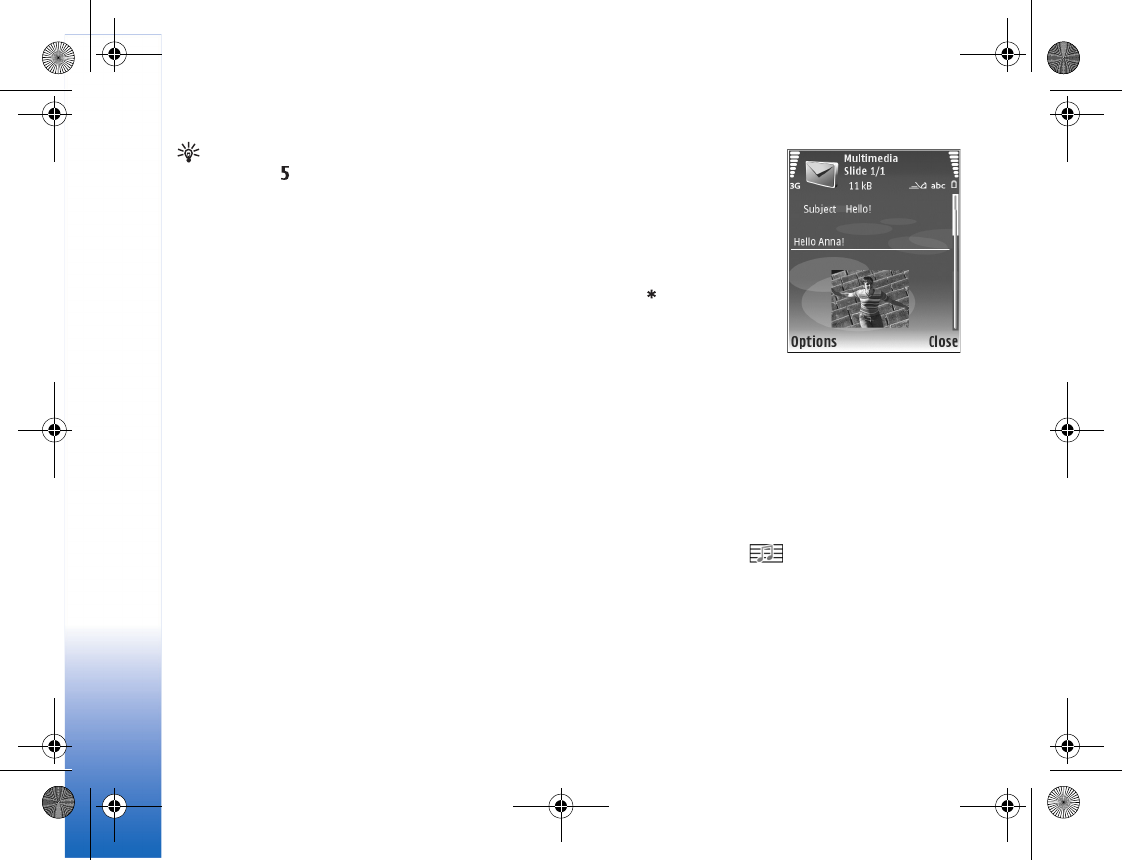
Messaging
58
Tip! To insert several special characters at the same
time, press when you select each character.
Write and send messages
Before you can create a multimedia message or write an
e-mail, you must have the correct connection settings in
place. See "Receive MMS and e-mail settings," p. 60 and
"E-mail," p. 66.
The wireless network may limit the size of MMS messages.
If the inserted picture exceeds this limit, the device may
make it smaller so that it can be sent by MMS.
1Select New message and from the following:
Text msg.—to send a text message
Multimedia message—to send a multimedia message
E-mail—to send an e-mail. If you have not set up your
e-mail account, you are prompted to do so. To start
creating the e-mail settings with the mailbox guide,
select Start.
2In the To field, select
recipients or groups from
Addr. Book, or enter the
recipient’s phone number
or e-mail address. To add
a semicolon (;) that
separates the recipients,
press . You can also
copy and paste the
number or address from
the clipboard.
3In the Subject field, enter
the subject of a multimedia message or e-mail. To
change the fields that are visible, select Options >
Address fields.
4In the message field, write the message. To insert a
template, select Options > Insert or Insert object >
Template.
5To add a media object to a multimedia message, select
Options > Insert object > Image, Audio, or Video clip.
When audio is added, is shown.
You cannot send video clips that are saved in the .mp4
format in a multimedia message. To change the format
in which recorded videos are saved, see "Video
settings," p. 35.
6To take a new picture or record audio or video for a
multimedia message, select Insert new > Image,
R1114_en.book Page 58 Thursday, October 19, 2006 3:43 PM
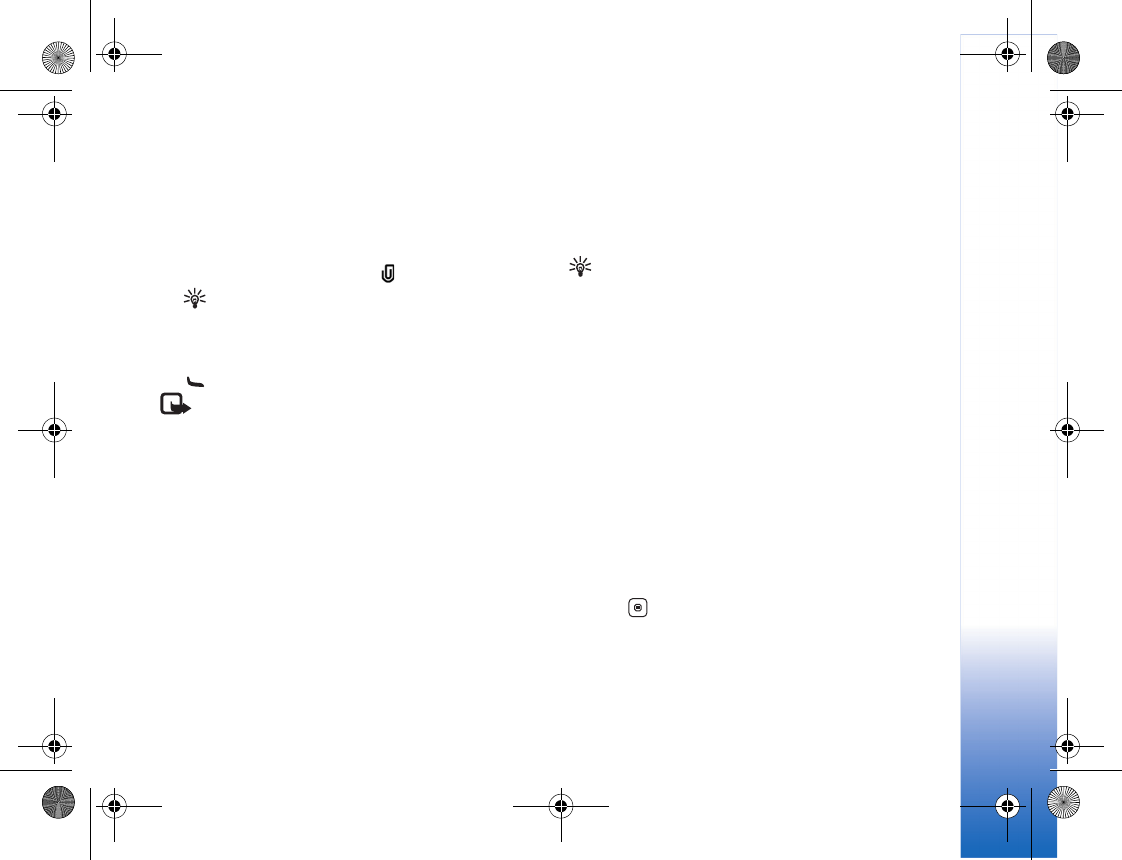
Messaging
59
Audio, or Video clip. To insert a new slide to the
message, select Slide.
To see what the multimedia message looks like, select
Options > Preview.
7To add an attachment to an e-mail, select Options >
Insert > Image, Audio, Video clip, or Note. E-mail
attachments are indicated by .
Tip! To send other file types as attachments, open
the appropriate application, and select Send > Via
e-mail, if available.
8To send the message, select Options > Send, or press
.
Note: Your device may indicate that your message
was sent to the message center number programmed
into your device. Your device may not indicate whether
the message is received at the intended destination. For
more details about messaging services, contact your
service provider.
Your device supports the sending of text messages beyond
the character limit for a single message. Longer messages
are sent as a series of two or more messages. Your service
provider may charge accordingly. Characters that use
accents or other marks, and characters from some
language options like Chinese, take up more space limiting
the number of characters that can be sent in a single
message. You can see the message length indicator
counting backwards: for example, 10 (2) means that you
can still add 10 characters for the text to be sent as two
messages.
E-mail messages are automatically placed in Outbox
before sending. If sending does not succeed, the e-mail is
left in the Outbox with the Failed status.
Tip! You can combine images, video, audio, and text
to a presentation and send it in a multimedia message.
Start to create a multimedia message, and select
Options > Create presentation. The option is shown
only if MMS creation mode is set to Guided or Free.
See "Multimedia messages," p. 61.
Write and send postcards
With the postcard service (network service), you can send
a multimedia message with a postal address to a postcard
service provider. The service provider prints out the
message as a postcard and sends it to the recipient’s
address. The network operator charges for the postcard
service.
1Select New message > Postcard
2In the address field on the back of the postcard,
press . Select the recipient from Addr. Book. To
enter the name and postal address of the recipient,
scroll to the fields and enter the details.
R1114_en.book Page 59 Thursday, October 19, 2006 3:43 PM
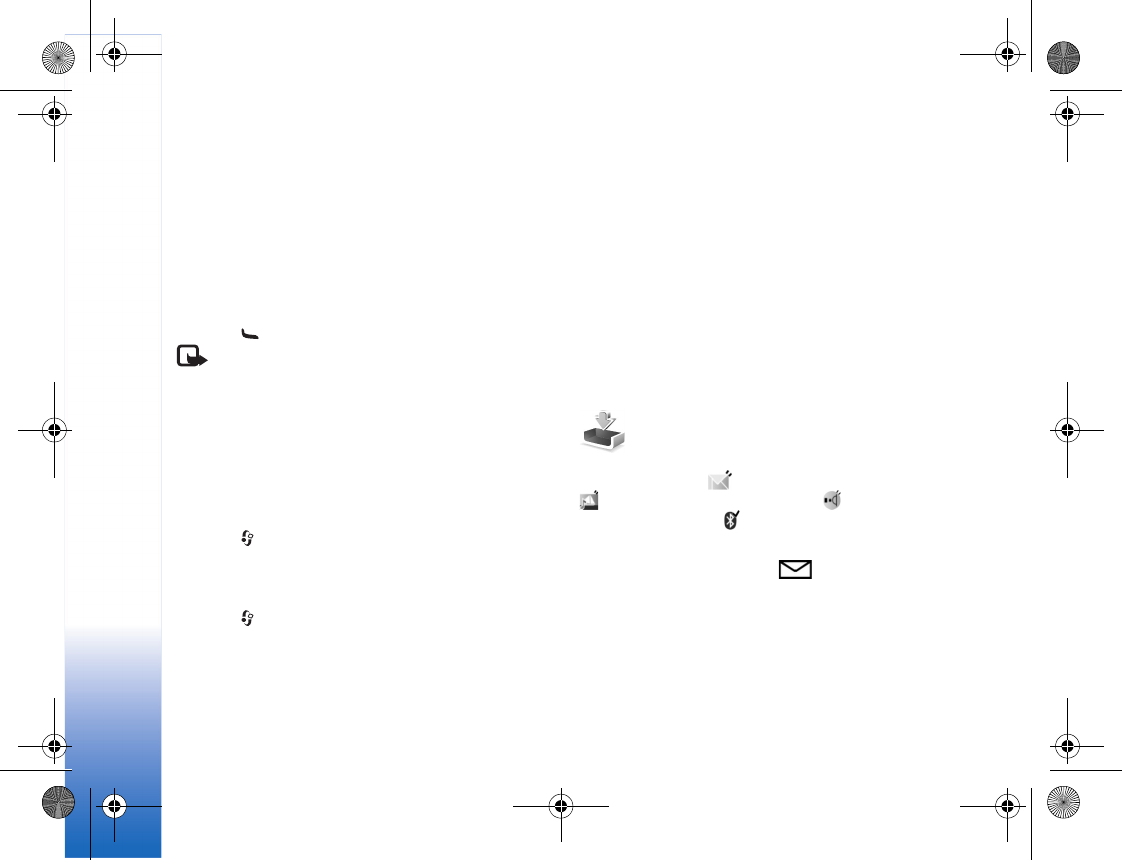
Messaging
60
3In the greeting text field, write the greeting. To insert
a template or note as your greeting, select Options >
Insert > Template or Note.
4You can take a new image for the postcard, or insert
an existing image from My Stuff. To insert the image,
select Options > Insert image > New or Existing.
To change between the front and back sides of the
postcard, scroll up or down.
5To send the postcard to the postcard service, Send, or
press .
Note: You can only send postcards that include both
an image and a recipient postal address.
Receive MMS and e-mail settings
You may receive the settings in a message from your
network operator or service provider. See "Data and
settings," p. 61.
Enter the MMS settings manually
1Press , select Settings > Config. > Connection >
Access points, and define the settings for a
multimedia messaging access point. See "Connection,"
p. 102.
2Press , and select Messaging > Options >
Settings > Multim. msg. > Access point in use and
the access point you created as the preferred
connection. See also "Multimedia messages," p. 61.
Before you can send, receive, retrieve, reply to, and forward
e-mail, you must configure an Internet access point (IAP)
correctly. See "Connection," p. 102.
Define your e-mail settings correctly. If you select Mailbox
in the Messag. main view and have not set up your e-mail
account, you are prompted to do so. To start creating the
e-mail settings with the mailbox guide, select Start. See
also "E-mail," p. 66.
You must have a separate e-mail account. Follow the
instructions given by your remote mailbox and Internet
service provider (ISP).
Inbox—receive messages
In the Inbox folder, indicates an unread text message,
an unread multimedia message, data received
through infrared, and data received through Bluetooth
connectivity.
When you receive a message, and 1 new message
are shown in the idle mode. To open the message, select
Show. To open a message in Inbox, select it.
To reply to a received message, select Options > Reply
R1114_en.book Page 60 Thursday, October 19, 2006 3:43 PM
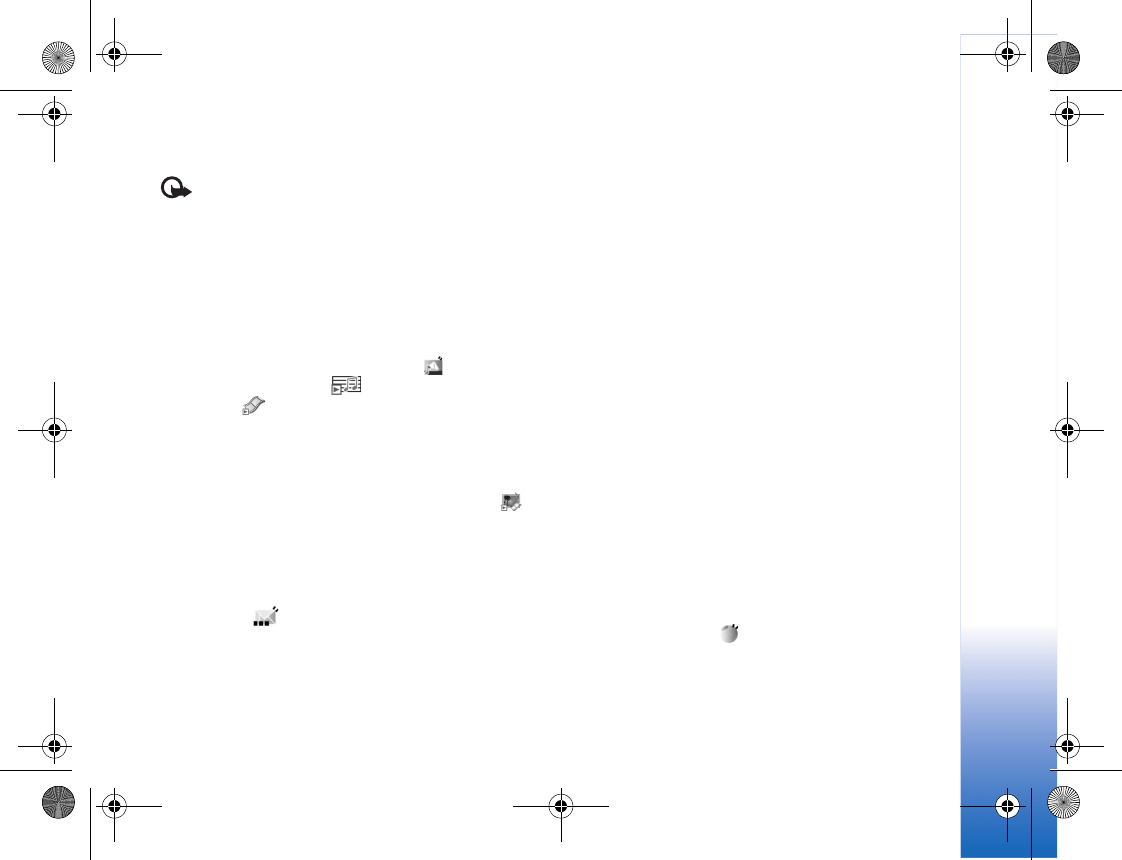
Messaging
61
Multimedia messages
Important: Exercise caution when opening
messages. Multimedia message objects may contain
malicious software or otherwise be harmful to your device
or PC.
You may receive a notification that a multimedia message
is waiting in the multimedia message center. To start a
packet data connection to retrieve the message to your
device, select Options > Retrieve.
When you open a multimedia message ( ), you may see
an image and a message. is shown if audio is
included, or if video is included. To play the audio or
the video, select the indicator.
To see the media objects that have been included in the
multimedia message, select Options > Objects.
If the message includes a multimedia presentation, is
displayed. To play the presentation, select the indicator.
Data and settings
Your device can receive many kinds of messages that
contain data ( ):
Configuration message—You may receive settings from
your network operator, service provider, or company
information management department in a configuration
message. To save the settings, select Options > Save all.
Business card—To save the information to the Addr.
Book, select Options > Save business card. Certificates or
audio files attached to the business card are not saved.
Ringing tone—To save the ringing tone, select Options >
Save.
Operat. logo—To have the logo shown in the idle mode
instead of the network operator’s own identification,
select Options > Save.
Calen. entry—To save the invitation, select Options >
Save to Calendar.
Web message—To save the bookmark to the bookmarks
list in Web, select Options > Add to bookmarks. If the
message contains both access point settings and
bookmarks, to save the data, select Options > Save all.
E-mail notif.—The note tells you how many new e-mails
you have in your remote mailbox. An extended
notification may list more detailed information.
Web service messages
Web service messages ( ) are notifications (for example,
news headlines) and may contain a text message or a link.
For availability and subscription, contact your service
provider.
R1114_en.book Page 61 Thursday, October 19, 2006 3:43 PM
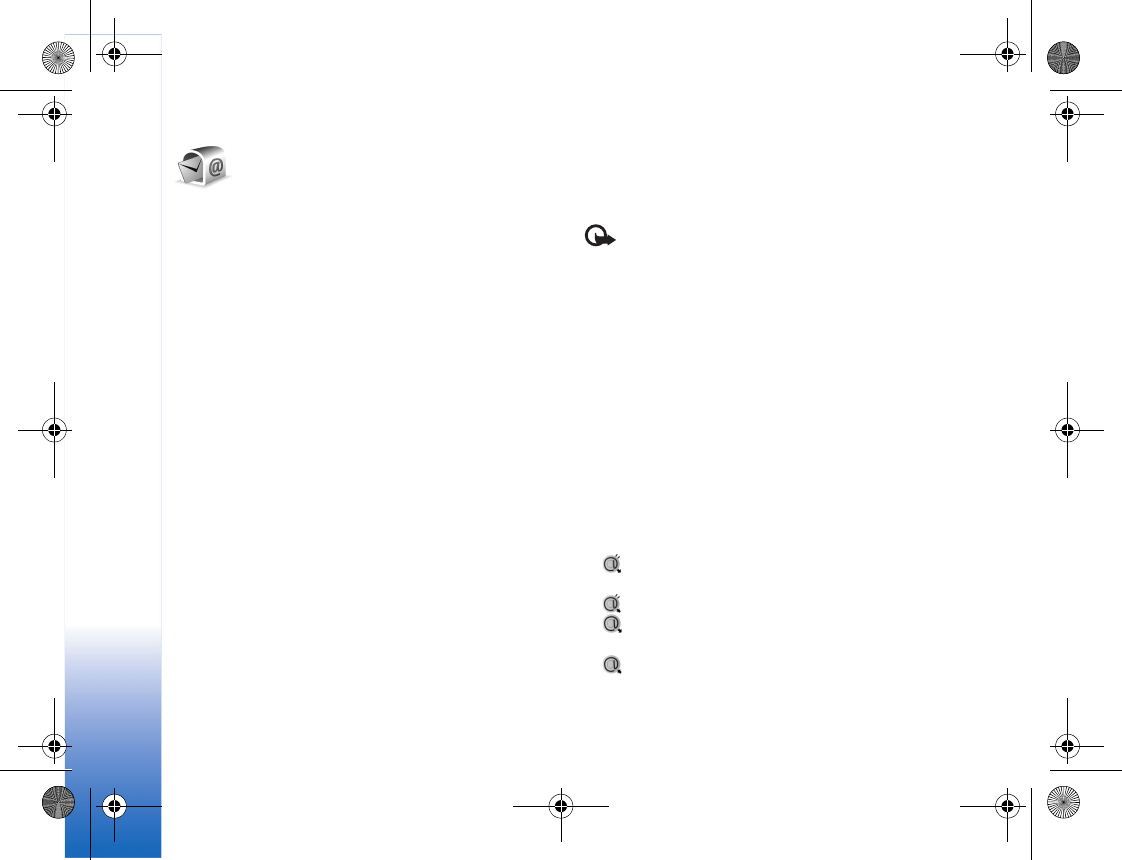
Messaging
62
Mailbox
If you select Mailbox and have not set up your e-mail
account, you are prompted to do so. To start creating the
e-mail settings with the mailbox guide, select Start. See
also "E-mail," p. 66.
When you create a new mailbox, the name you give to the
mailbox replaces Mailbox in the Messaging main view.
You can have up to six mailboxes.
Open the mailbox
When you open the mailbox, the device asks if you want
to connect to the mailbox (Connect to mailbox?).
To connect to your mailbox and retrieve new e-mail
headings or messages, select Yes. When you view
messages online, you are continuously connected to a
remote mailbox using a data connection. See also
"Connection," p. 102.
To view previously retrieved e-mail messages offline,
select No. When you view e-mail messages offline, your
device is not connected to the remote mailbox.
Retrieve e-mail messages
If you are offline, select Options > Connect to start a
connection to the remote mailbox.
Important: Exercise caution when opening
messages. E-mail messages may contain malicious
software or otherwise be harmful to your device or PC.
1When you have an open connection to a remote
mailbox, select Options > Retrieve e-mail and one of
the following:
New—to retrieve all new e-mail messages
Selected—to retrieve only the e-mail messages that
have been marked
All—to retrieve all messages from the mailbox
Cancel—to stop retrieving messages
2After you retrieve the e-mail messages, you can
continue viewing them online, or select Options >
Disconnect to close the connection and view the
e-mail messages offline.
E-mail status indicators:
The new e-mail (offline or online mode) has not
been retrieved to your device.
The new e-mail has been retrieved to your device.
The e-mail message has been read, and it has not
been retrieved to your device.
The e-mail message has been read.
R1114_en.book Page 62 Thursday, October 19, 2006 3:43 PM
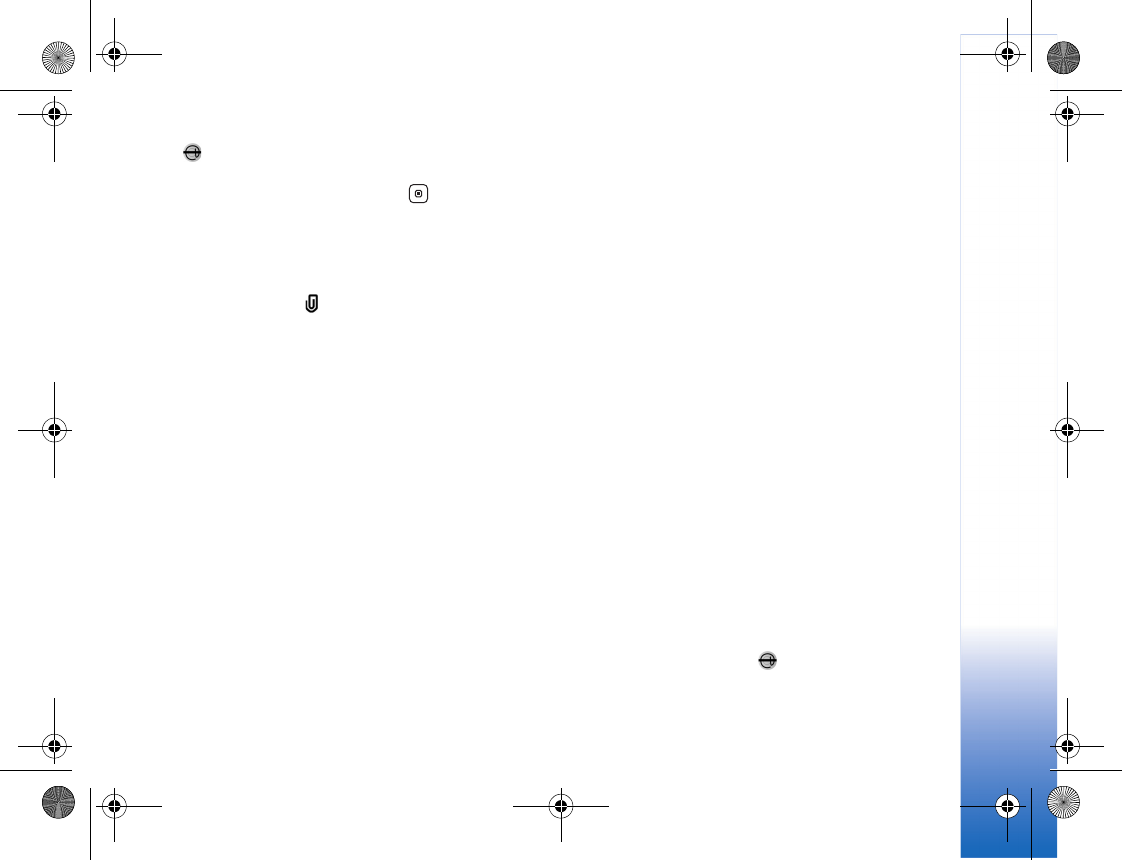
Messaging
63
The e-mail heading has been read and the message
content has been deleted from the device.
3To open an e-mail message, press . If the e-mail
message has not been retrieved and you are offline, you
are asked if you want to retrieve this message from the
mailbox.
To view e-mail attachments, open a message that has the
attachment indicator , and select Options >
Attachments. If the attachment has a dimmed indicator,
it has not been retrieved to the device; select Options >
Retrieve.
To print an e-mail message on a compatible Basic Print
Profile (BPP) equipped printer with Bluetooth connectivity
(such as HP Deskjet 450 Mobile Printer or HP Photosmart
8150), select Options > Print.
Retrieve e-mail messages automatically
To retrieve messages automatically, select Options >
E-mail settings > Automatic retrieval > Header
retrieval > Always enabled or Only in home net., and
define when and how often the messages are retrieved.
Retrieving e-mail messages automatically may increase
your call costs due to the data traffic.
Delete e-mail messages
To delete the contents of an e-mail message from the
device while still retaining it in the remote mailbox, select
Options > Delete. In Delete msg. from:, select Phone
only.
The device mirrors the e-mail headings in the remote
mailbox. Although you delete the message content, the
e-mail heading stays in your device. If you want to remove
the heading as well, you must delete the e-mail message
from your remote mailbox, and make a connection from
your device to the remote mailbox again to update the
status.
To delete an e-mail from the device and the remote
mailbox, select Options > Delete > Delete msg. from: >
Phone and server.
If you are offline, the e-mail is deleted first from your
device. During the next connection to the remote mailbox,
it is automatically deleted from the remote mailbox. If you
are using the POP3 protocol, messages marked to be
deleted are removed only after you have closed the
connection to the remote mailbox.
To cancel deleting an e-mail from the device and server,
scroll to an e-mail that has been marked to be deleted
during the next connection ( ), and select Options >
Restore.
R1114_en.book Page 63 Thursday, October 19, 2006 3:43 PM
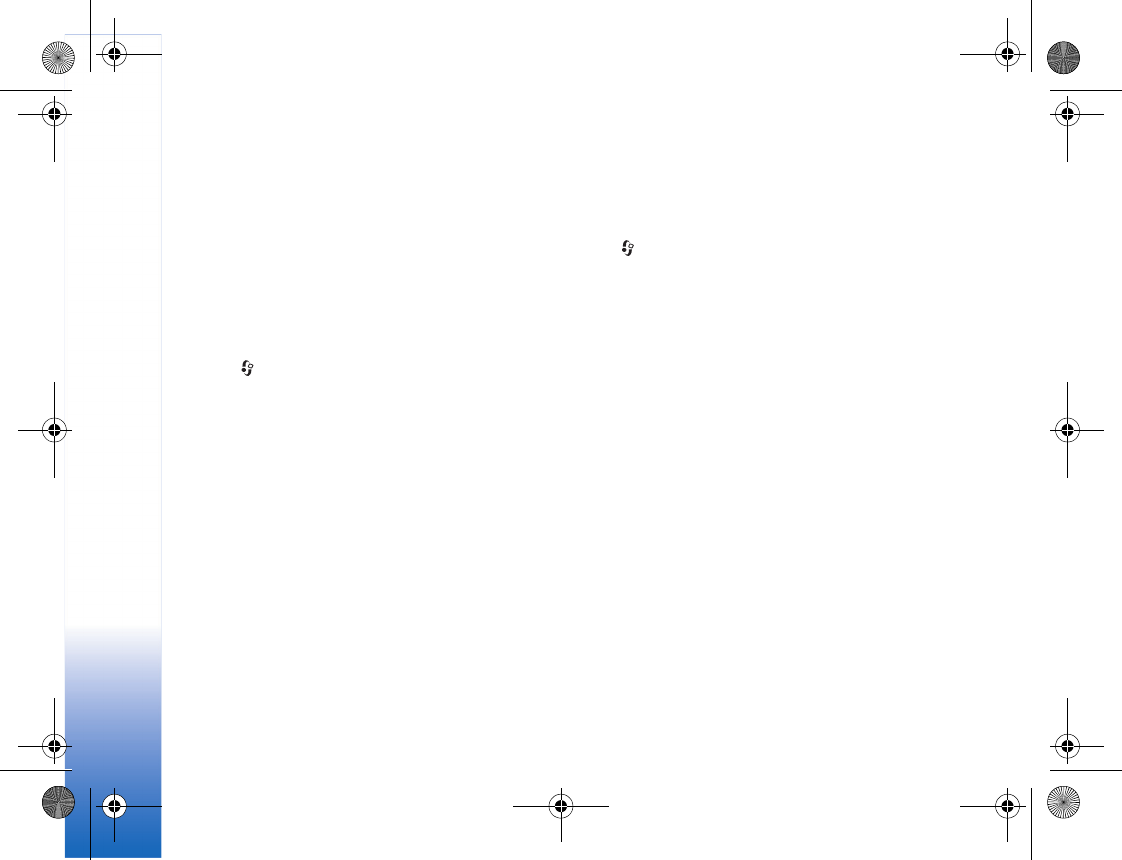
Messaging
64
Disconnect from the mailbox
When you are online, to end the data connection to the
remote mailbox, select Options > Disconnect.
View messages on a SmartChip
card
Before you can view SmartChip messages, you must copy
them to a folder in your device.
1Press , and select Messag. > Options >
SmartChip messages.
2Select Options > Mark/Unmark > Mark or Mark all
to mark messages.
3Select Options > Copy. A list of folders opens.
4To start copying, select a folder and OK. To view the
messages, open the folder.
Messaging settings
Fill in all fields marked with Must be defined or with a red
asterisk. Follow the instructions given by your service
provider. You may also obtain settings from your service
provider in a configuration message.
Some or all message centers or access points may be
preset for your device by your service provider or network
operator, and you may not be able to change, create, edit,
or remove them.
Text messages
Press , and select Messag. > Options > Settings >
Text msg. and from the following:
Message centers—View a list of all text message centers
that have been defined.
Character encoding— To use character conversion to
another encoding system when available, select Reduced
support.
Msg. center in use—Select which message center is used
to deliver text messages.
Receive report—Select whether the network sends
delivery reports on your messages (network service).
Message validity—Select how long the message center
resends your message if the first attempt fails (network
service). If the recipient cannot be reached within the
validity period, the message is deleted from the message
center.
Message sent as—Change this option only if you are sure
that your message center is able to convert text messages
into these other formats. Contact your network operator.
R1114_en.book Page 64 Thursday, October 19, 2006 3:43 PM
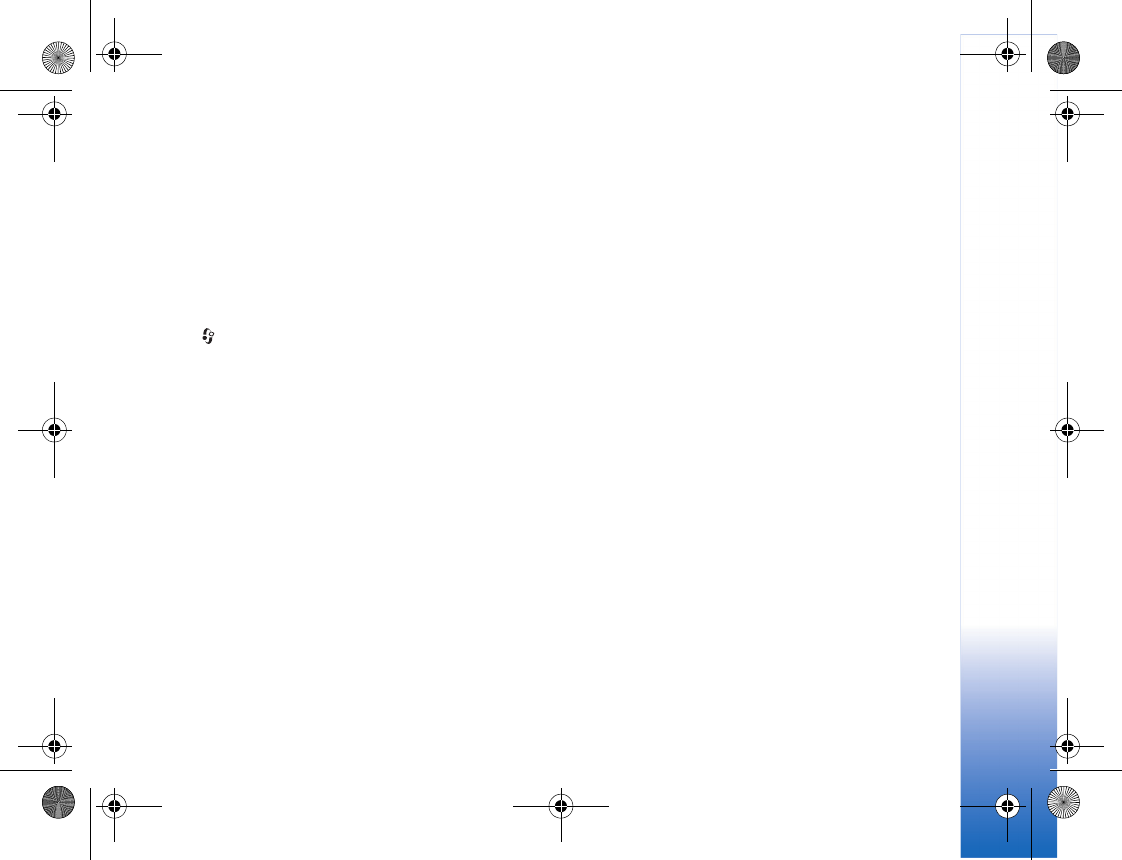
Messaging
65
Preferred conn.—Select the connection used for sending
text messages: GSM network or packet data, if supported
by the network. See "Connection," p. 102.
Reply via same ctr.—Select whether you want the reply
message to be sent using the same text message center
number (network service).
Multimedia messages
Press , and select Messag. > Options > Settings >
Multimedia message and from the following:
Image size—Define the size of the image in a multimedia
message: Original (shown only when the MMS creation
mode is set to Guided or Free), Small, or Large.
MMS creation mode —If you select Guided, the device
informs you if you try to send a message that may not be
supported by the recipient. If you select Restricted, the
device prevents you from sending messages that may not
be supported.
Access point in use—Select which access point is used as
the preferred connection for the multimedia message
center.
Multimedia retrieval—Select how you want to receive
multimedia messages. To retrieve new multimedia
messages automatically at all times, select Always
automatic. Outside your home network, you receive a
notification that there is a multimedia message that you
can retrieve in the multimedia message center.
If you select Multimedia retrieval > Always automatic,
your device automatically makes an active packet data
connection to retrieve the message both in and outside
your home network.
When you are outside your home network, sending and
receiving multimedia messages may cost you more.
Allow anon. msgs.—Select whether you want to reject
messages from an anonymous sender.
Receive ads—Define whether you want to receive
multimedia message advertisements.
Receive report—Select whether you want the status of
the sent message to be shown in the log (network service).
It may not be possible to receive a delivery report of a
multimedia message that has been sent to an e-mail
address.
Deny report sending—Select whether you want to deny
your device sending delivery reports of received
multimedia messages.
Message validity—Select how long the message center
resends your message if the first attempt fails (network
service). If the recipient cannot be reached within the
validity period, the message is deleted from the message
center.
R1114_en.book Page 65 Thursday, October 19, 2006 3:43 PM
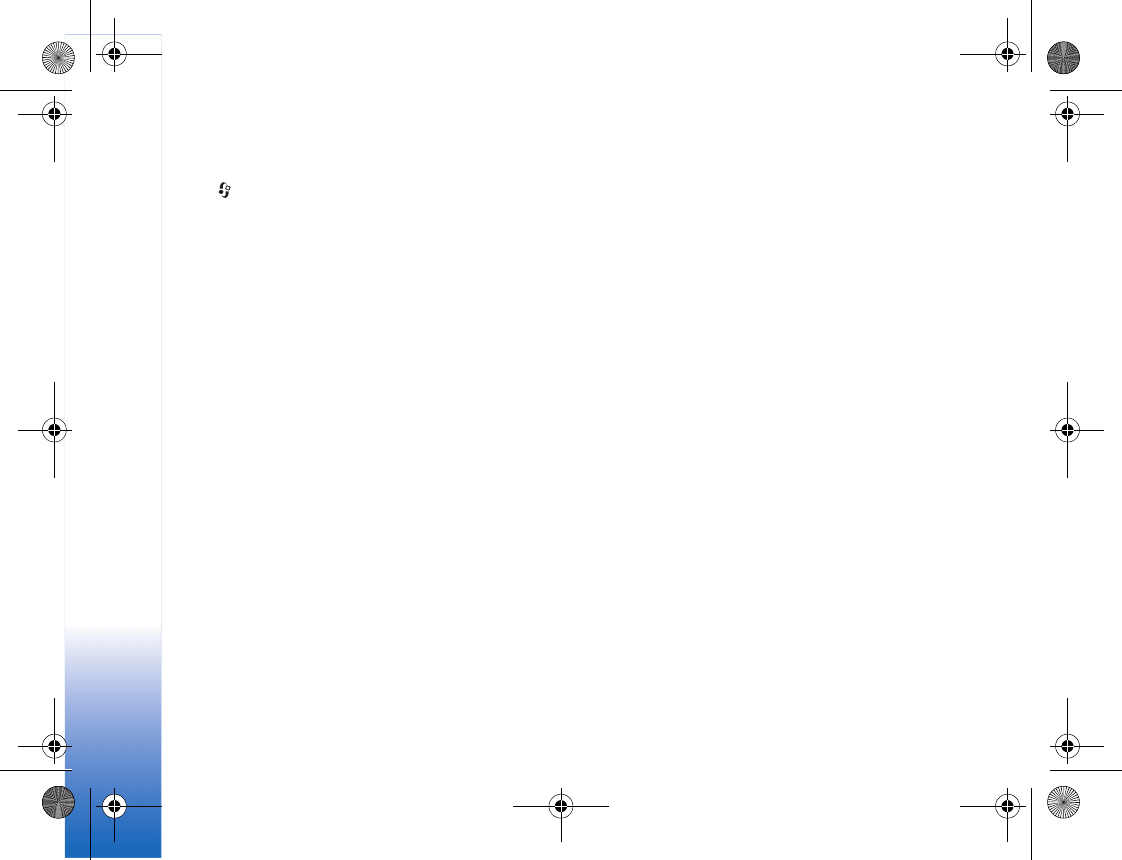
Messaging
66
E-mail
Press , and select Messag. > Options > Settings >
E-mail and from the following:
Mailboxes—Select a mailbox to change the following
settings: Connection settings, User settings, Retrieval
settings, and Automatic retrieval.
Mailbox in use— Select which mailbox you want to use
for sending e-mail.
To create a new mailbox, select Options > New mailbox
in the mailbox main view.
Connection settings
To edit the settings for the e-mail you receive, select
Incoming e-mail and from the following:
User name—Enter your user name, given to you by your
service provider.
Password—Enter your password. If you leave this field
blank, you are prompted for the password when you try to
connect to your remote mailbox.
Incoming mail serv.—Enter the IP address or host name of
the mail server that receives your e-mail.
Access point in use—Select an Internet access point (IAP).
See "Connection," p. 102.
Mailbox name—Enter a name for the mailbox.
Mailbox type—Defines the e-mail protocol that your
remote mailbox service provider recommends. The options
are POP3 and IMAP4. This setting can be selected only
once and cannot be changed if you have saved or exited
from the mailbox settings. If you use the POP3 protocol,
e-mail messages are not updated automatically when you
are online: to see the latest e-mail messages, you must
disconnect and make a new connection to your mailbox.
Security (ports)—Select the security option used to secure
the connection to the remote mailbox.
Port—Define a port for the connection.
APOP secure login (for POP3 only)—Use with the POP3
protocol to encrypt the sending of passwords to the
remote e-mail server while connecting to the mailbox.
To edit the settings for the e-mail you send, select
Outgoing e-mail and from the following:
My e-mail address—Enter the e-mail address given to you
by your service provider. Replies to your messages are sent
to this address.
Outgoing mail serv.—Enter the IP address or host name of
the mail server that sends your e-mail. You may only be
able to use the outgoing server of your network operator.
Contact your service provider for more information.
Access point in use—Select an Internet access point (IAP).
See "Connection," p. 102.
R1114_en.book Page 66 Thursday, October 19, 2006 3:43 PM
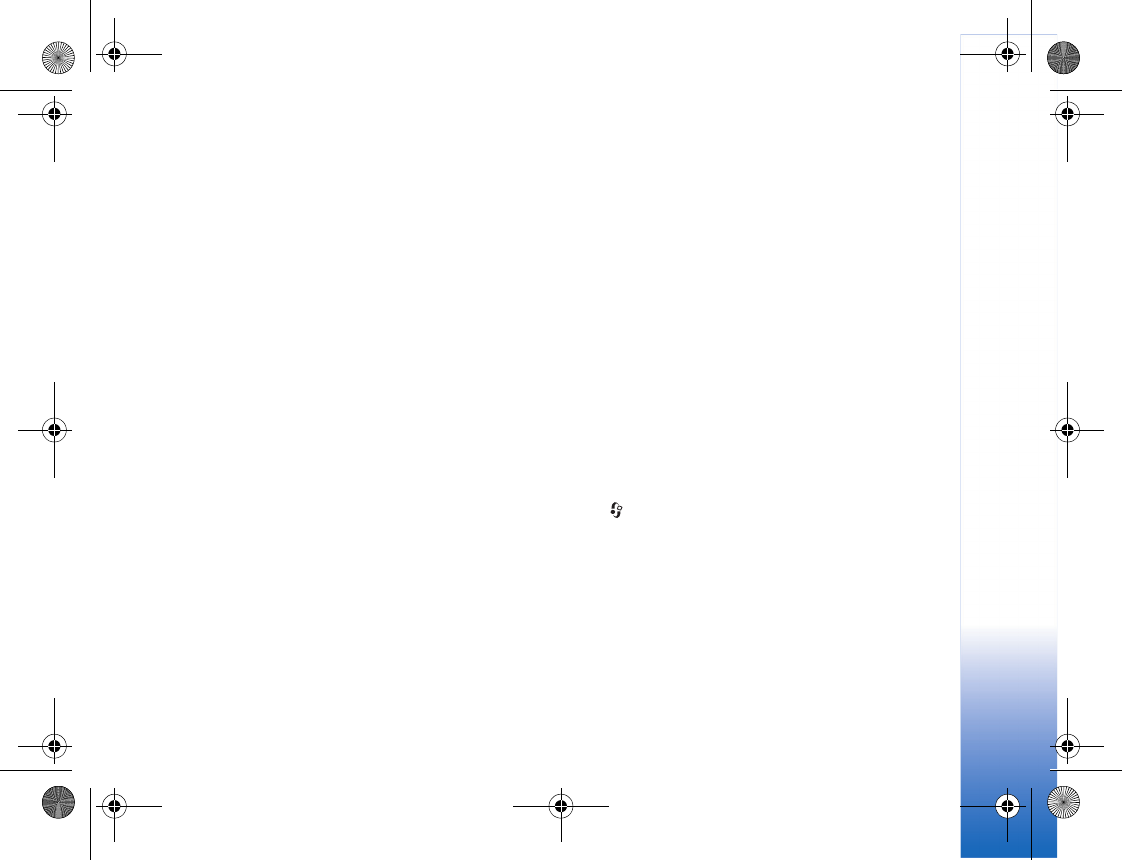
Messaging
67
The settings for User name, Password, Security (ports),
and Port are similar to the ones in Incoming e-mail.
User settings
My name—Enter your own name. Your name replaces your
e-mail address in the recipient’s device when the
recipient’s device supports this function.
Send message—Define how e-mail is sent from your
device. Select Immediately for the device to connect to the
mailbox when you select Send message. If you select
During next conn., e-mail is sent when the connection to
the remote mailbox is available.
Send copy to self—Select whether you want to save a
copy of the e-mail to your remote mailbox and to the
address defined in My e-mail address.
Include signature—Select whether you want to attach a
signature to your e-mail messages.
New e-mail alerts—Select whether you want to receive
the new e-mail indications, a tone and a note, when new
mail is received to the mailbox.
Retrieval settings
E-mail to retrieve—Define which parts of the e-mail are
retrieved: Headers only, Partially (kB), Messages (for
IMAP4 only), or Msgs. & attachs..
Retrieval amount—Define how many new e-mail
messages are retrieved to the mailbox.
IMAP4 folder path (for IMAP4 only)—Define the folder
path for folders to be subscribed.
Folder subscriptions (for IMAP4 only)—Subscribe to other
folders in the remote mailbox and retrieve content from
those folders.
Automatic retrieval
Header retrieval—Select whether you want the device to
retrieve new e-mail automatically. You can define when
and how often the messages are retrieved.
Retrieving e-mail messages automatically may increase
your call costs due to the data traffic.
Web service messages
Press , and select Messaging > Options > Settings >
Service message. Select whether you want to receive
service messages. If you want to set the device to
automatically activate the browser and start a network
connection to retrieve content when you receive a service
message, select Download messages > Automatically.
R1114_en.book Page 67 Thursday, October 19, 2006 3:43 PM
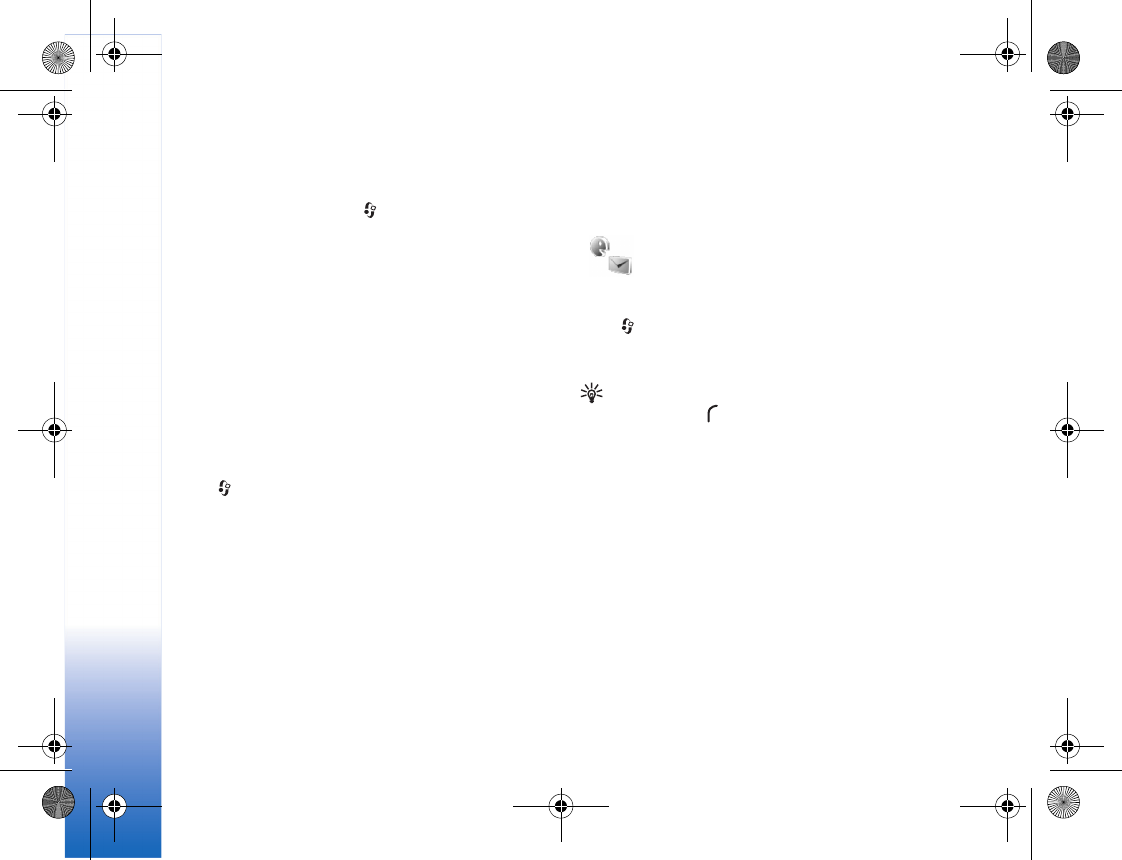
Messaging
68
Cell broadcast
Check the available topics and related topic numbers with
your service provider. Press , and select Messaging >
Options > Settings > Cell broadcast and from the
following:
Reception—Select whether you want to receive cell
broadcast messages.
Language—Select the languages in which you want to
receive messages: All, Selected, or Other.
Topic detection—Select whether the device
automatically searches for new topic numbers, and saves
the new numbers without a name to the topic list.
Other settings
Press , and select Messaging > Options > Settings >
Other and from the following:
Save sent messages—Select whether you want to save a
copy of the text messages, multimedia messages, or e-
mail that you send to the Sent folder.
No. of saved msgs.—Define how many sent messages are
saved to the Sent folder at a time. The default limit is 20
messages. When the limit is reached, the oldest message
is deleted.
Memory in use—If a compatible memory card is inserted
in the device, select the memory where you want to save
your messages: Phone memory or Memory card.
Message reader
With Msg. reader, you can listen to text
messgaes in the Inbox.
Press , and select Settings > Msg. reader. To listen to
text messages, scroll right to choose the message from
which to start reading, and select Play.
Tip! To listen to a text message you have received,
press and hold until Msg. reader starts.
R1114_en.book Page 68 Thursday, October 19, 2006 3:43 PM